Content Governance Ensuring sustainable content success Hilary Marsh Content Company, Inc. January 2025
A presentation at Content Governance webinar in January 2025 in by Hilary Marsh

Content Governance Ensuring sustainable content success Hilary Marsh Content Company, Inc. January 2025
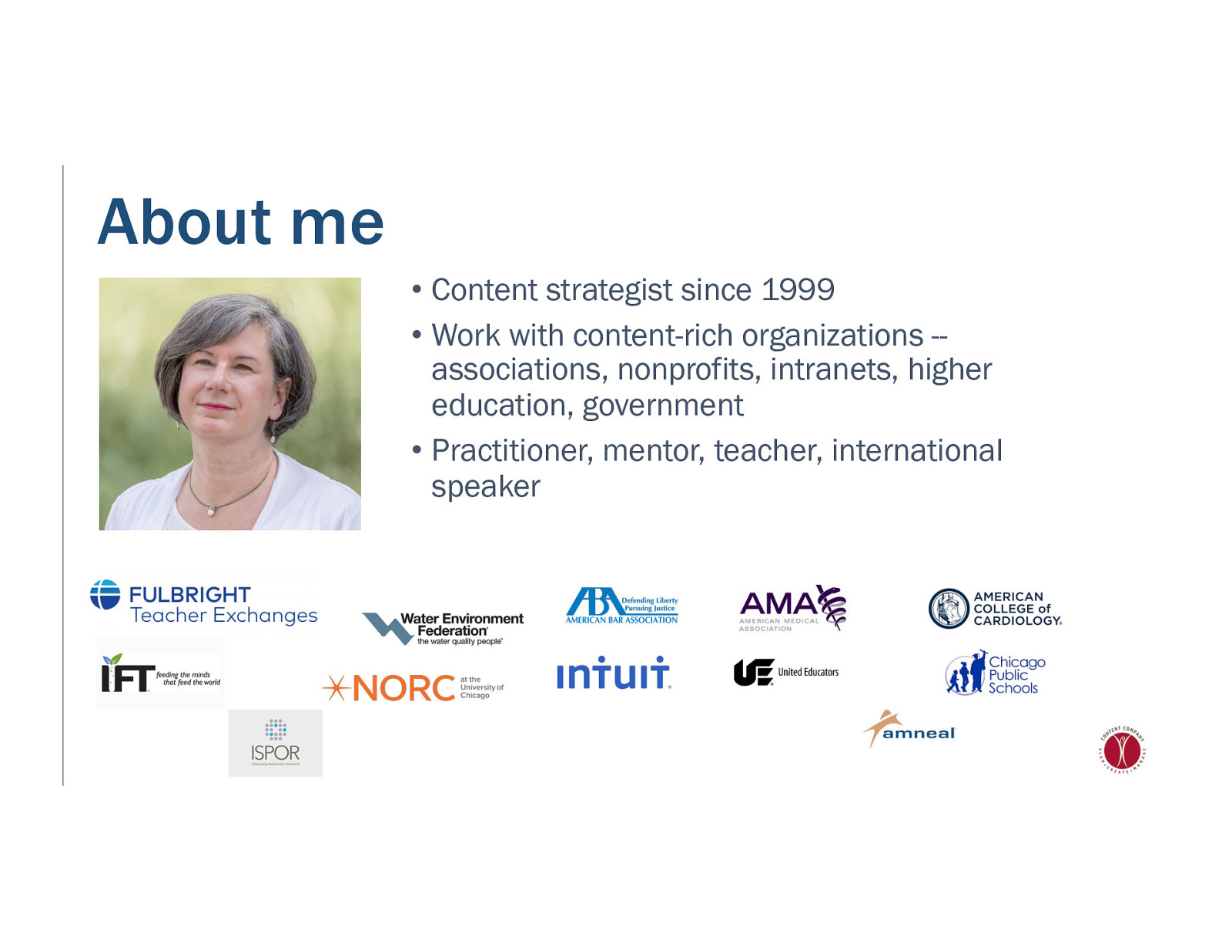
About me • Content strategist since 1999 • Work with content-rich organizations -associations, nonprofits, intranets, higher education, government • Practitioner, mentor, teacher, international speaker
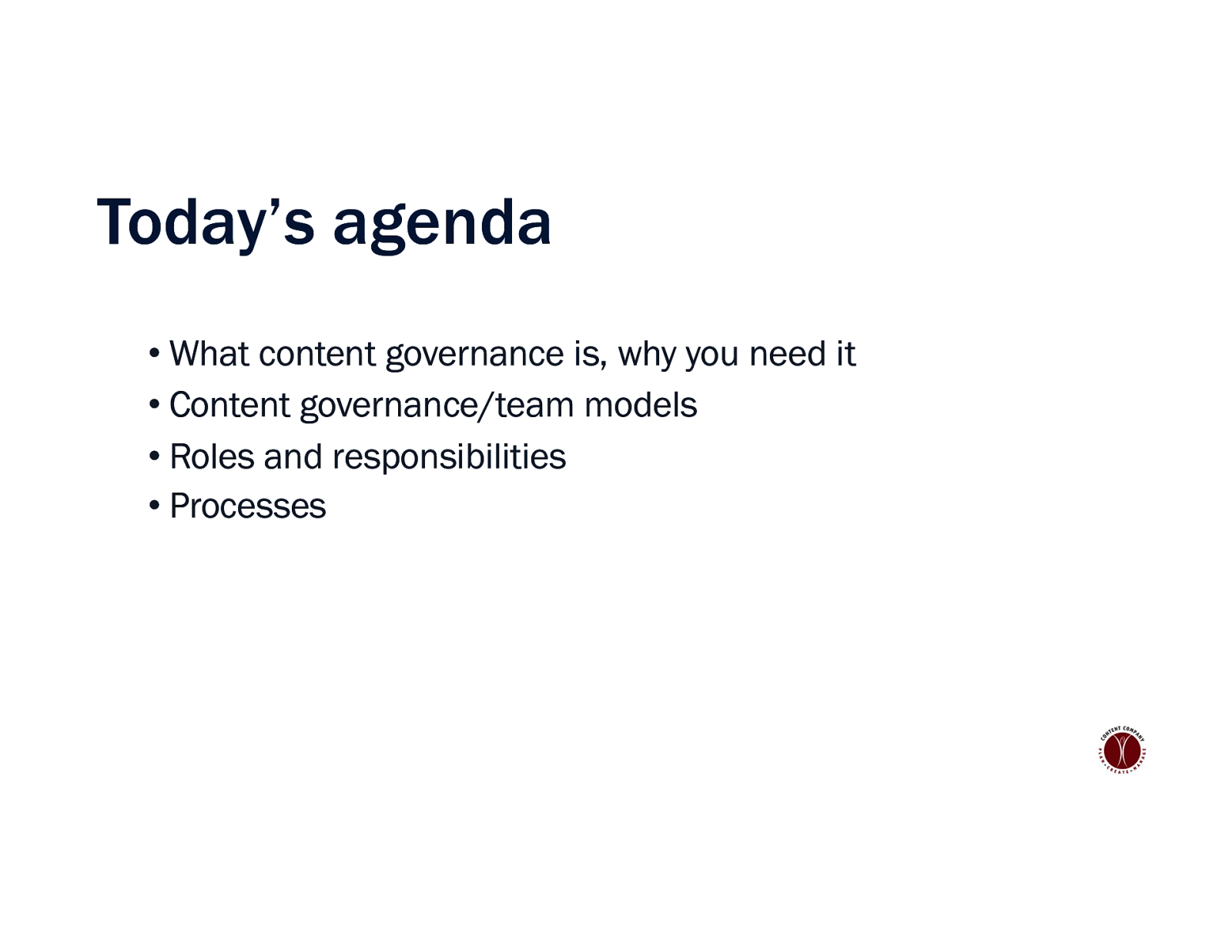
Today’s agenda • What content governance is, why you need it • Content governance/team models • Roles and responsibilities • Processes
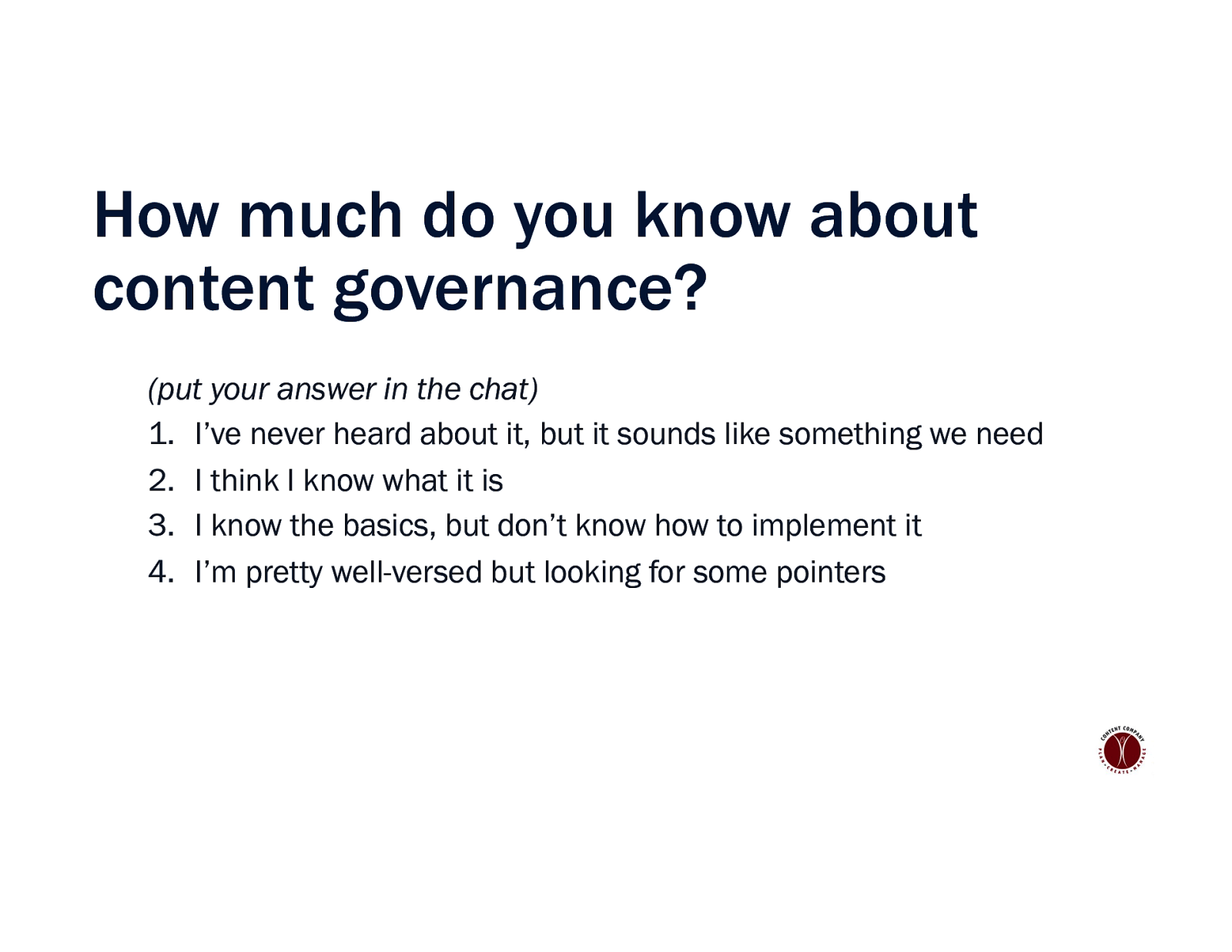
How much do you know about content governance? (put your answer in the chat) 1. I’ve never heard about it, but it sounds like something we need 2. I think I know what it is 3. I know the basics, but don’t know how to implement it 4. I’m pretty well-versed but looking for some pointers
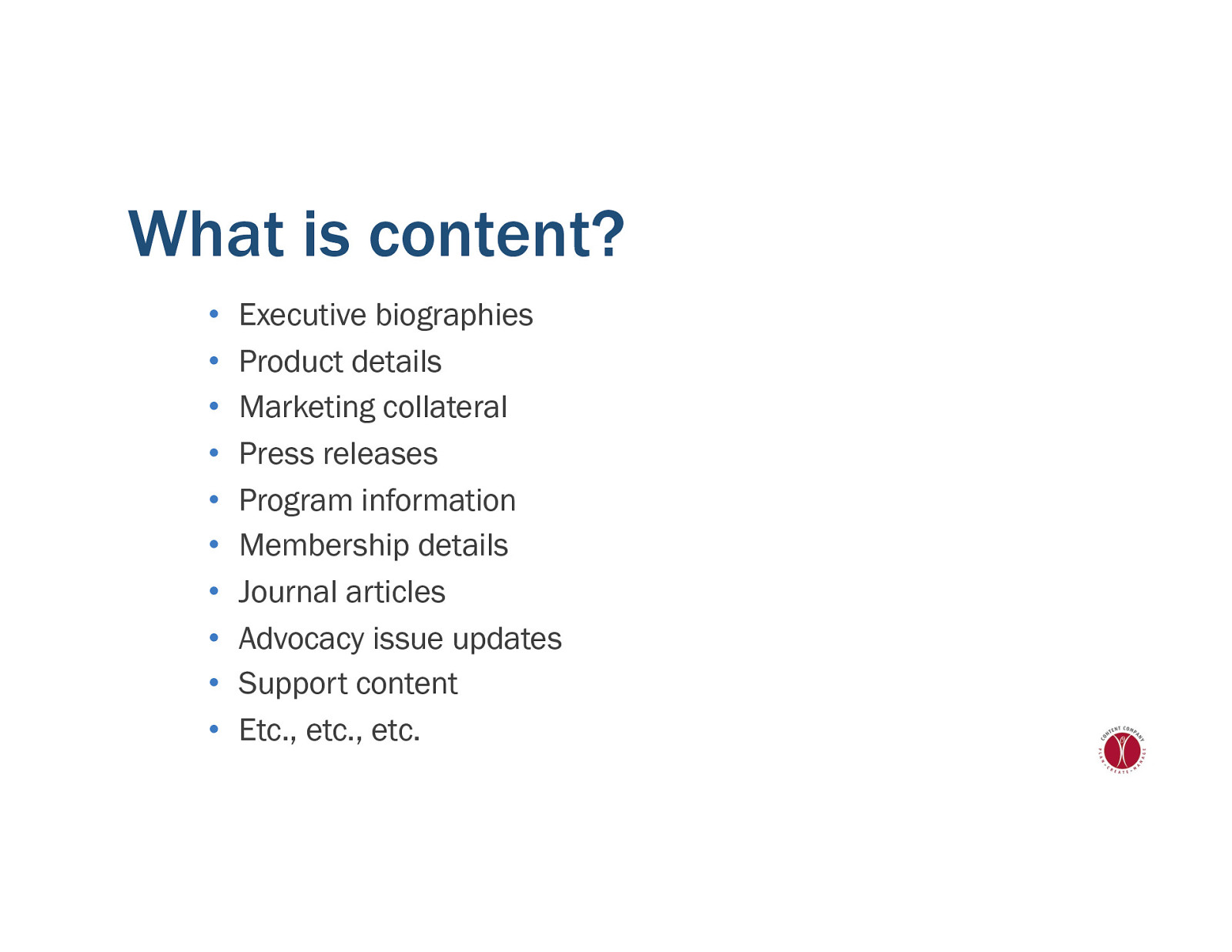
What is content? • • • • • • • • • • Executive biographies Product details Marketing collateral Press releases Program information Membership details Journal articles Advocacy issue updates Support content Etc., etc., etc.
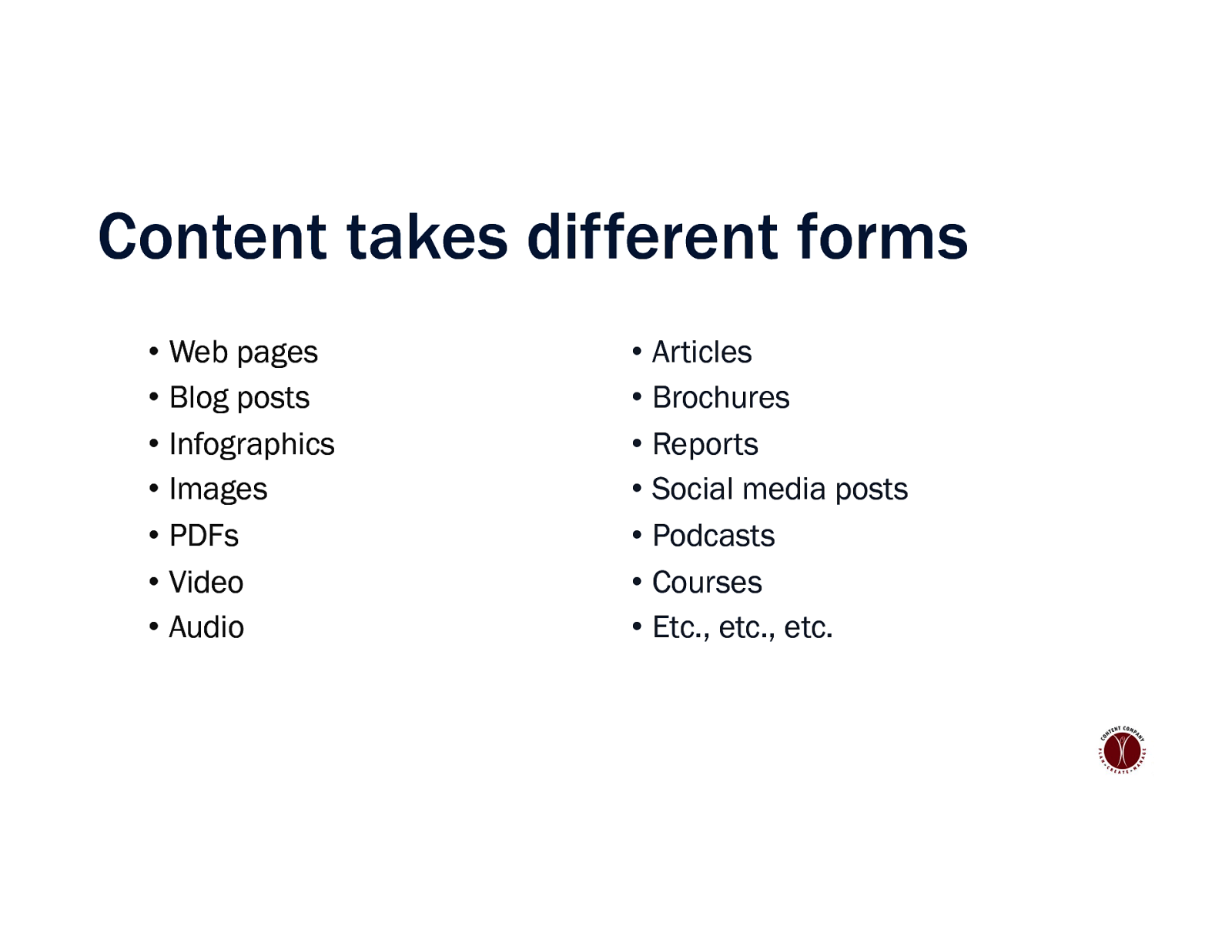
Content takes different forms • Web pages • Blog posts • Infographics • Images • PDFs • Video • Audio • Articles • Brochures • Reports • Social media posts • Podcasts • Courses • Etc., etc., etc.
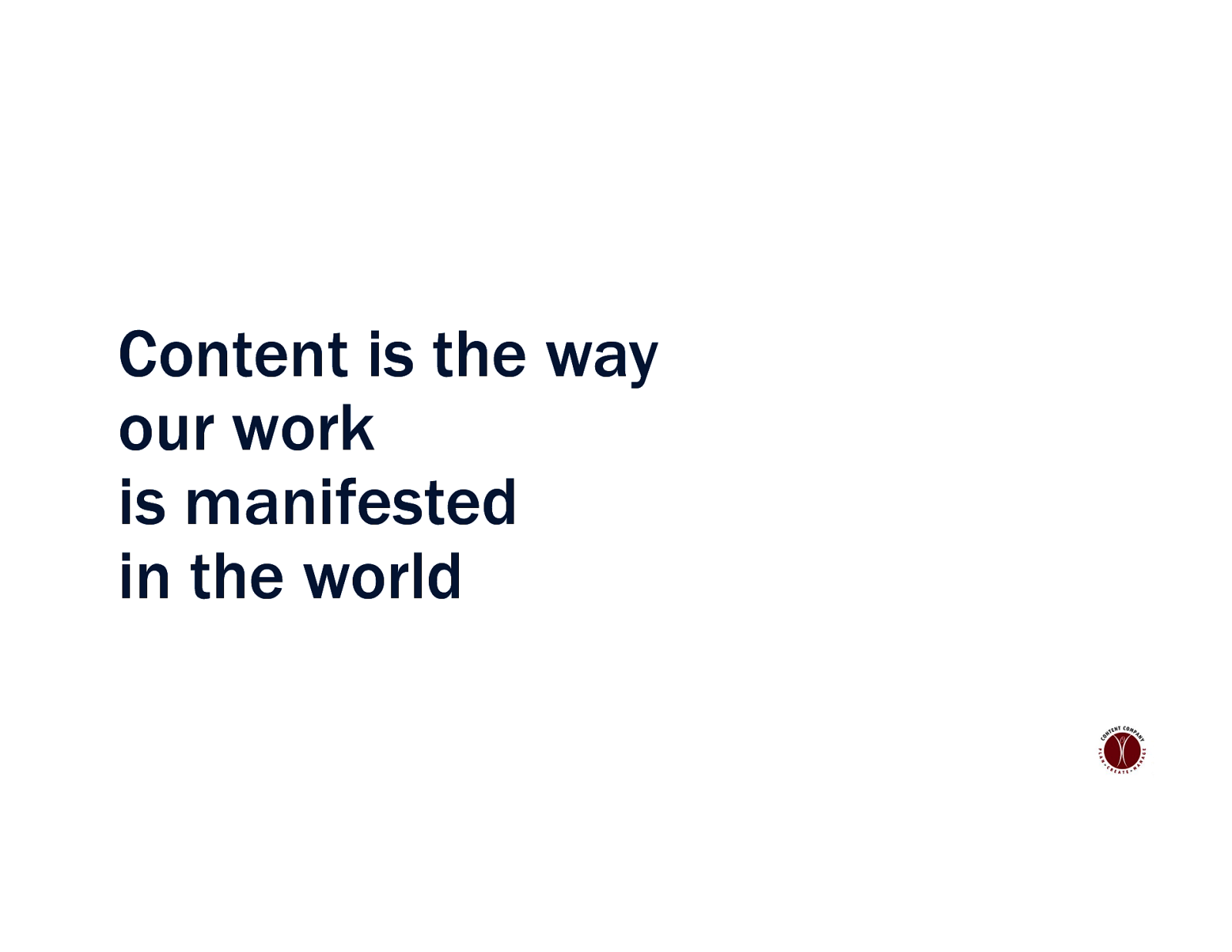
Content is the way our work is manifested in the world
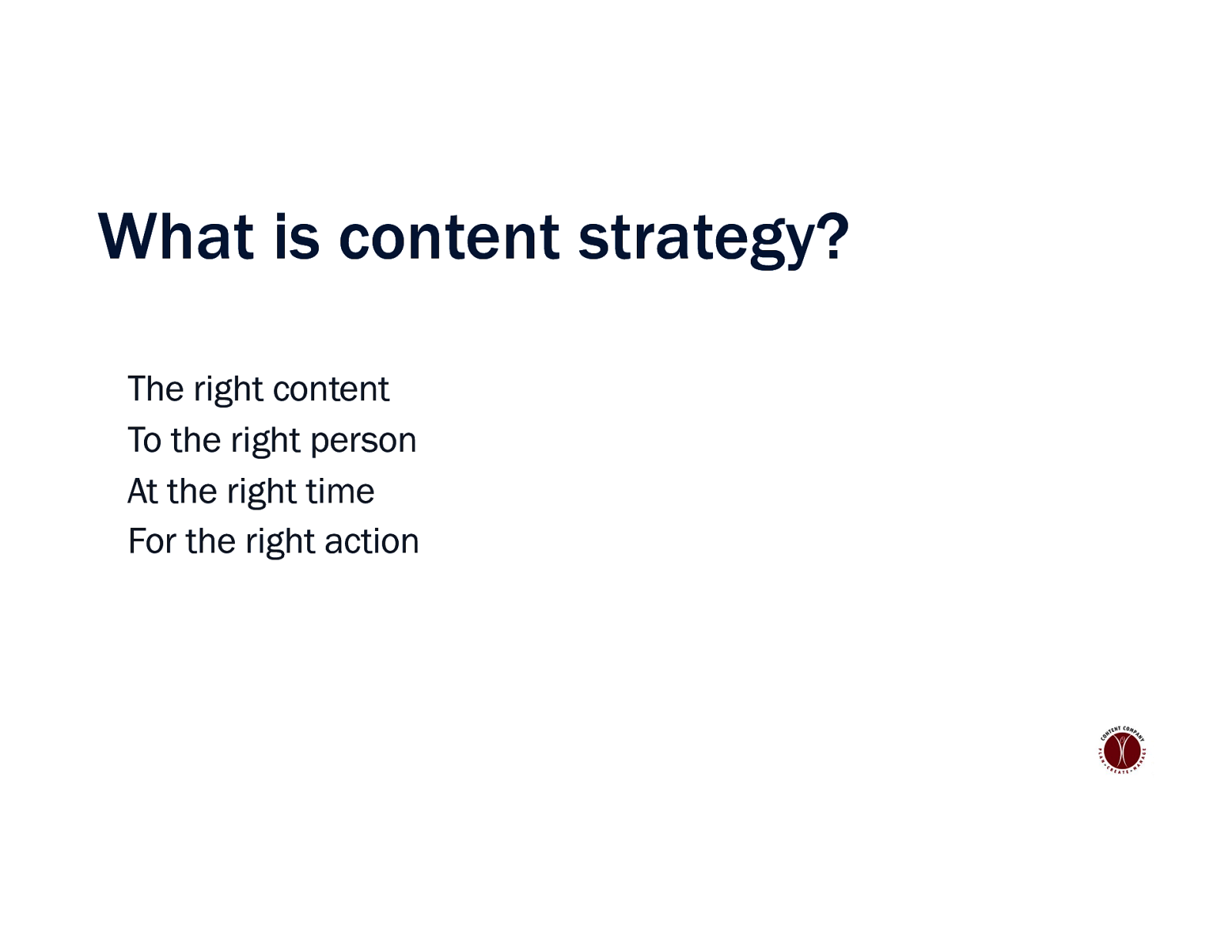
What is content strategy? The right content To the right person At the right time For the right action
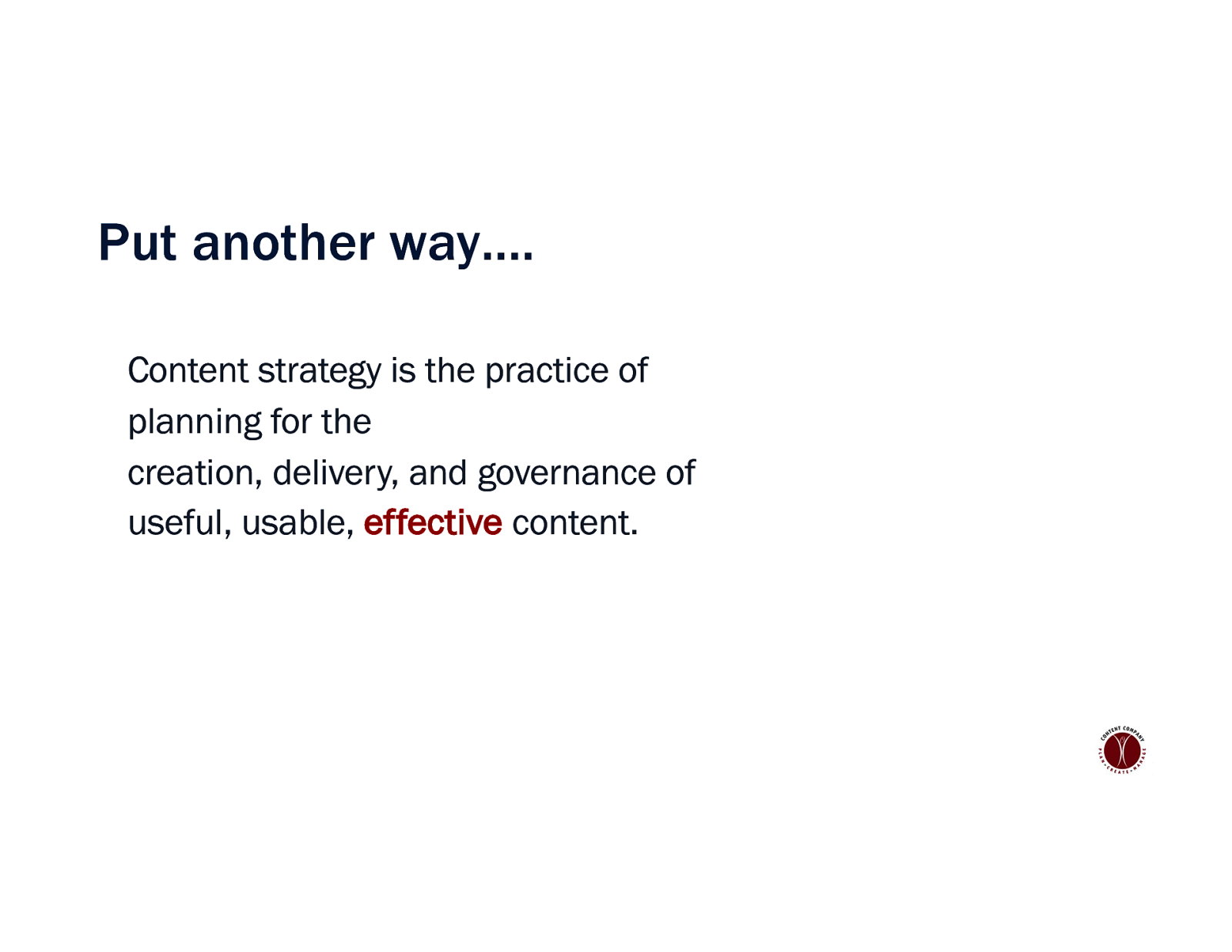
Put another way…. Content strategy is the practice of planning for the creation, delivery, and governance of useful, usable, effective content.

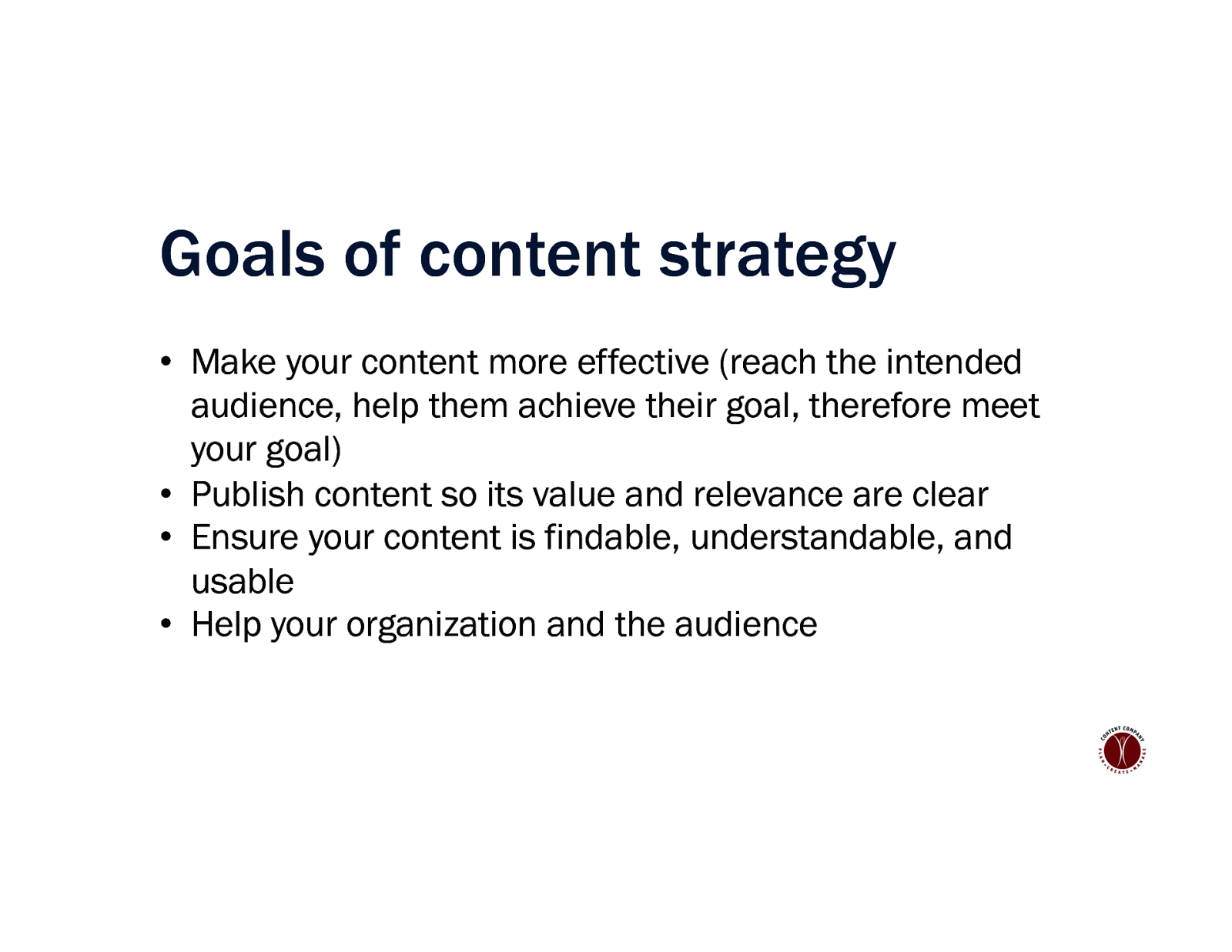
Goals of content strategy • Make your content more effective (reach the intended audience, help them achieve their goal, therefore meet your goal) • Publish content so its value and relevance are clear • Ensure your content is findable, understandable, and usable • Help your organization and the audience
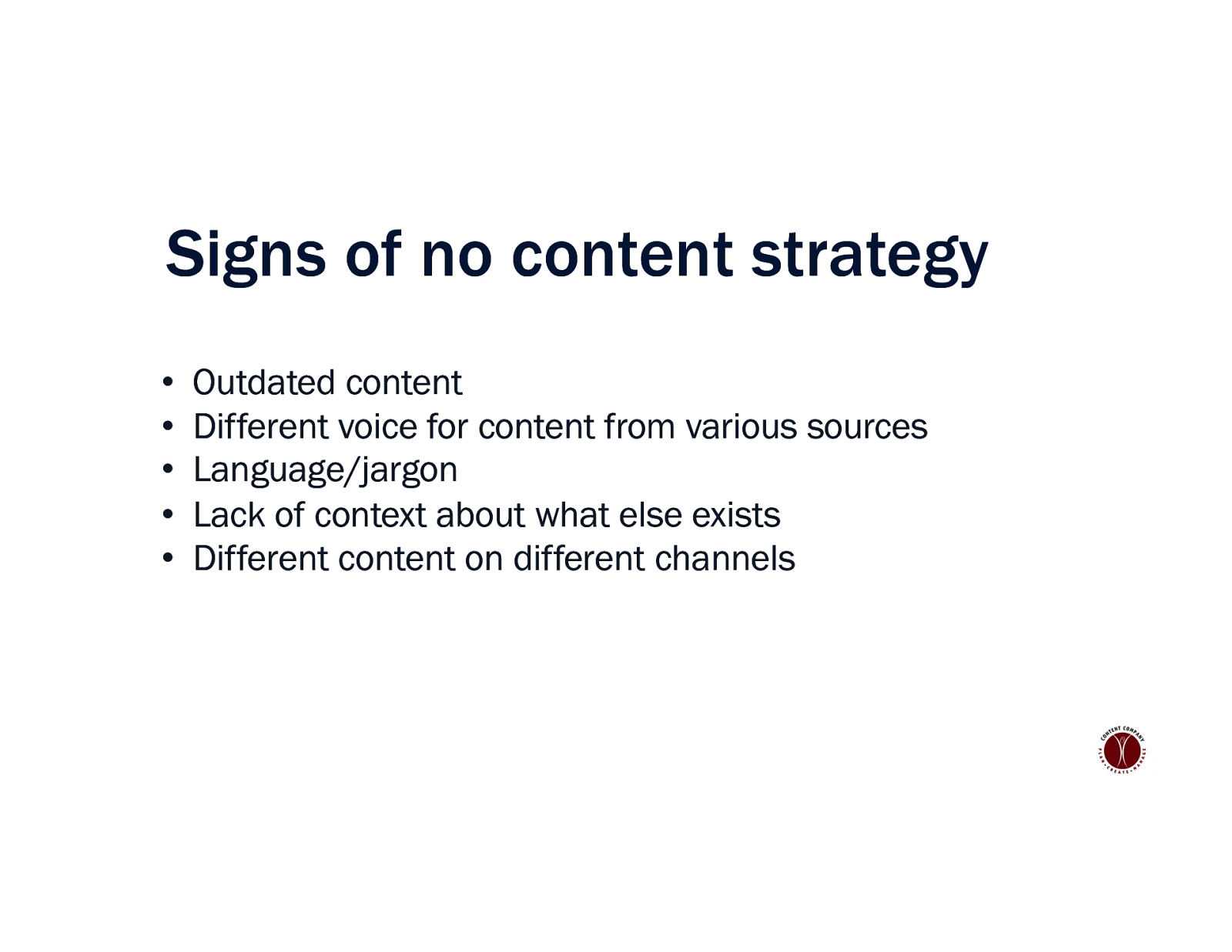
Signs of no content strategy • • • • • Outdated content Different voice for content from various sources Language/jargon Lack of context about what else exists Different content on different channels
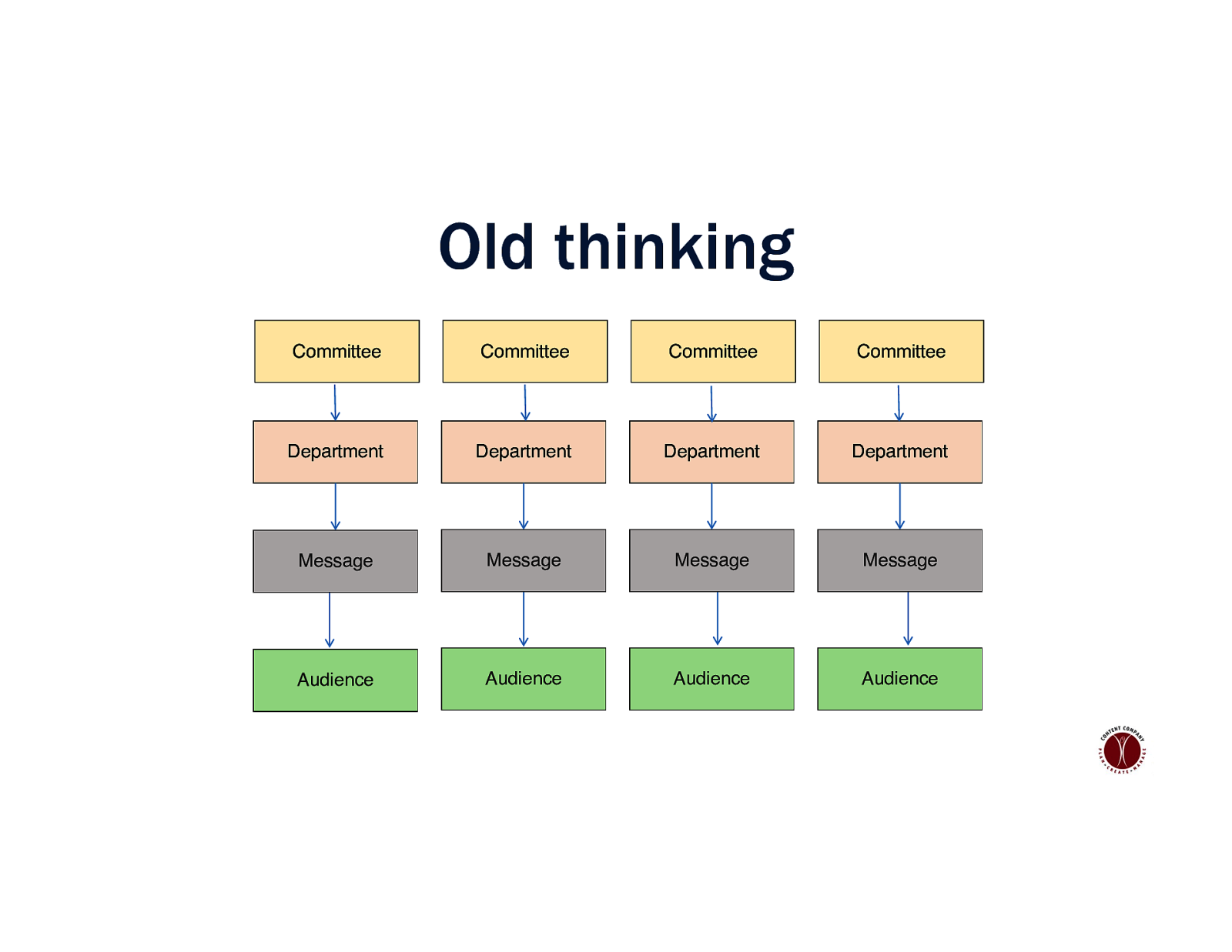
Old thinking Committee Committee Committee Committee Department Department Department Department Message Message Message Message Audience Audience Audience Audience
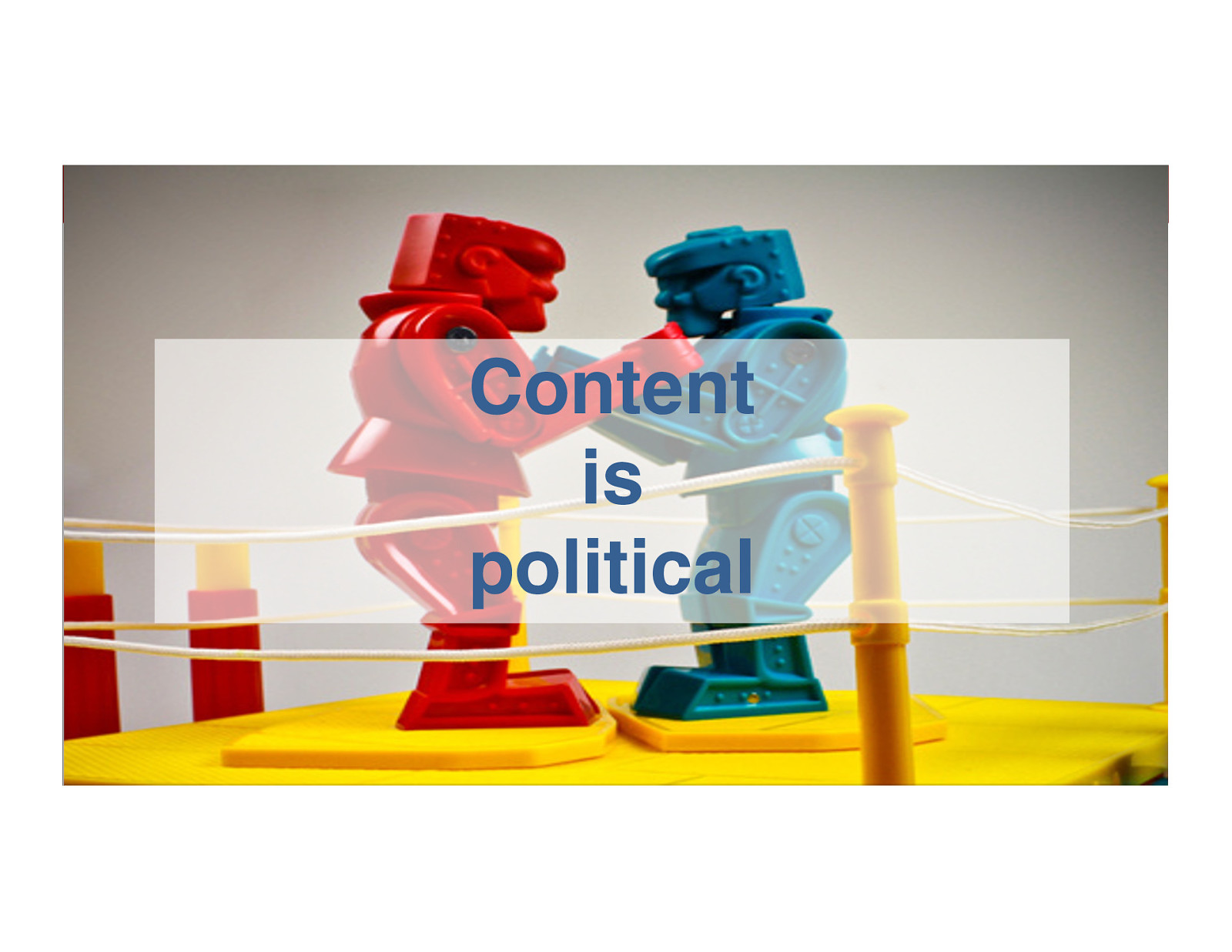
Content is political
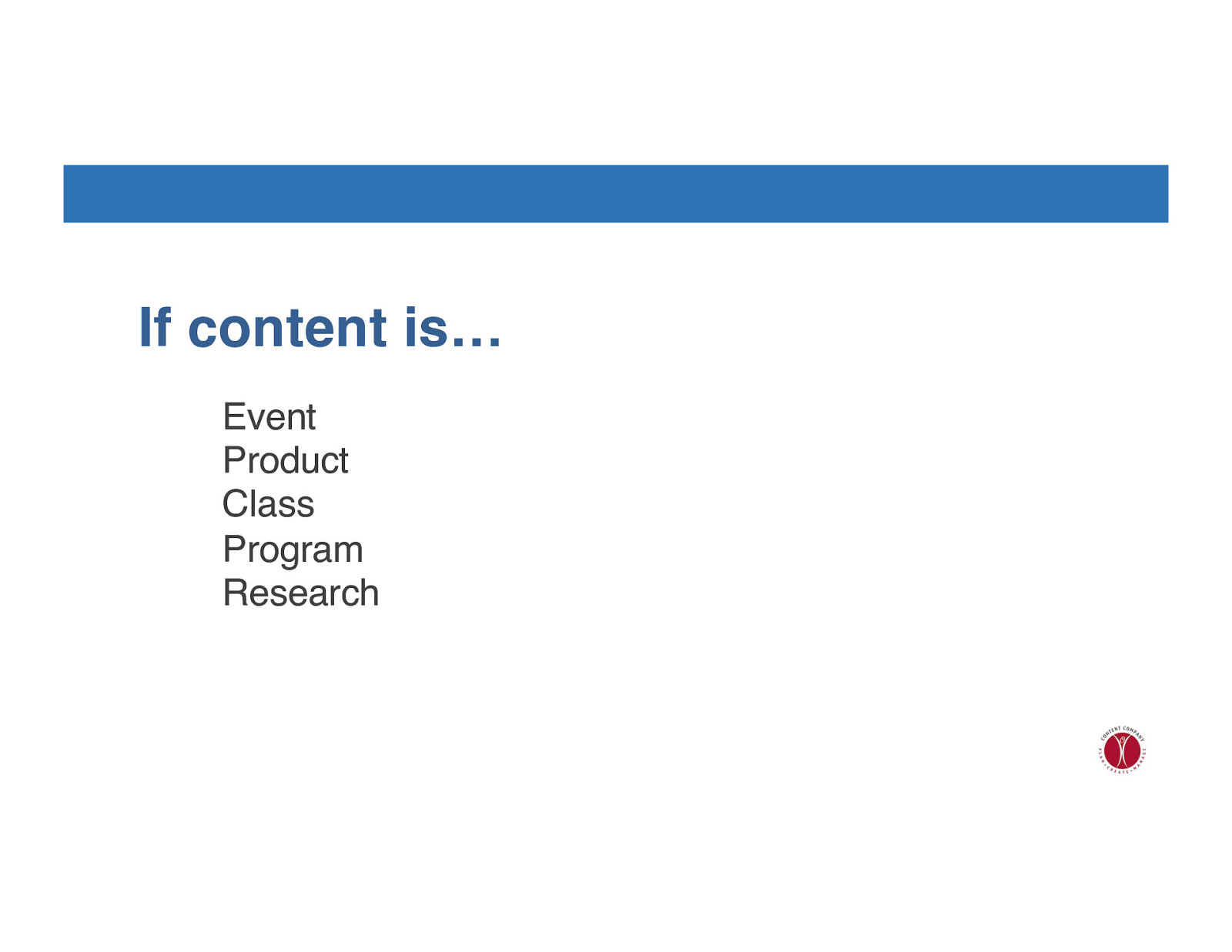
If content is… Event Product Class Program Research
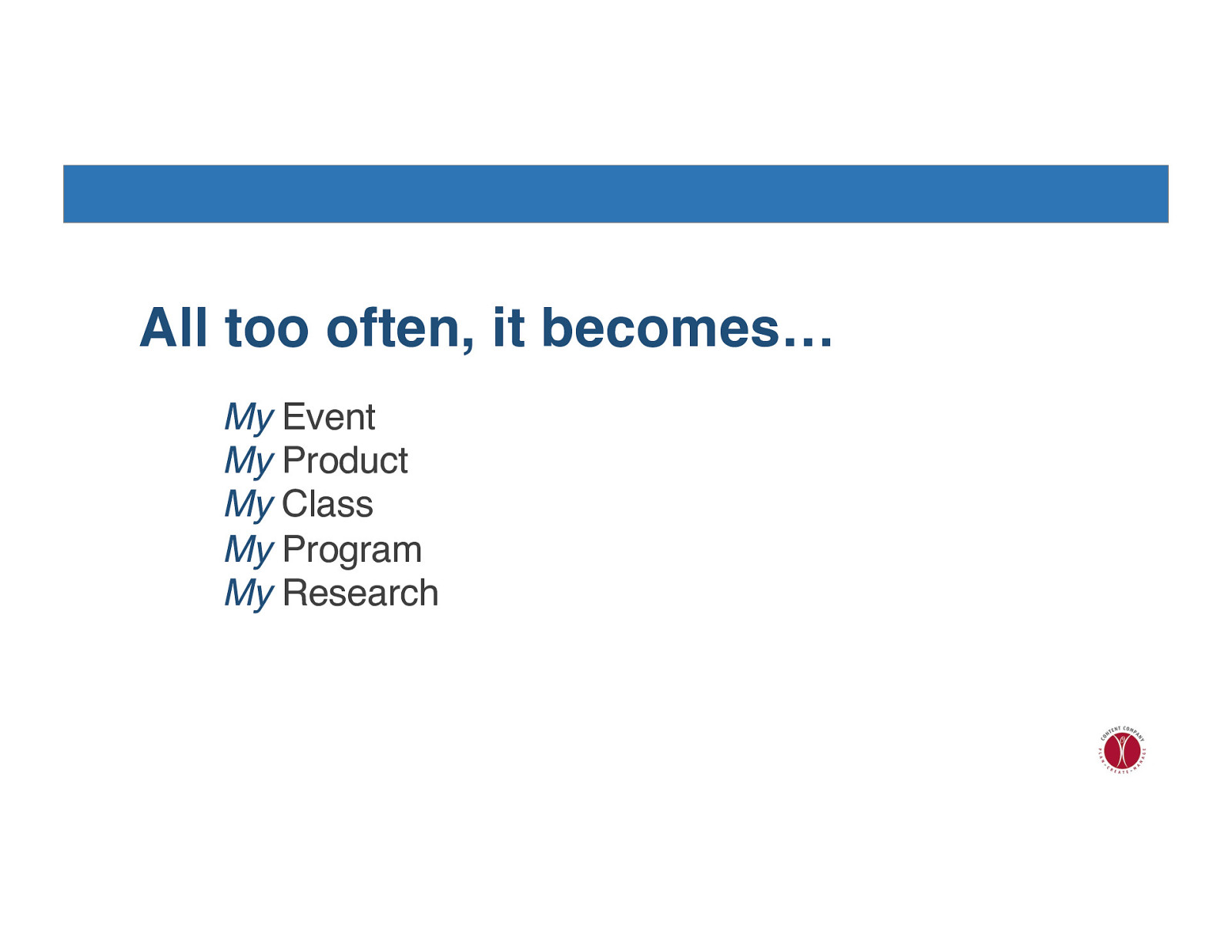
All too often, it becomes… My Event My Product My Class My Program My Research

17
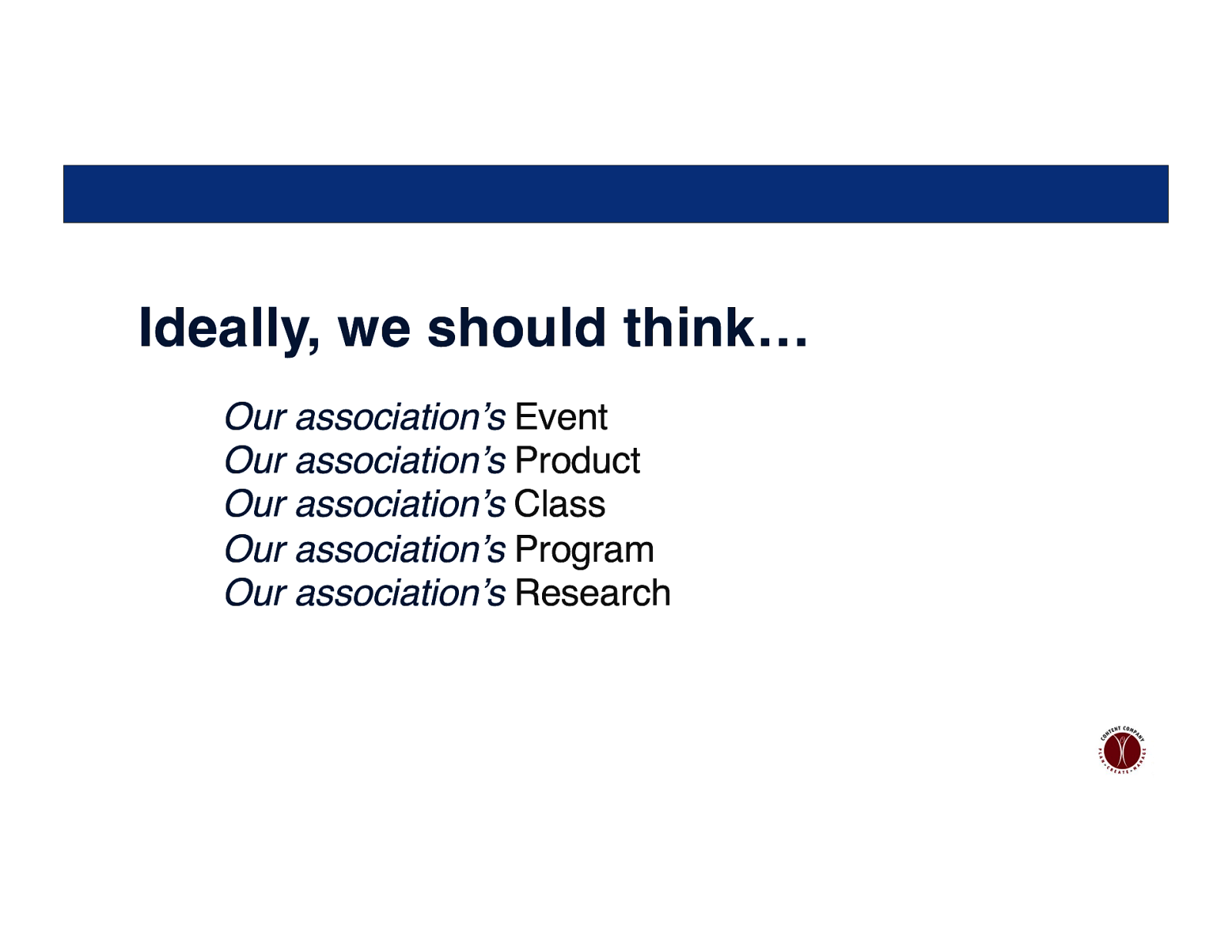
Ideally, we should think… Our association’s Event Our association’s Product Our association’s Class Our association’s Program Our association’s Research
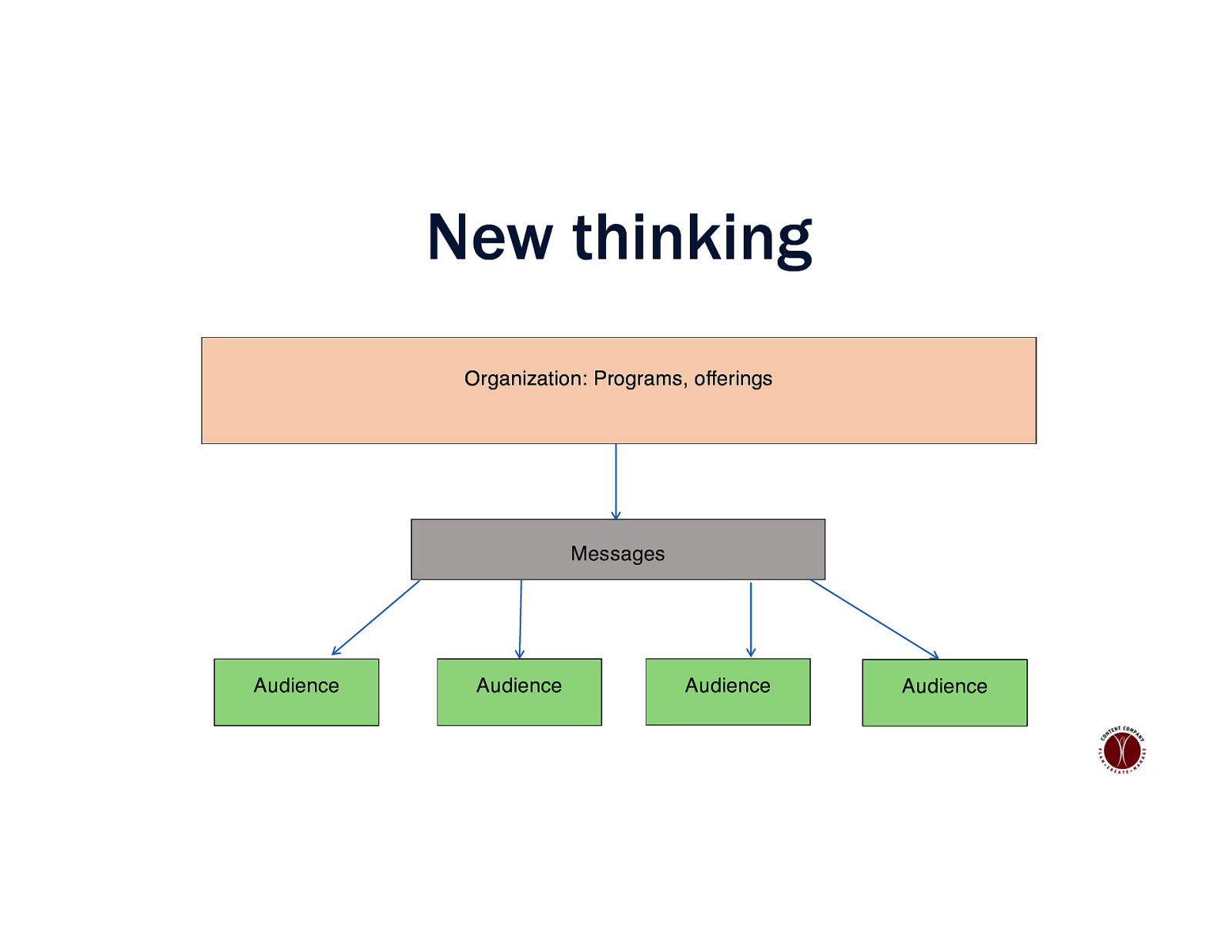
New thinking Organization: Programs, offerings Messages Audience Audience Audience Audience
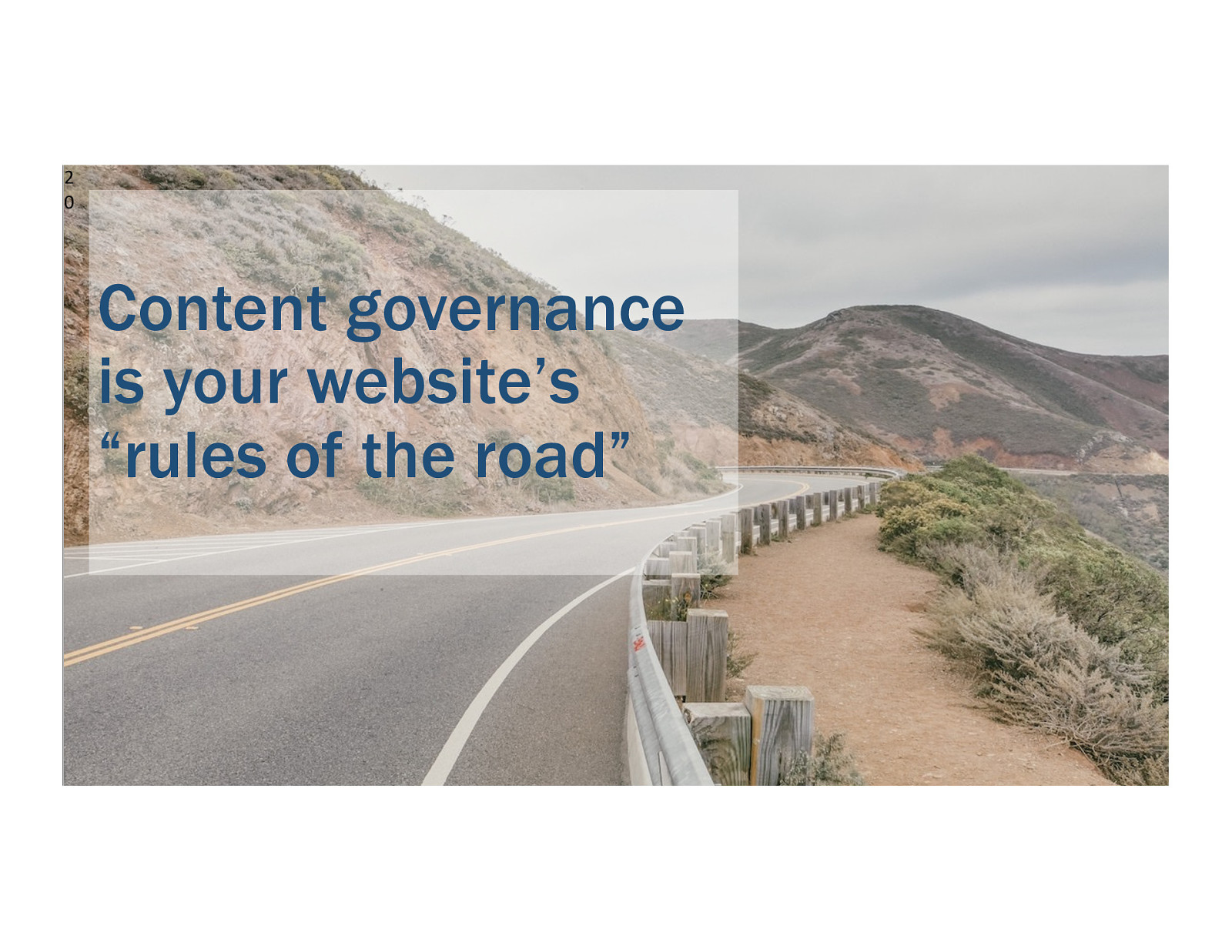
2 0 Content governance is your website’s “rules of the road”
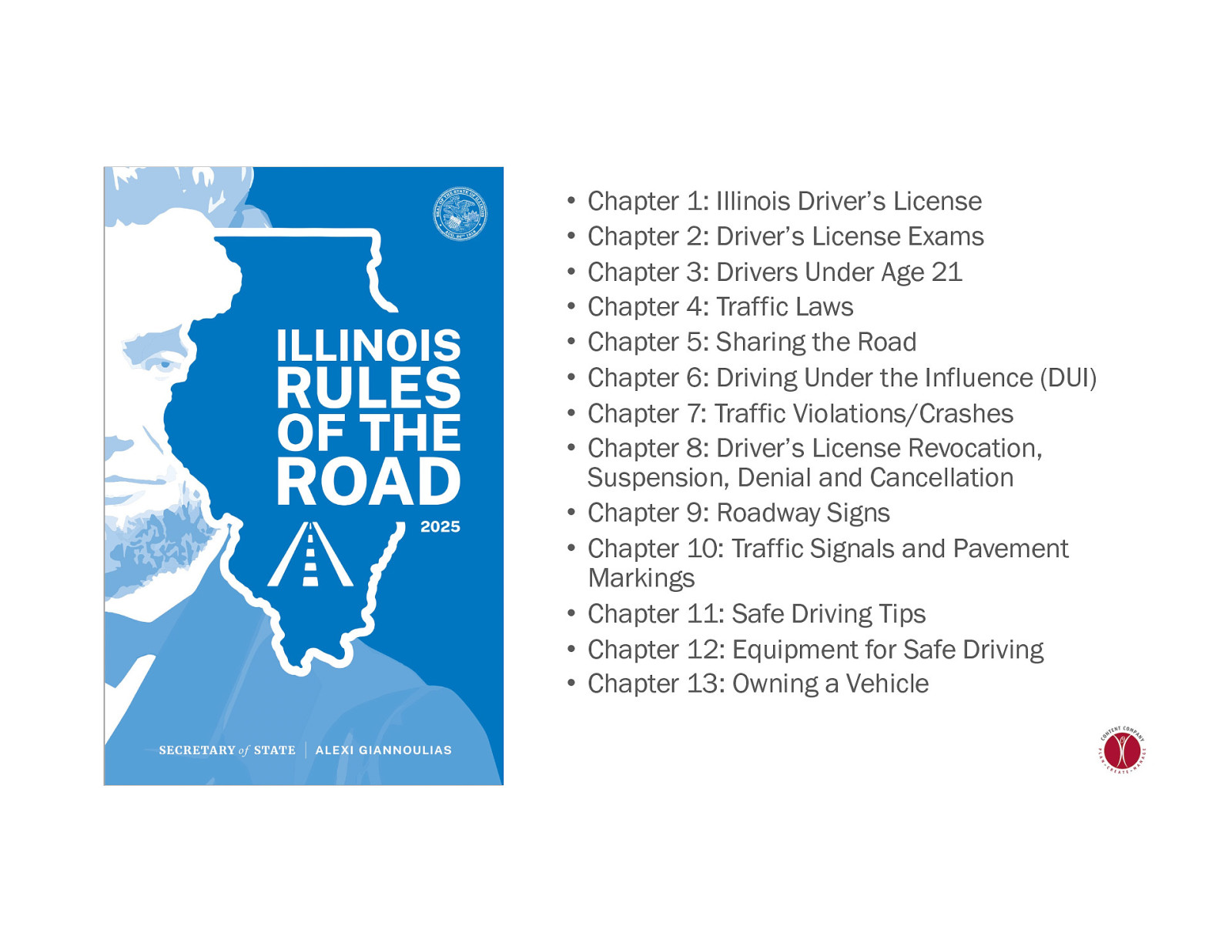
• • • • • • • • • • • • • Chapter 1: Illinois Driver’s License Chapter 2: Driver’s License Exams Chapter 3: Drivers Under Age 21 Chapter 4: Traffic Laws Chapter 5: Sharing the Road Chapter 6: Driving Under the Influence (DUI) Chapter 7: Traffic Violations/Crashes Chapter 8: Driver’s License Revocation, Suspension, Denial and Cancellation Chapter 9: Roadway Signs Chapter 10: Traffic Signals and Pavement Markings Chapter 11: Safe Driving Tips Chapter 12: Equipment for Safe Driving Chapter 13: Owning a Vehicle
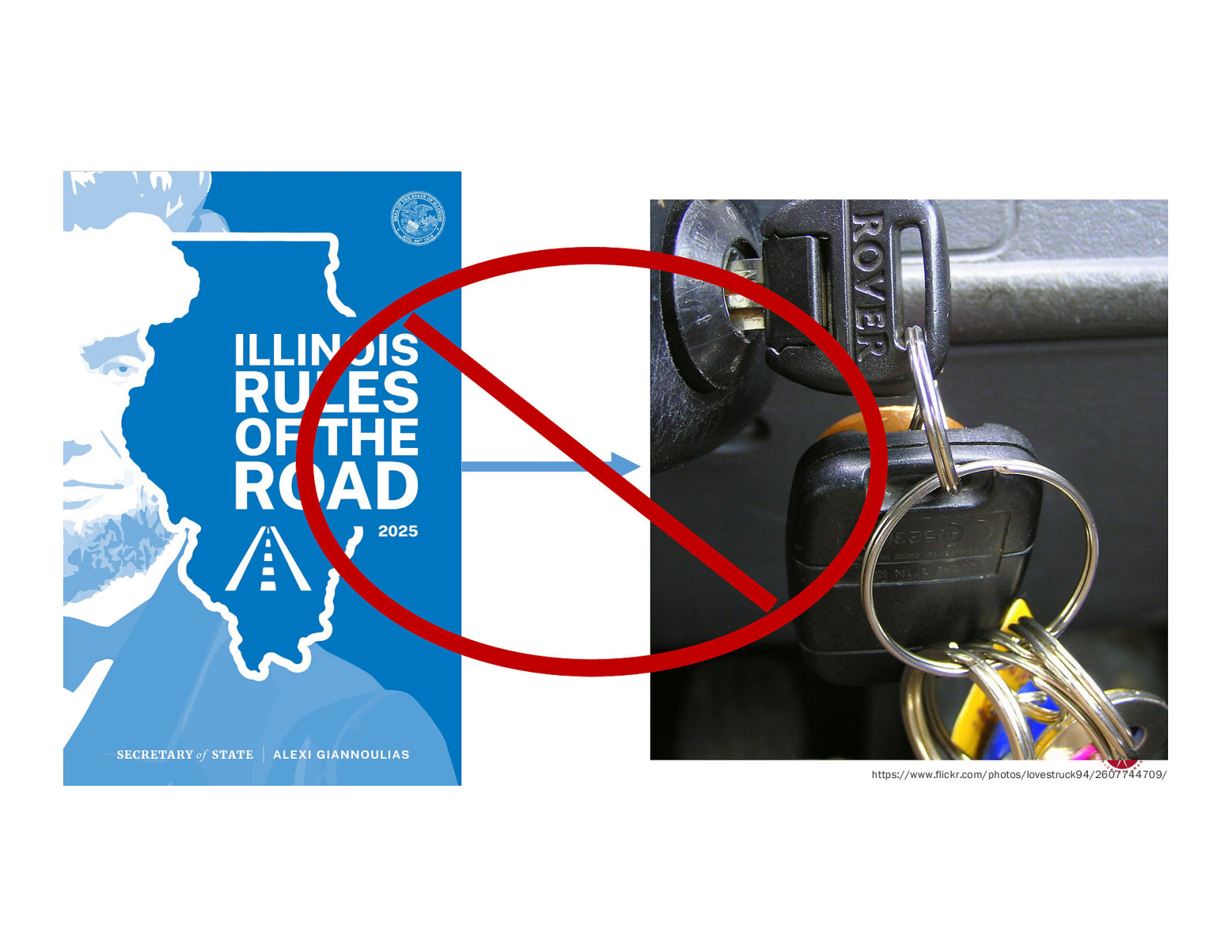
https://www.flickr.com/photos/lovestruck94/2607744709/
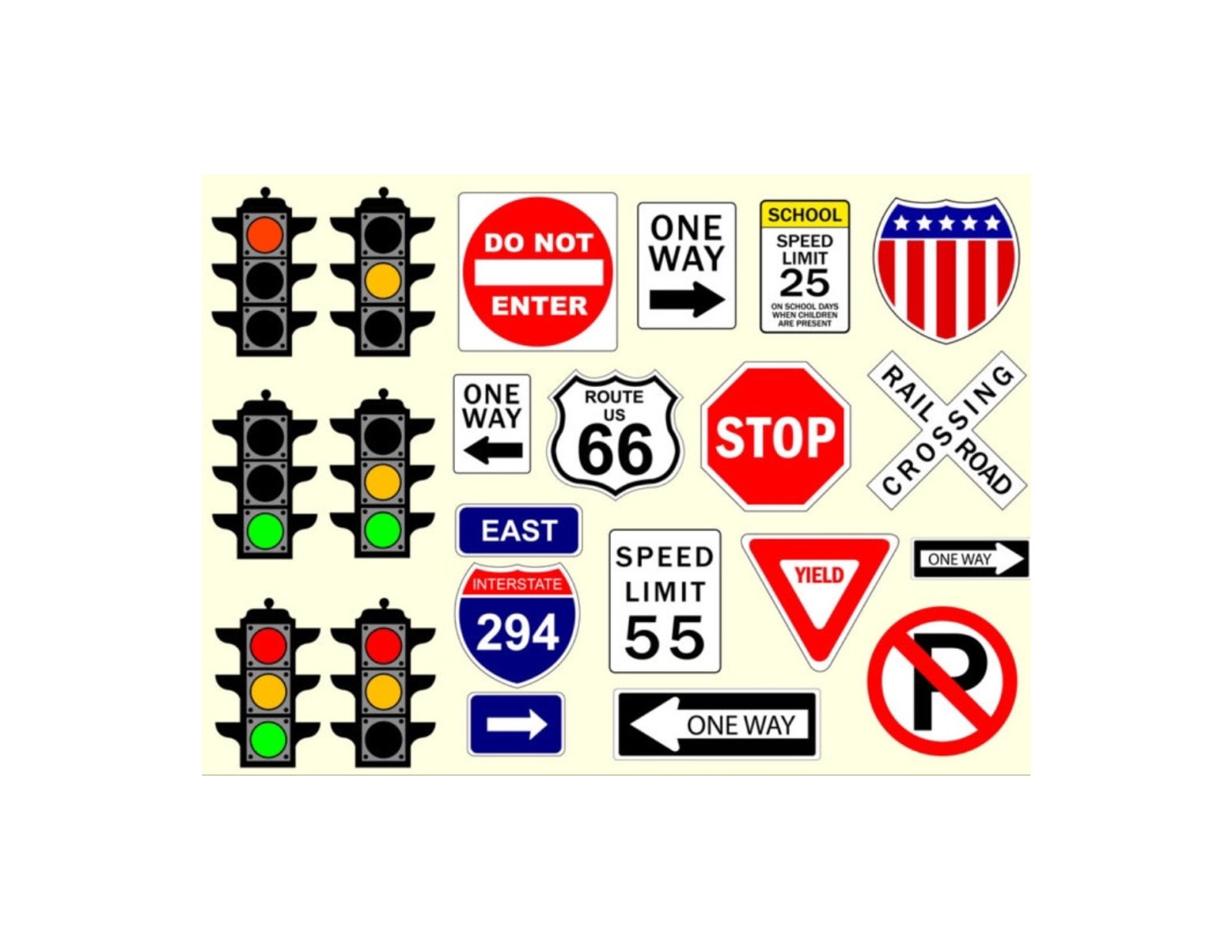
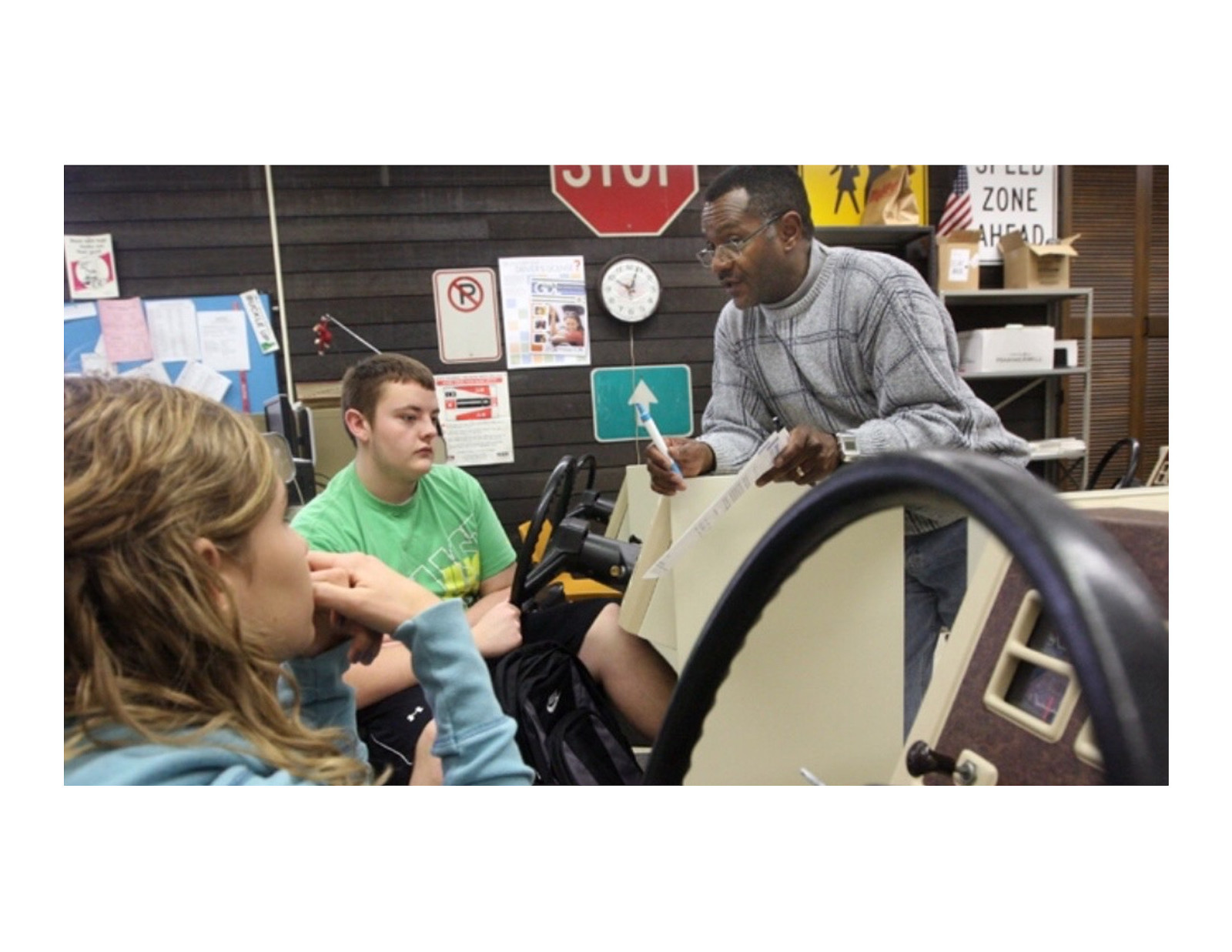
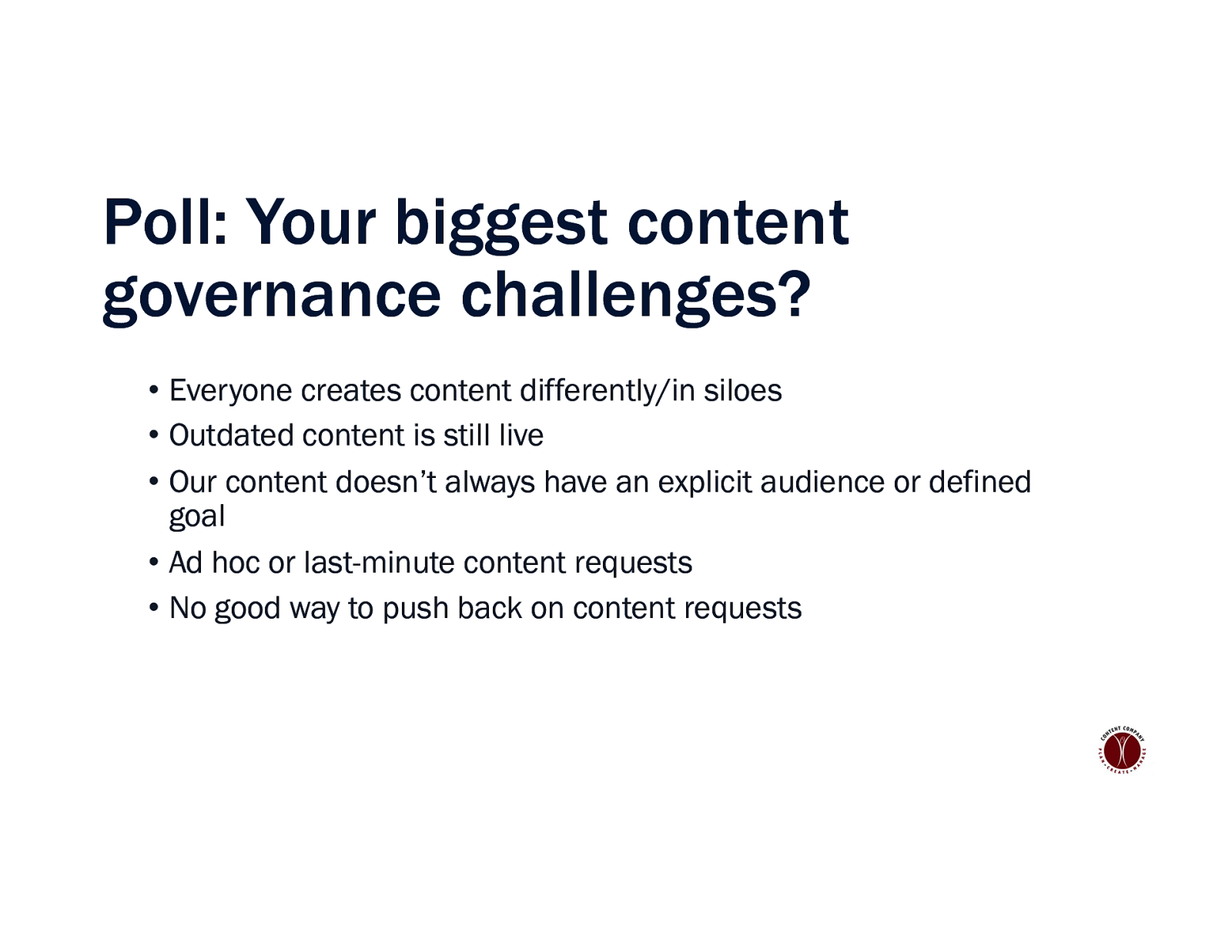
Poll: Your biggest content governance challenges? • Everyone creates content differently/in siloes • Outdated content is still live • Our content doesn’t always have an explicit audience or defined goal • Ad hoc or last-minute content requests • No good way to push back on content requests
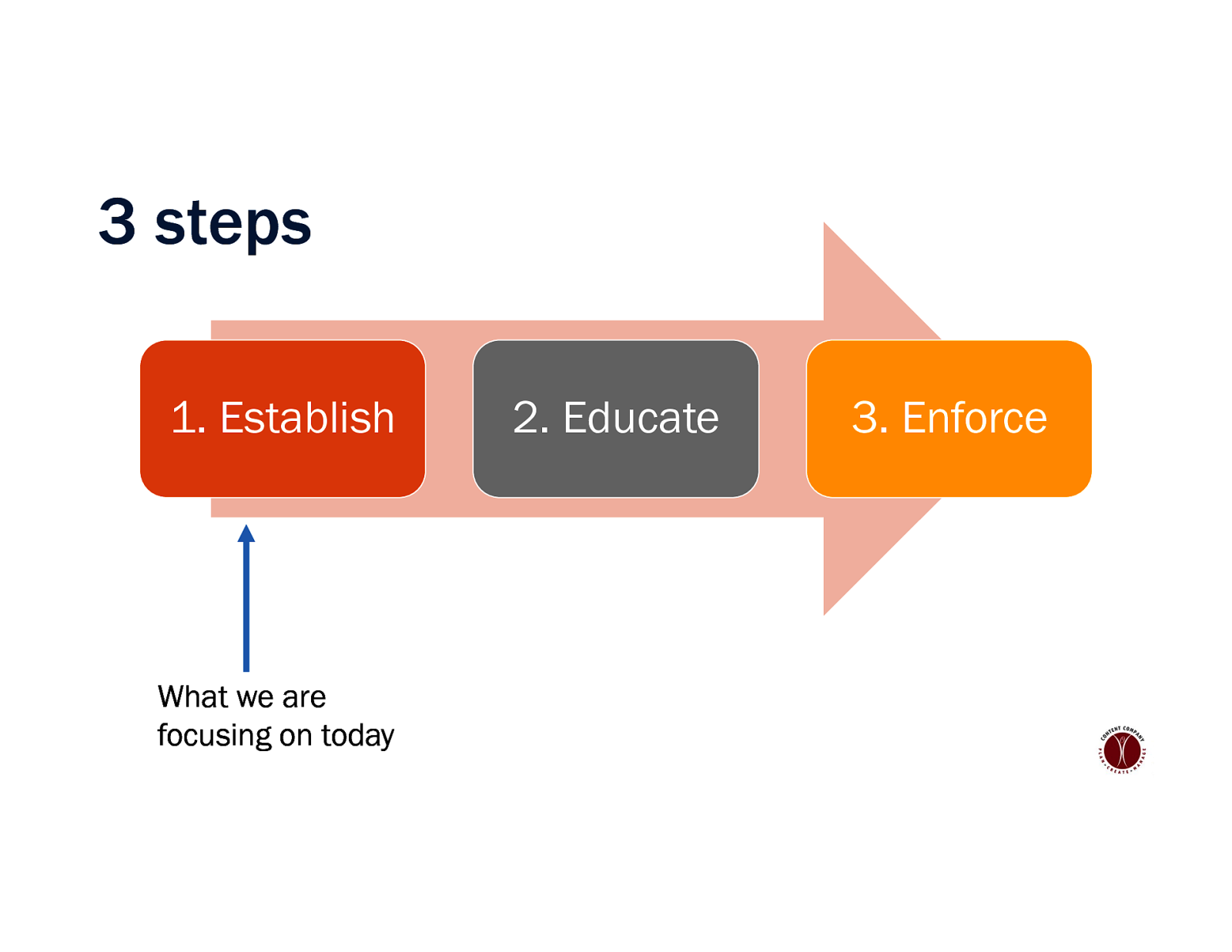
2 6 3 steps 1. Establish What we are focusing on today 2. Educate 3. Enforce
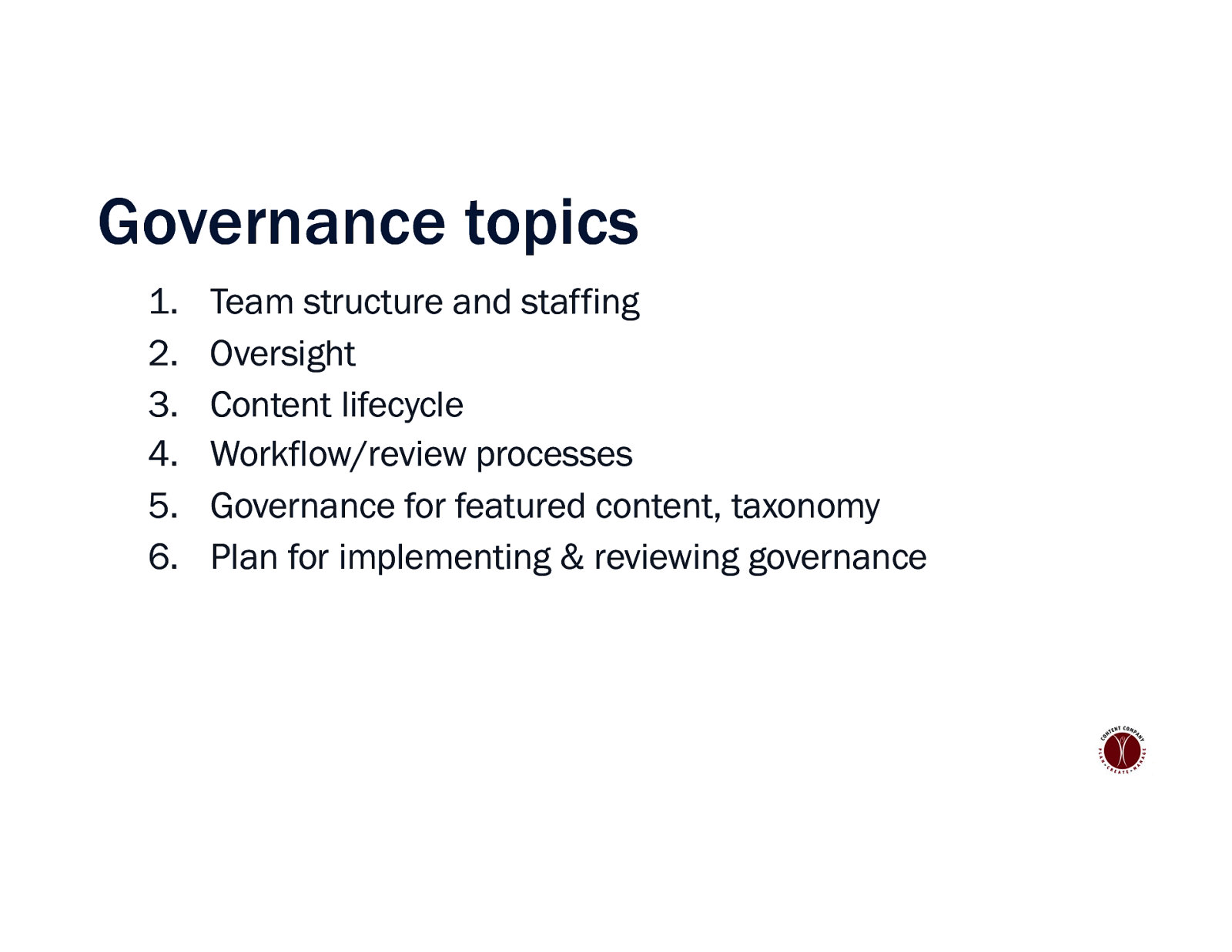
Governance topics 1. 2. 3. 4. 5. 6. Team structure and staffing Oversight Content lifecycle Workflow/review processes Governance for featured content, taxonomy Plan for implementing & reviewing governance
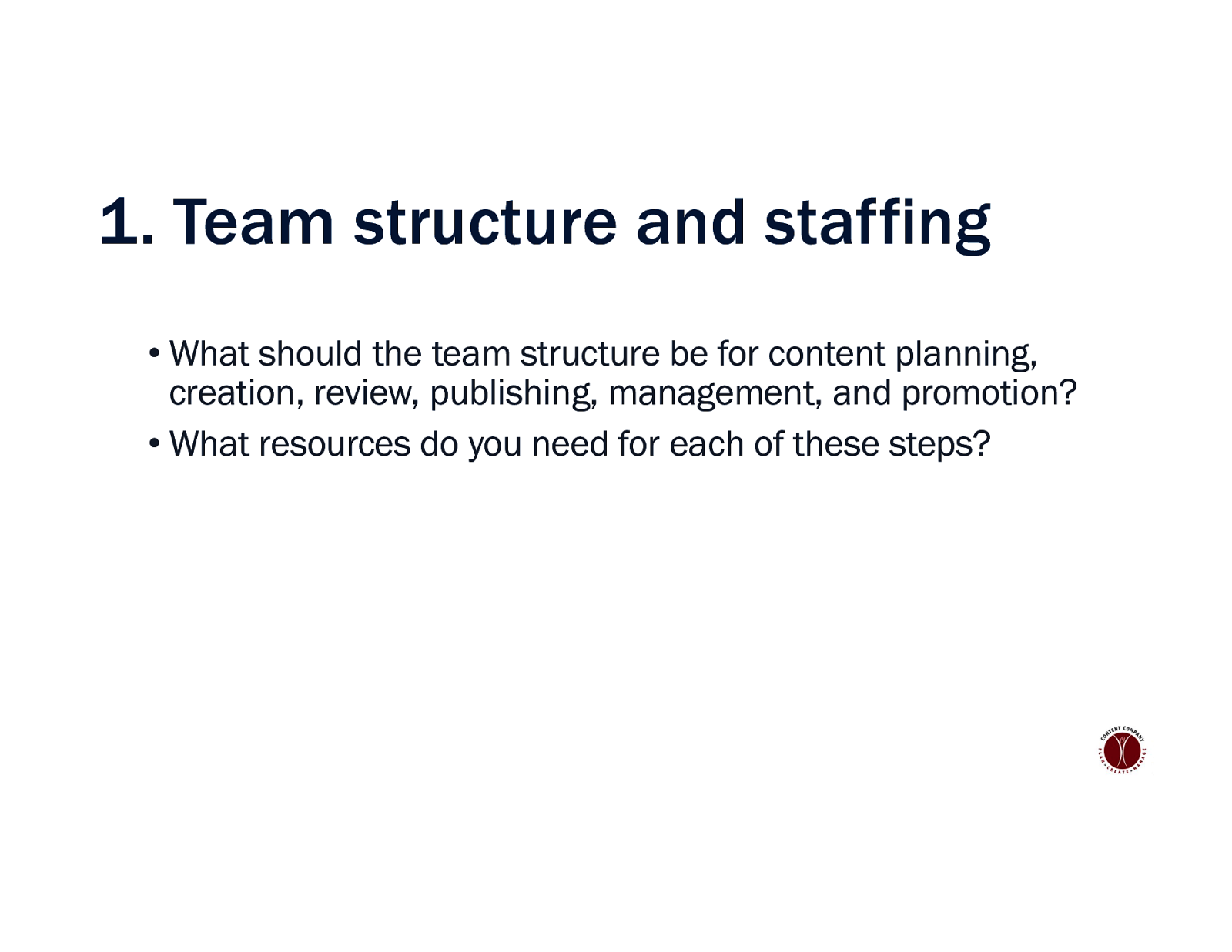
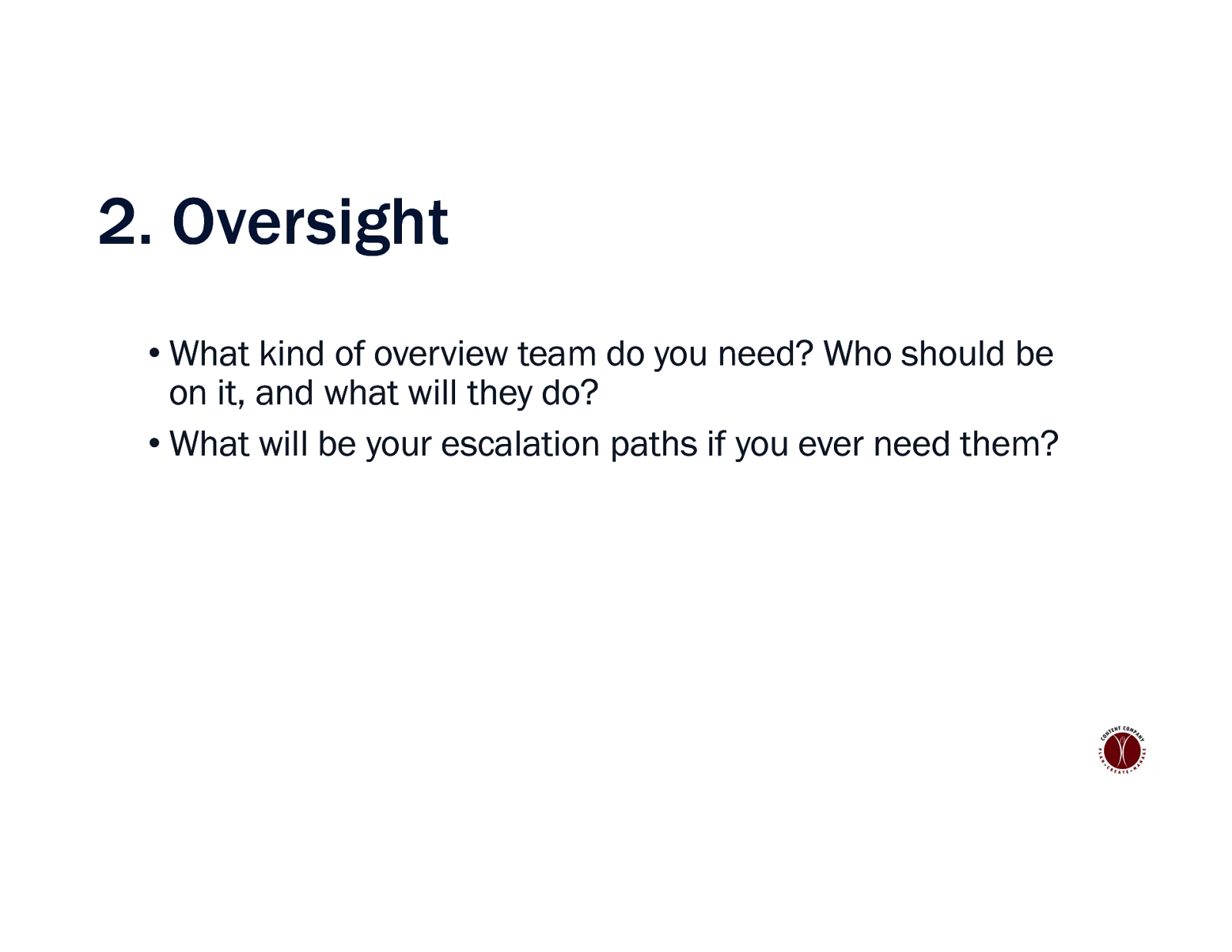
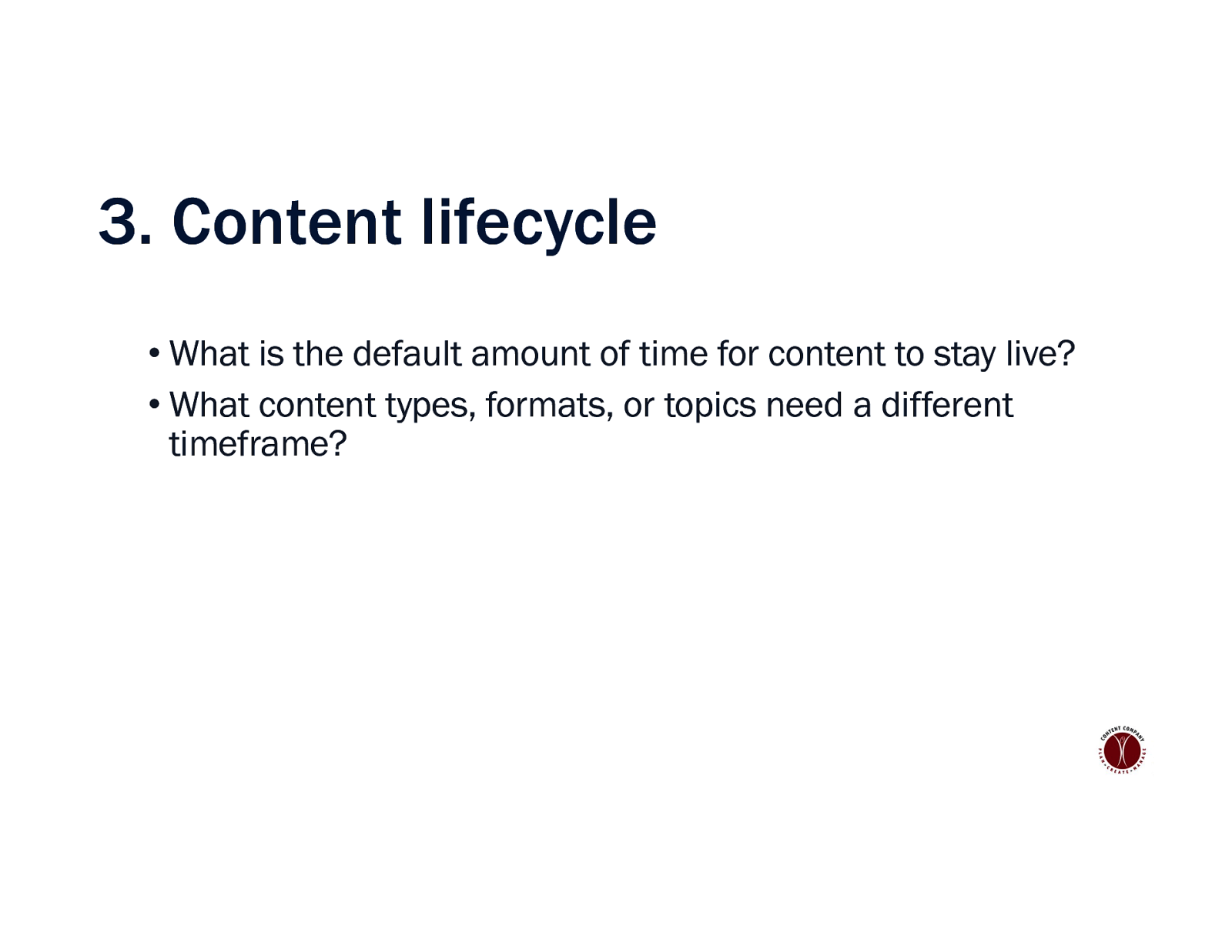
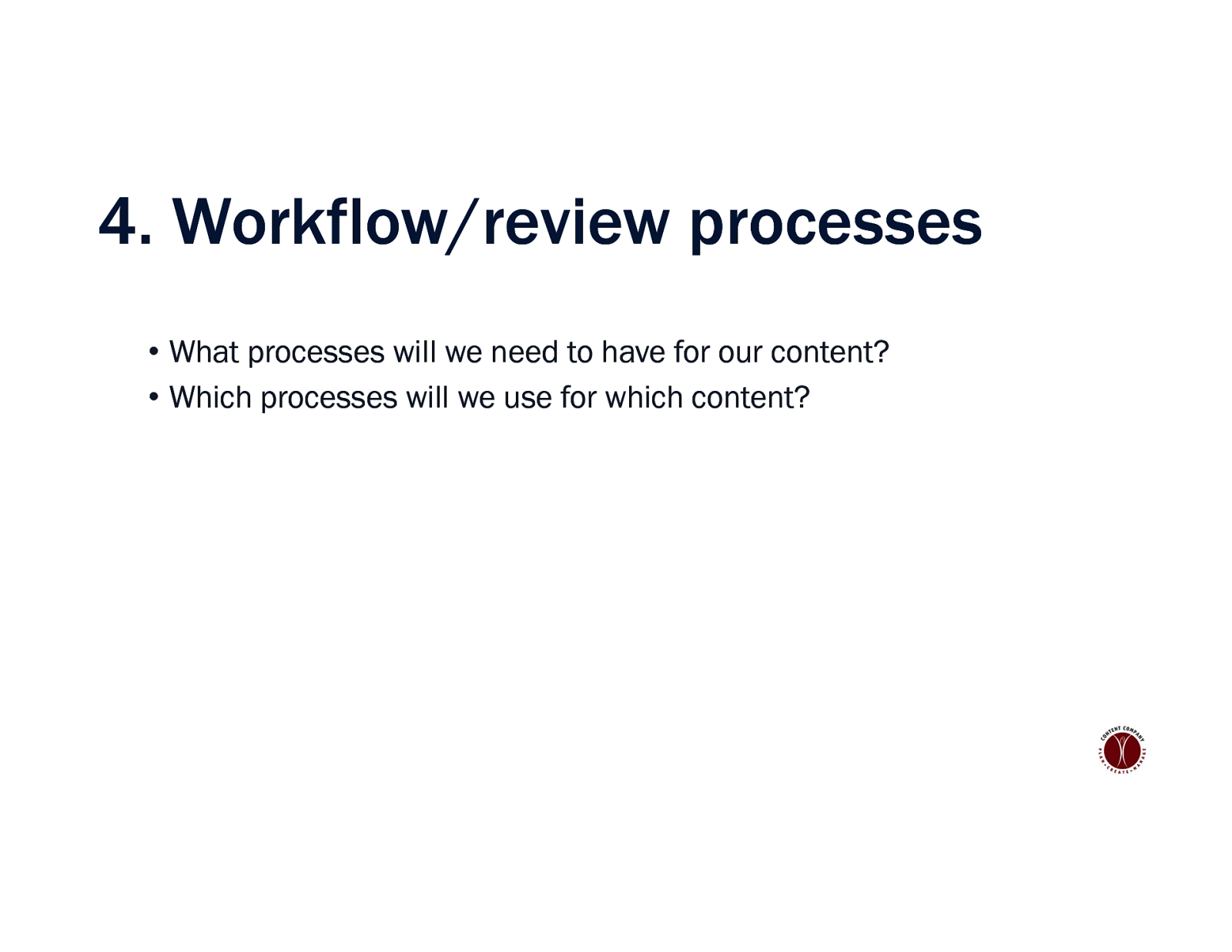
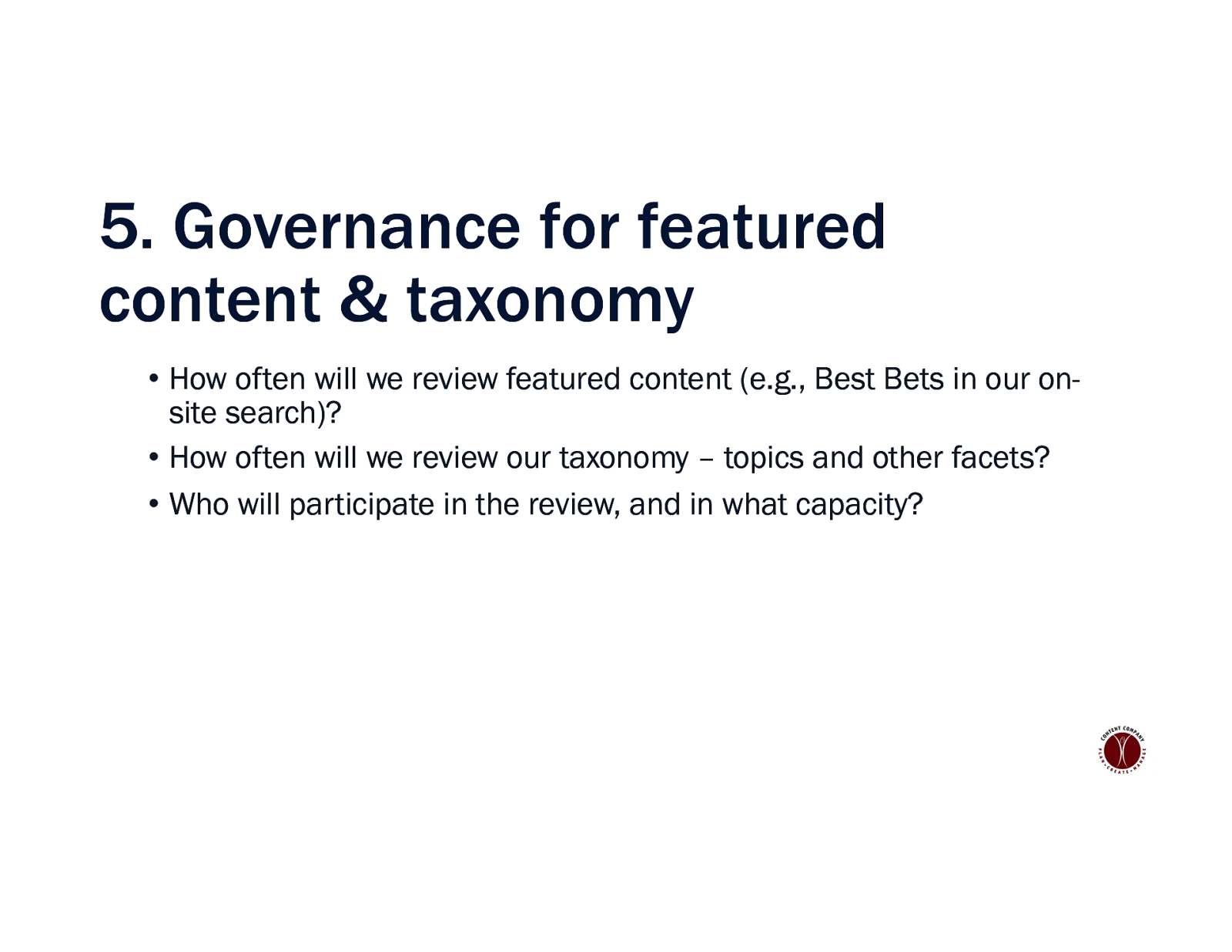
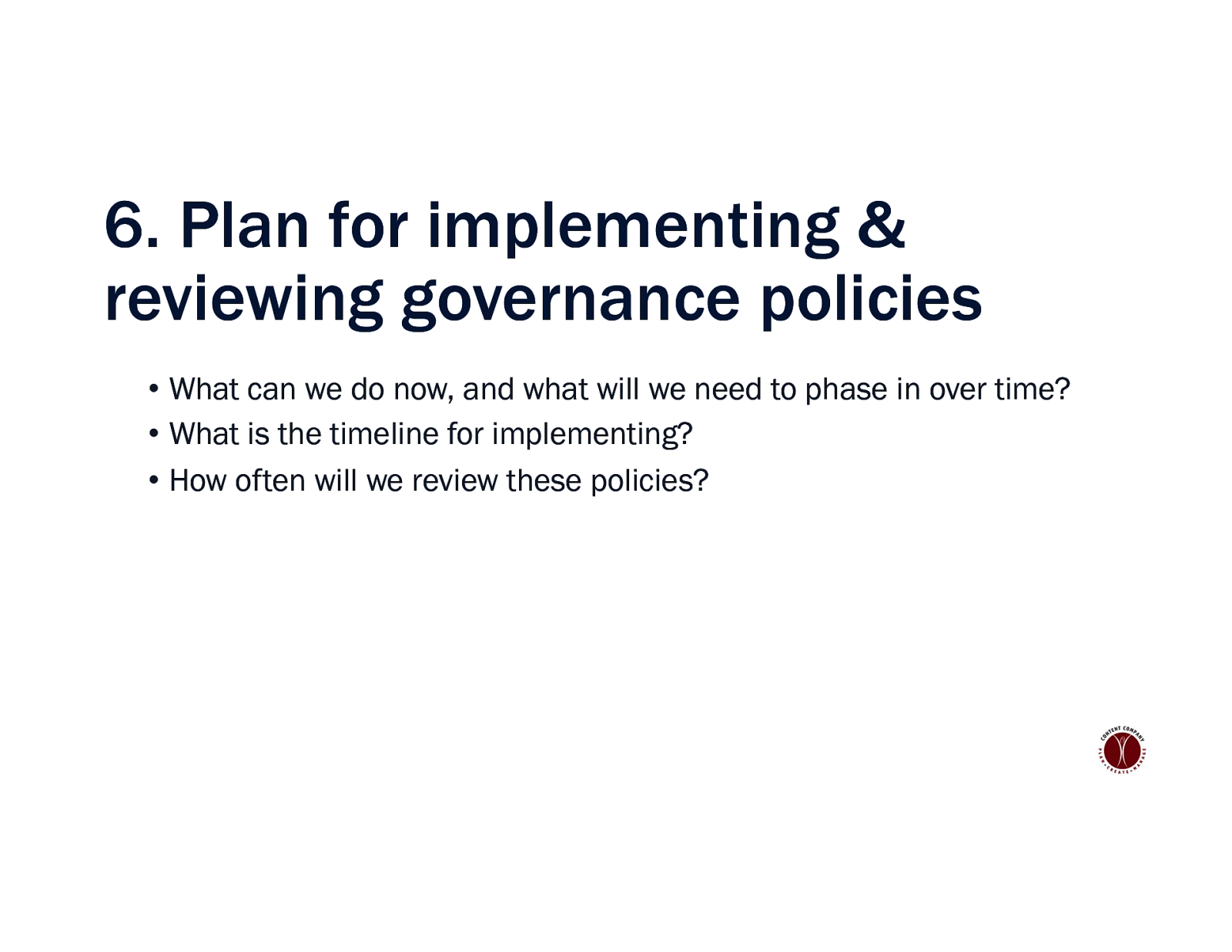
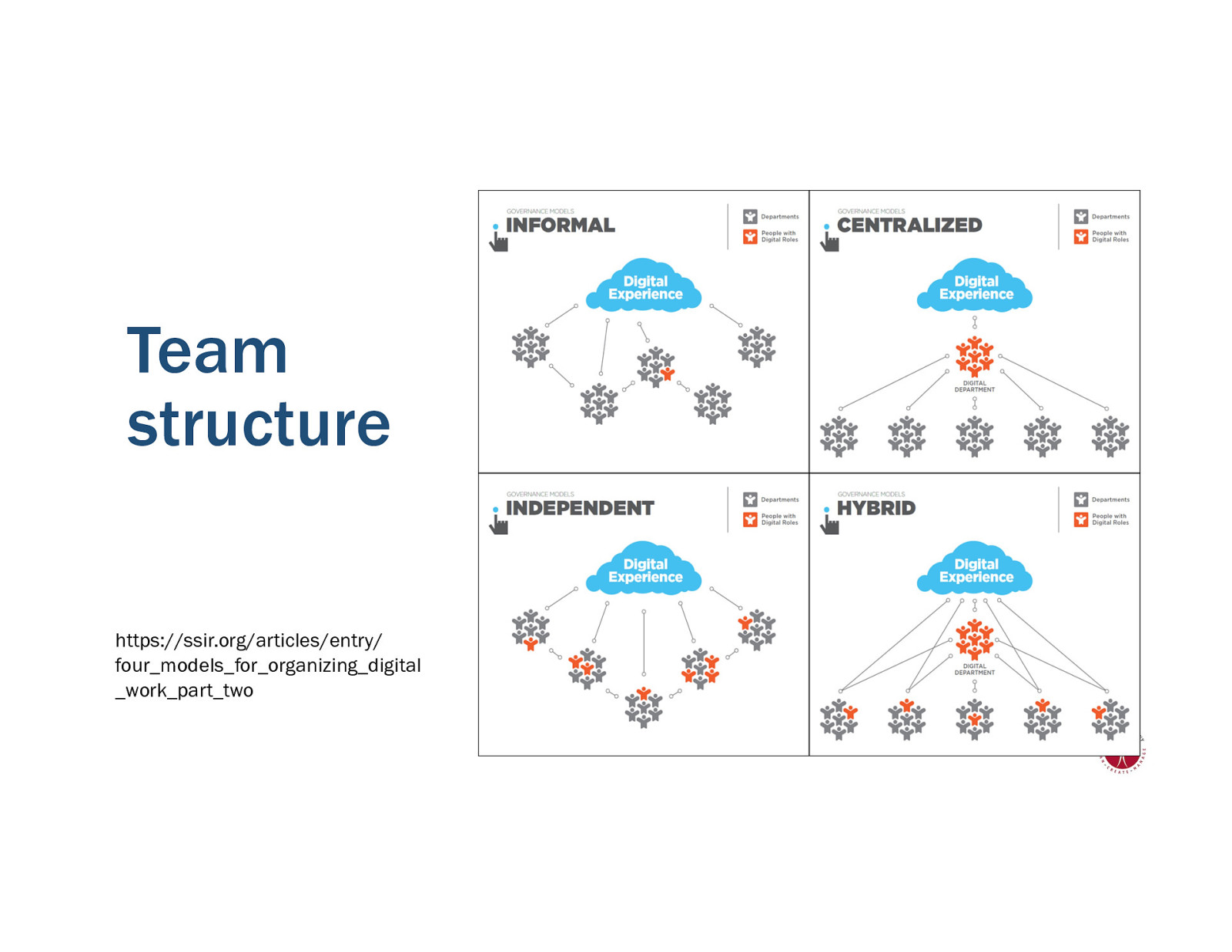
Team structure https://ssir.org/articles/entry/ four_models_for_organizing_digital _work_part_two
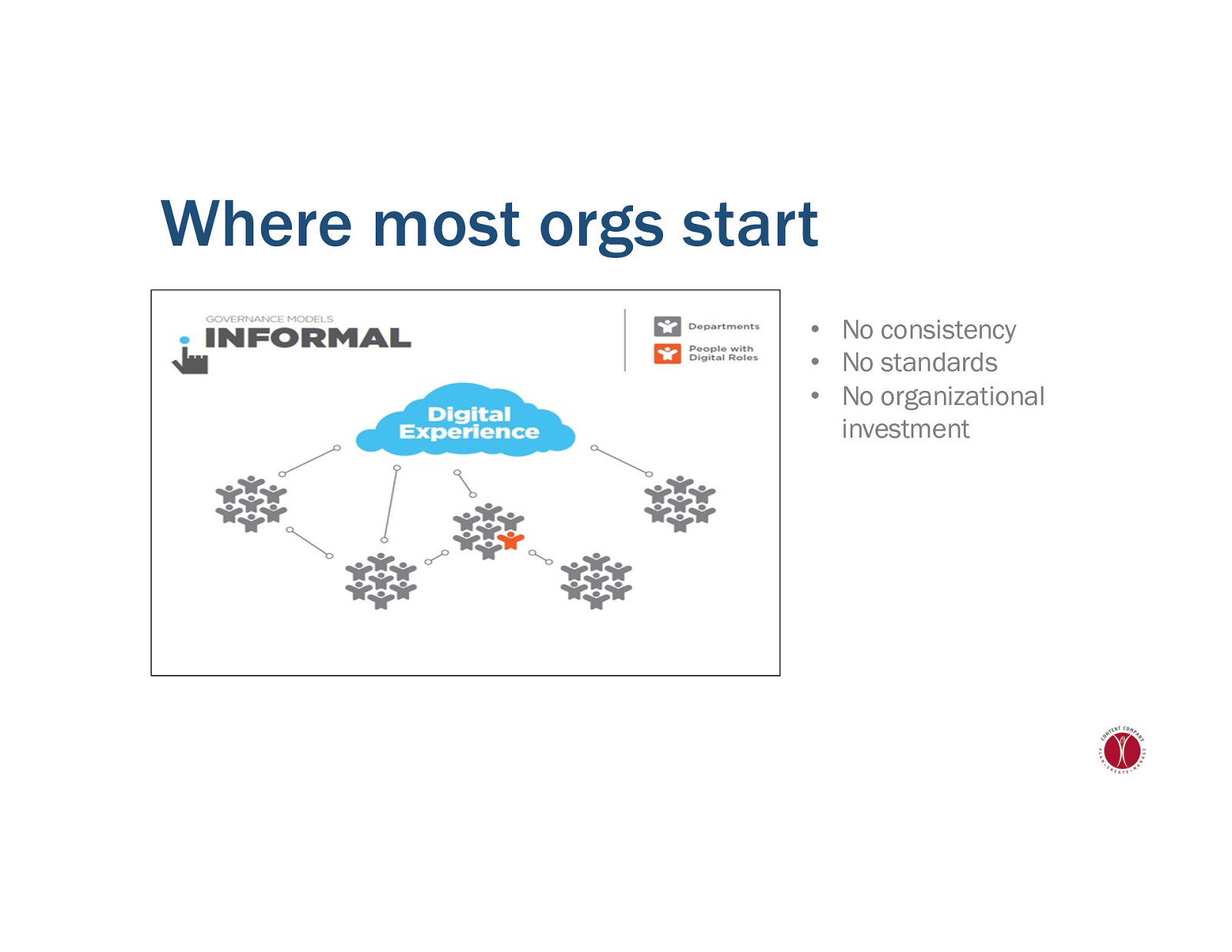
Where most orgs start • No consistency • No standards • No organizational investment
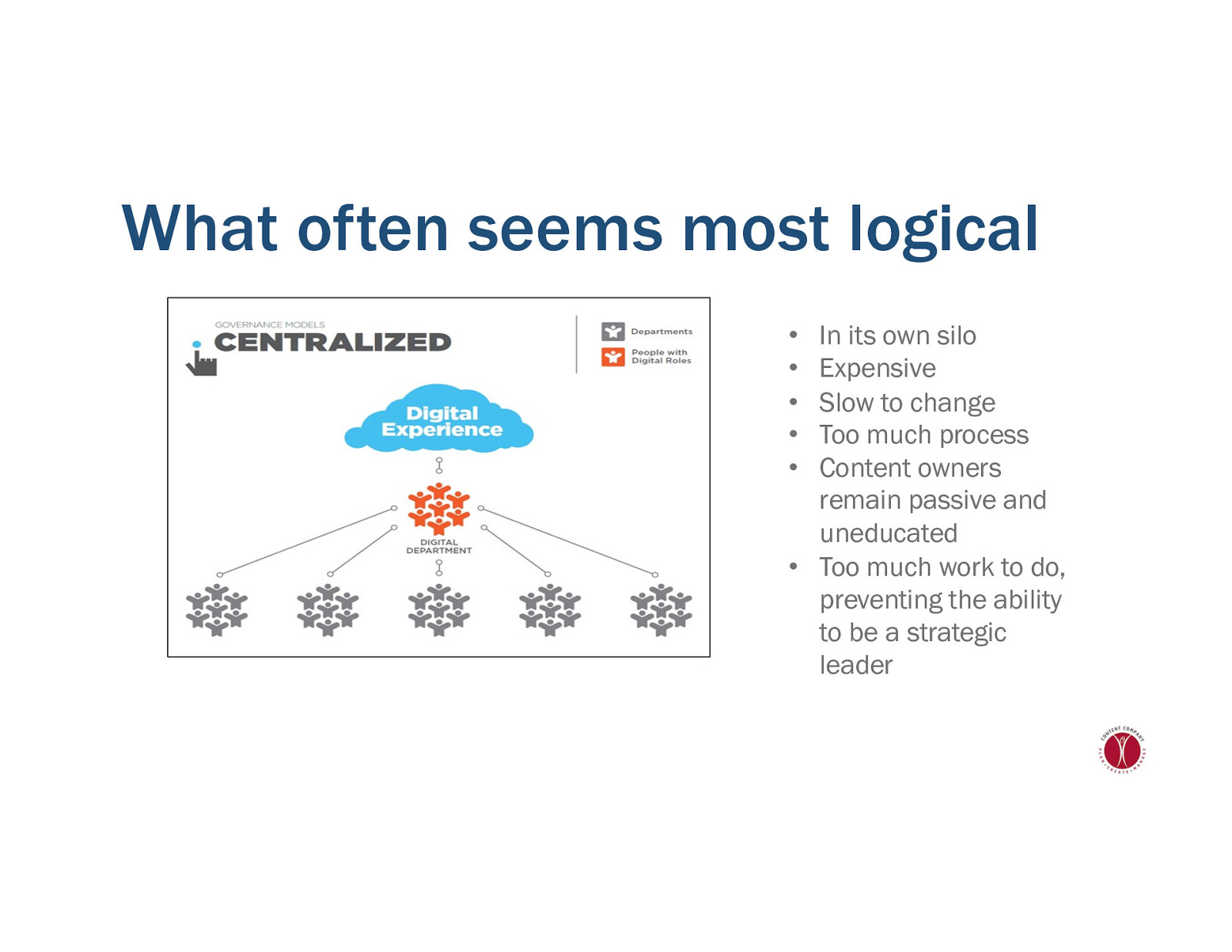
What often seems most logical In its own silo Expensive Slow to change Too much process Content owners remain passive and uneducated • Too much work to do, preventing the ability to be a strategic leader • • • • •
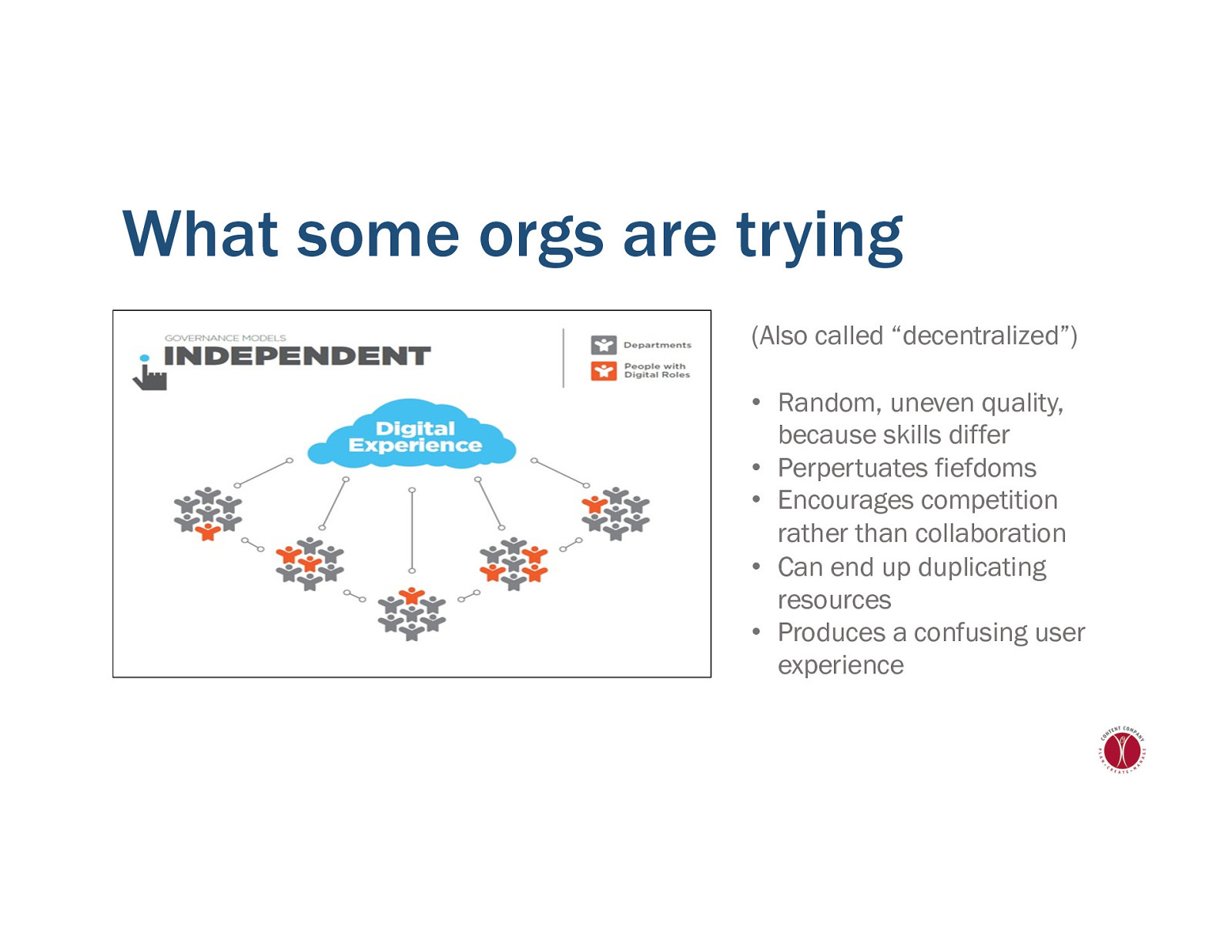
What some orgs are trying (Also called “decentralized”) • Random, uneven quality, because skills differ • Perpertuates fiefdoms • Encourages competition rather than collaboration • Can end up duplicating resources • Produces a confusing user experience
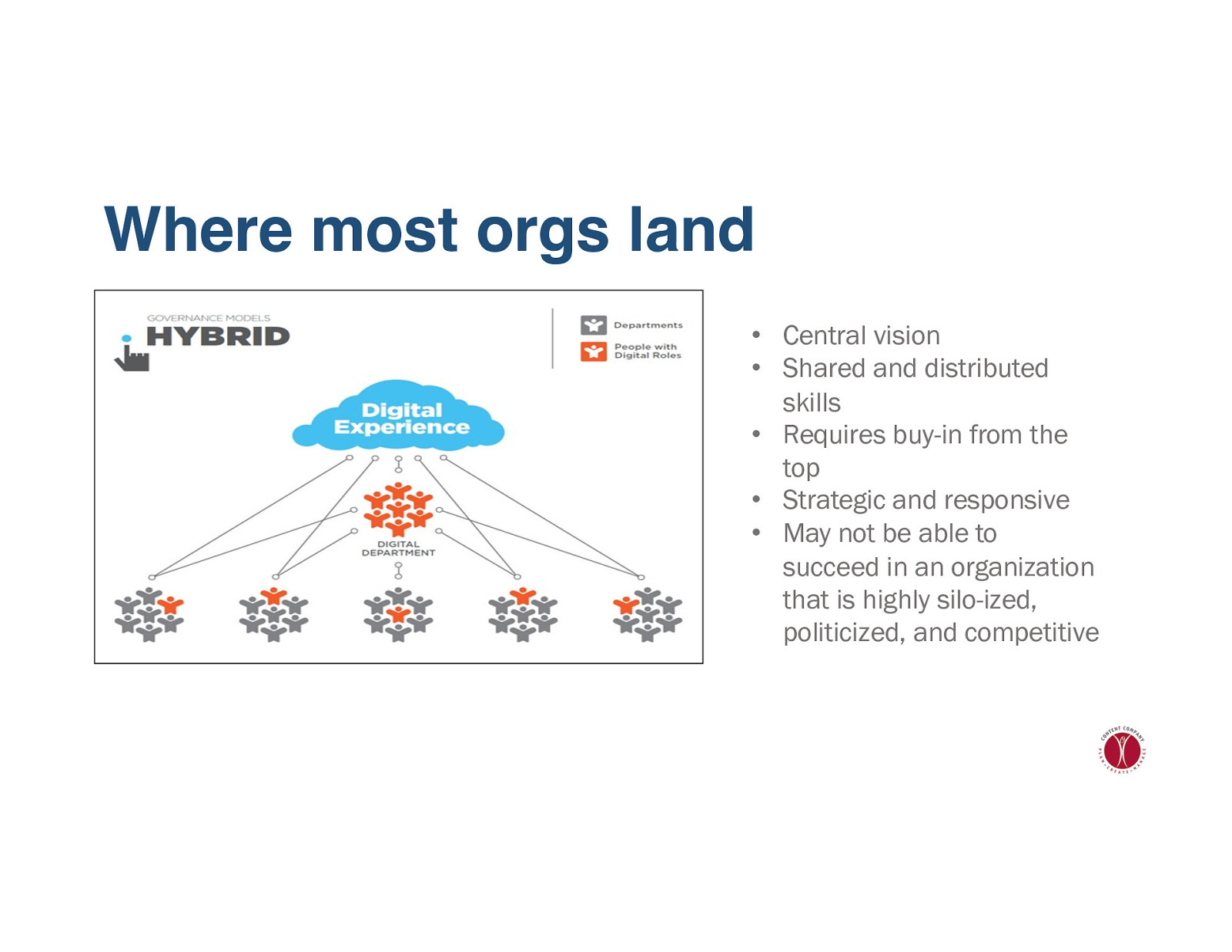
Where most orgs land • Central vision • Shared and distributed skills • Requires buy-in from the top • Strategic and responsive • May not be able to succeed in an organization that is highly silo-ized, politicized, and competitive
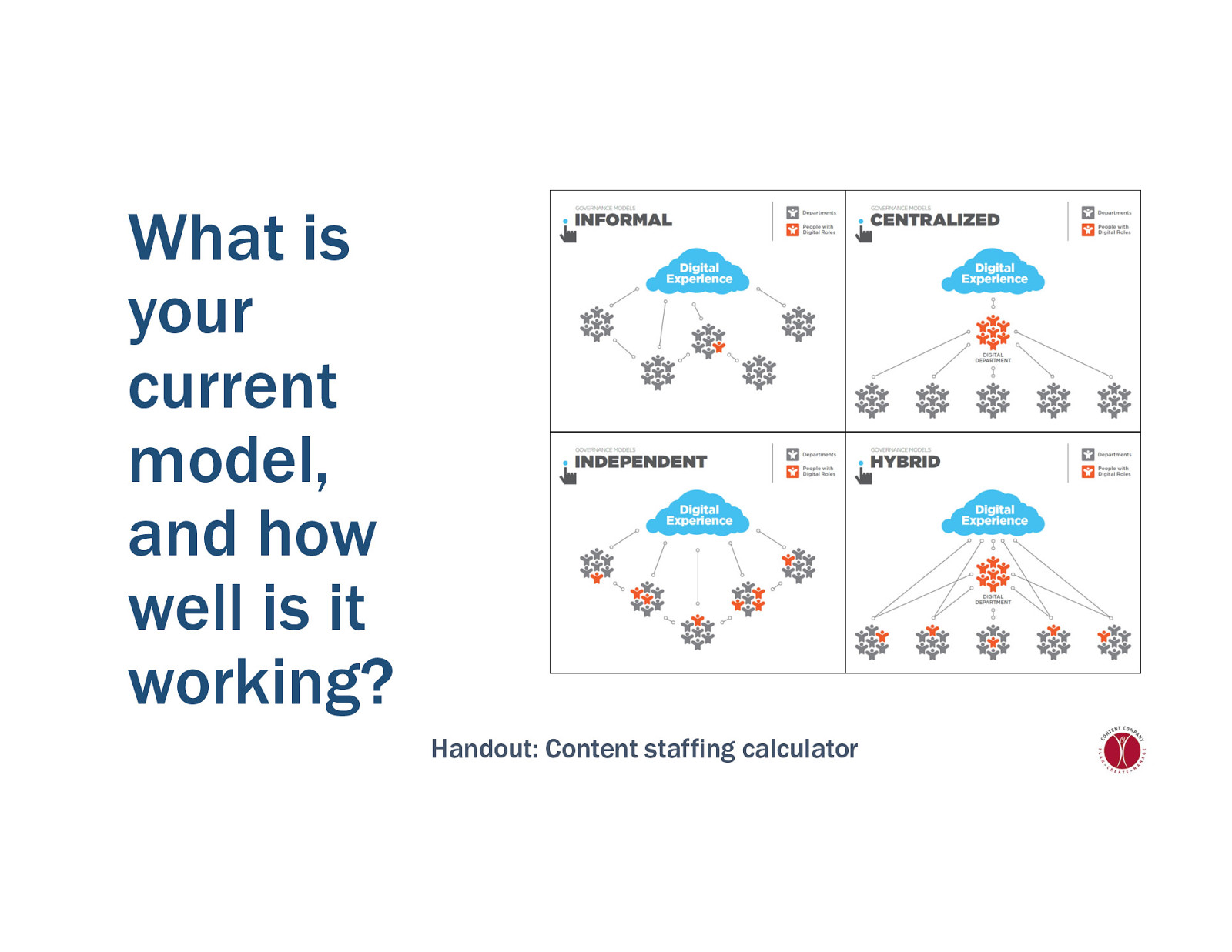
What is your current model, and how well is it working? Handout: Content staffing calculator
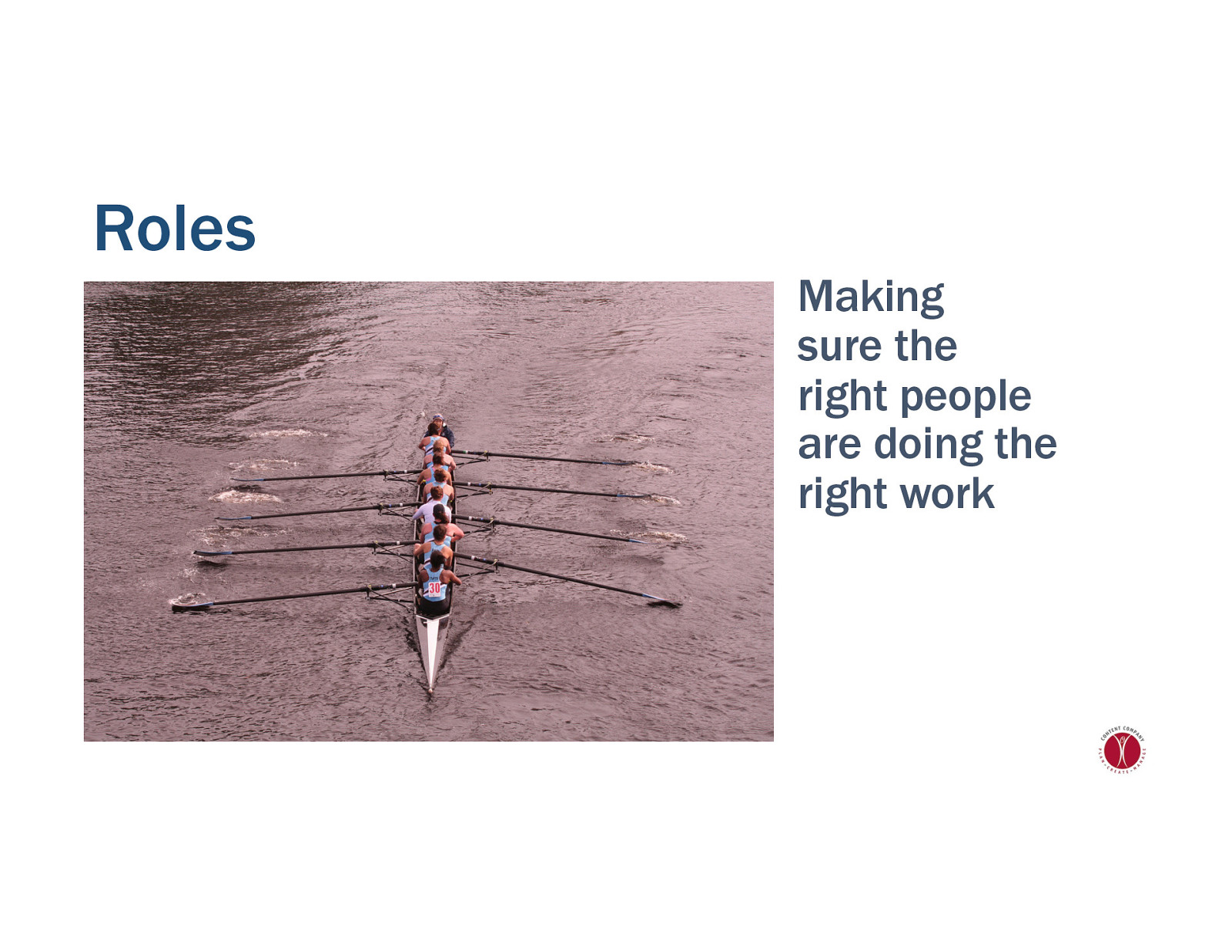
Roles Making sure the right people are doing the right work https://www.flickr.com/photos/crschmidt/2955871565
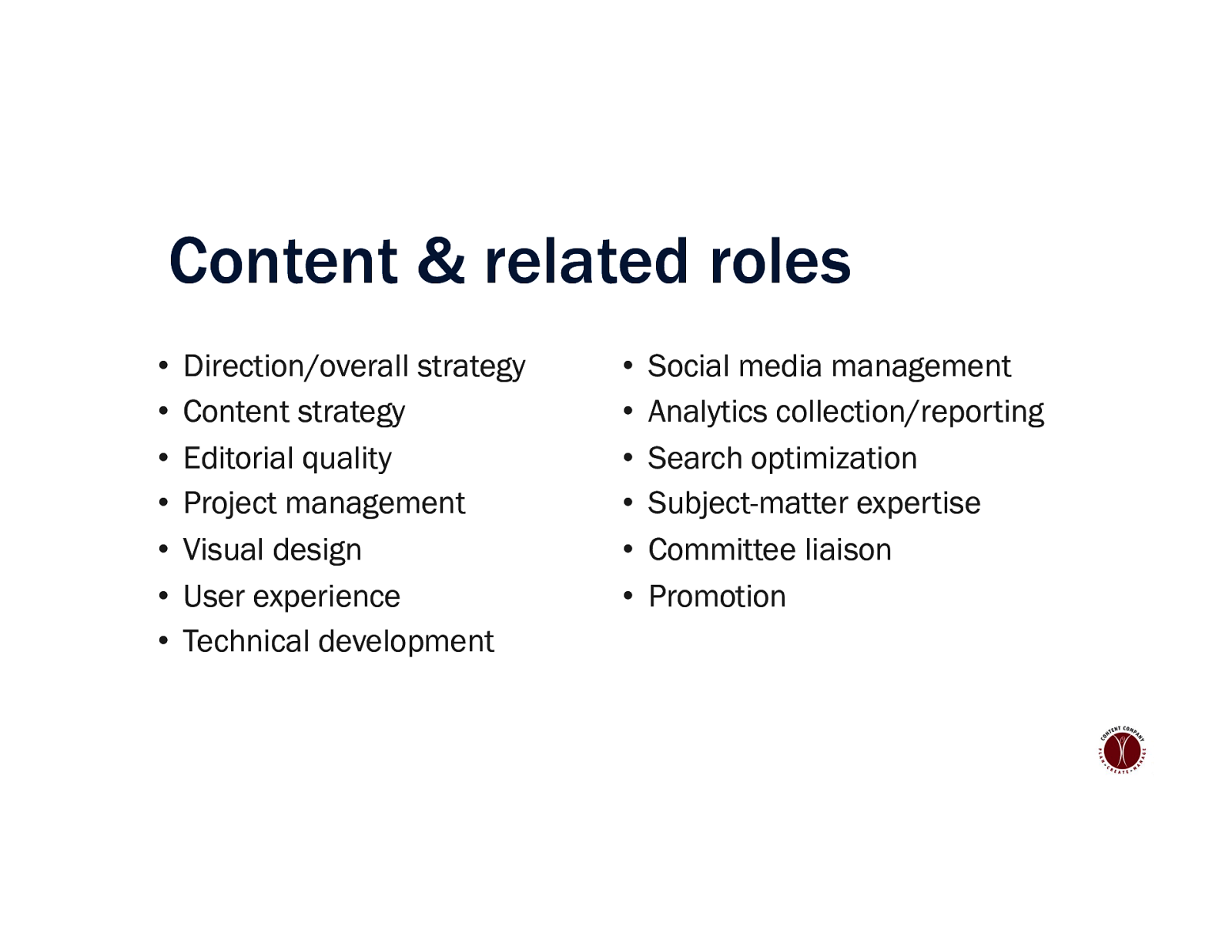
Content & related roles • • • • • • • Direction/overall strategy Content strategy Editorial quality Project management Visual design User experience Technical development • • • • • • Social media management Analytics collection/reporting Search optimization Subject-matter expertise Committee liaison Promotion
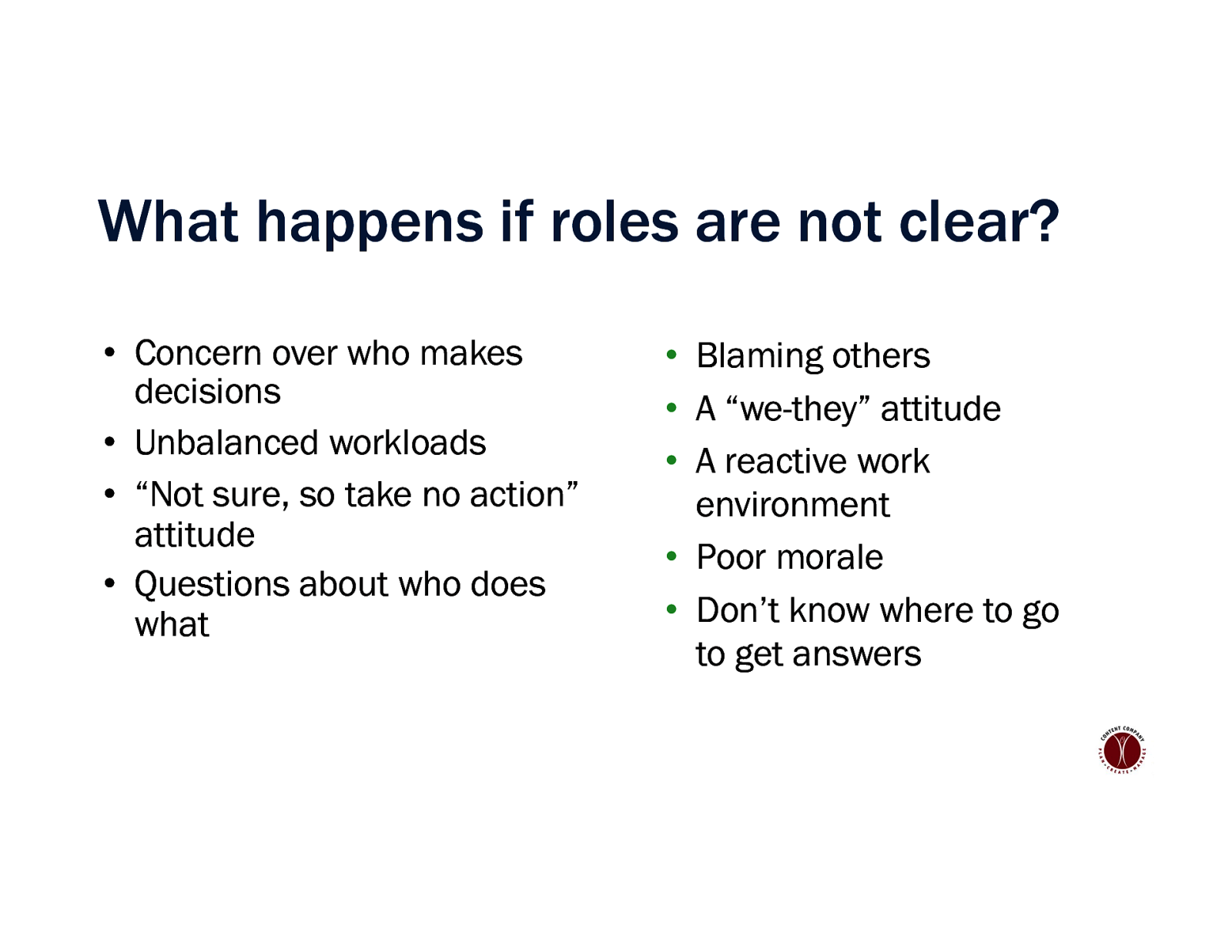
What happens if roles are not clear? • Concern over who makes decisions • Unbalanced workloads • “Not sure, so take no action” attitude • Questions about who does what • Blaming others • A “we-they” attitude • A reactive work environment • Poor morale • Don’t know where to go to get answers
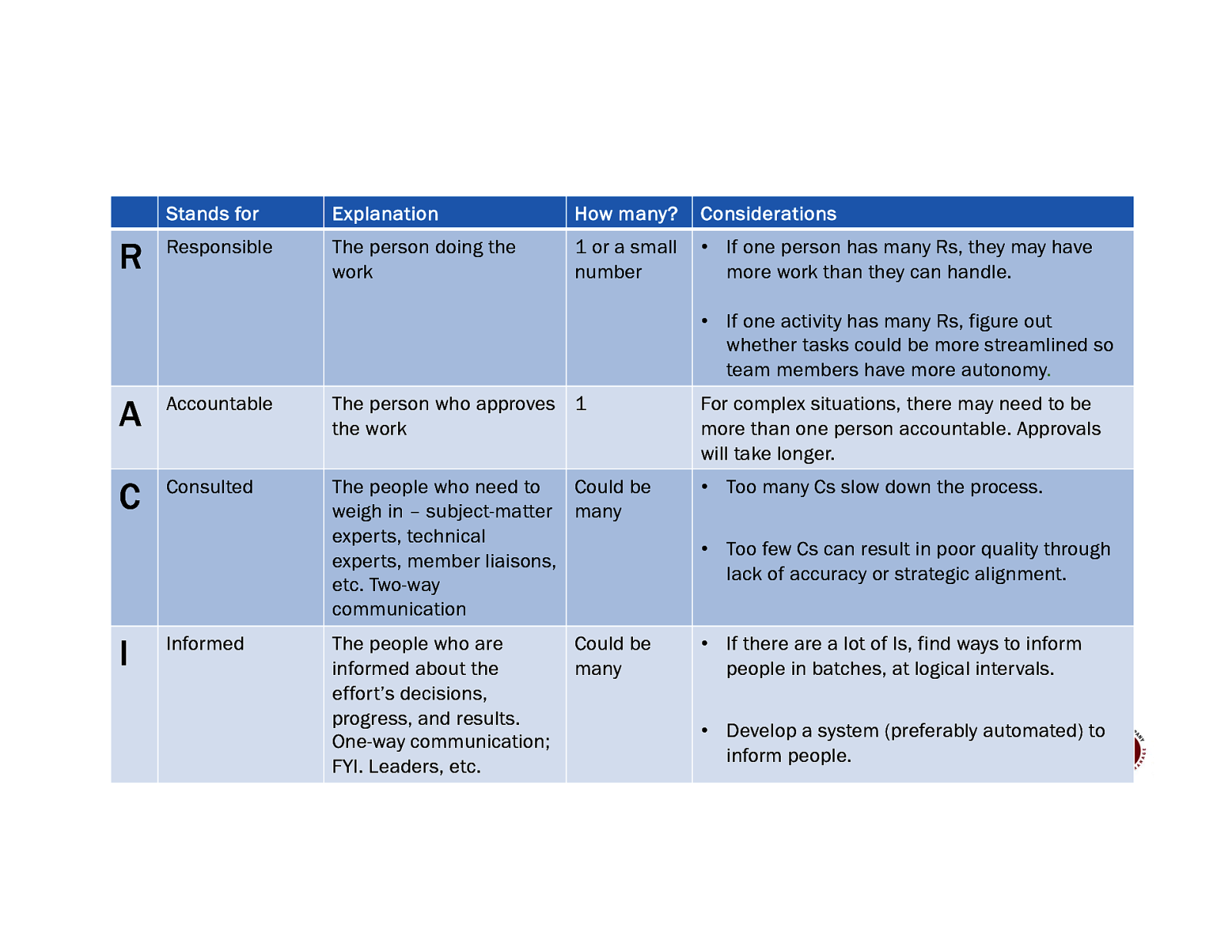
R Stands for Explanation How many? Considerations Responsible The person doing the work 1 or a small number • If one person has many Rs, they may have more work than they can handle. • If one activity has many Rs, figure out whether tasks could be more streamlined so team members have more autonomy. A Accountable The person who approves 1 the work For complex situations, there may need to be more than one person accountable. Approvals will take longer. C Consulted The people who need to Could be weigh in – subject-matter many experts, technical experts, member liaisons, etc. Two-way communication • Too many Cs slow down the process. The people who are informed about the effort’s decisions, progress, and results. One-way communication; FYI. Leaders, etc. • If there are a lot of Is, find ways to inform people in batches, at logical intervals. I Informed Could be many • Too few Cs can result in poor quality through lack of accuracy or strategic alignment. • Develop a system (preferably automated) to inform people.
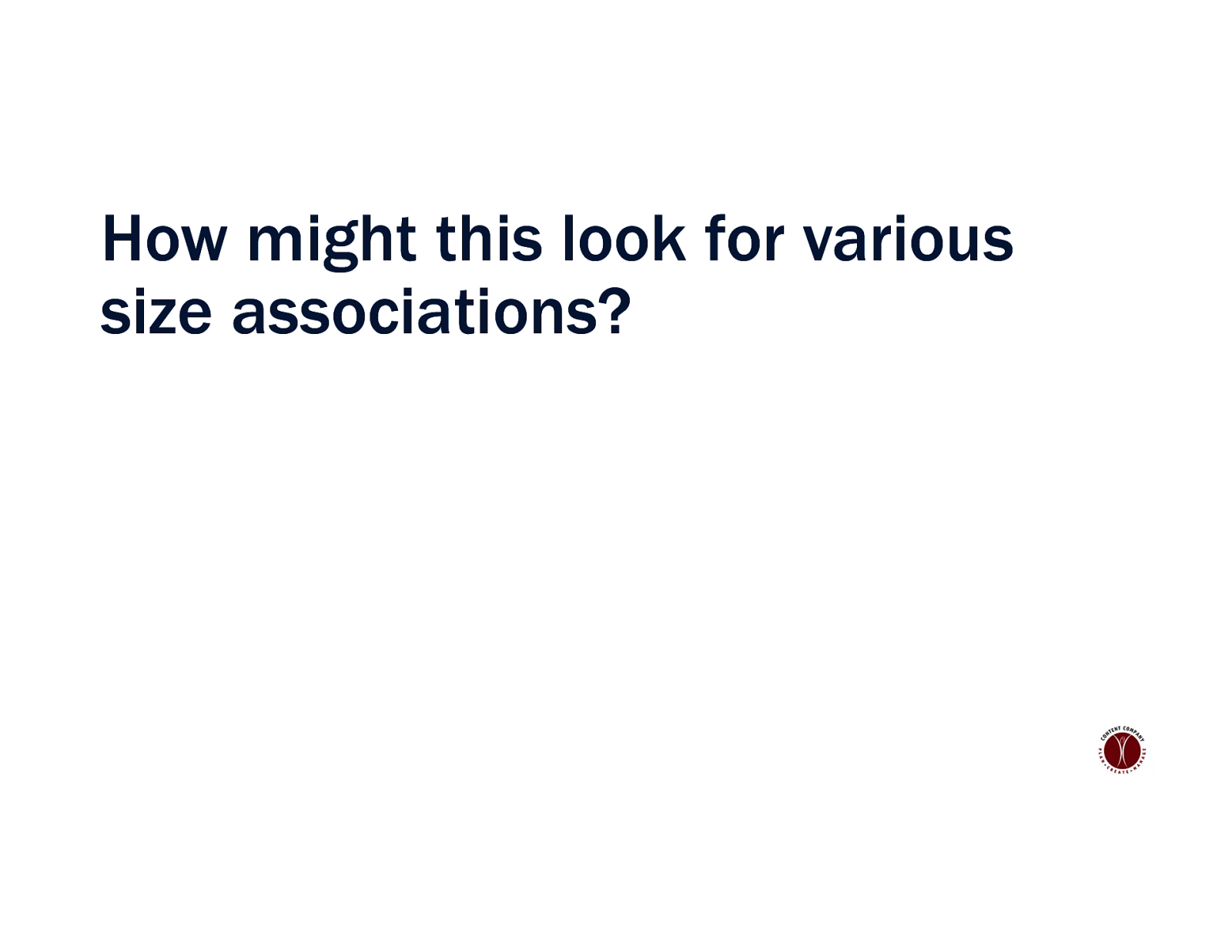
How might this look for various size associations?
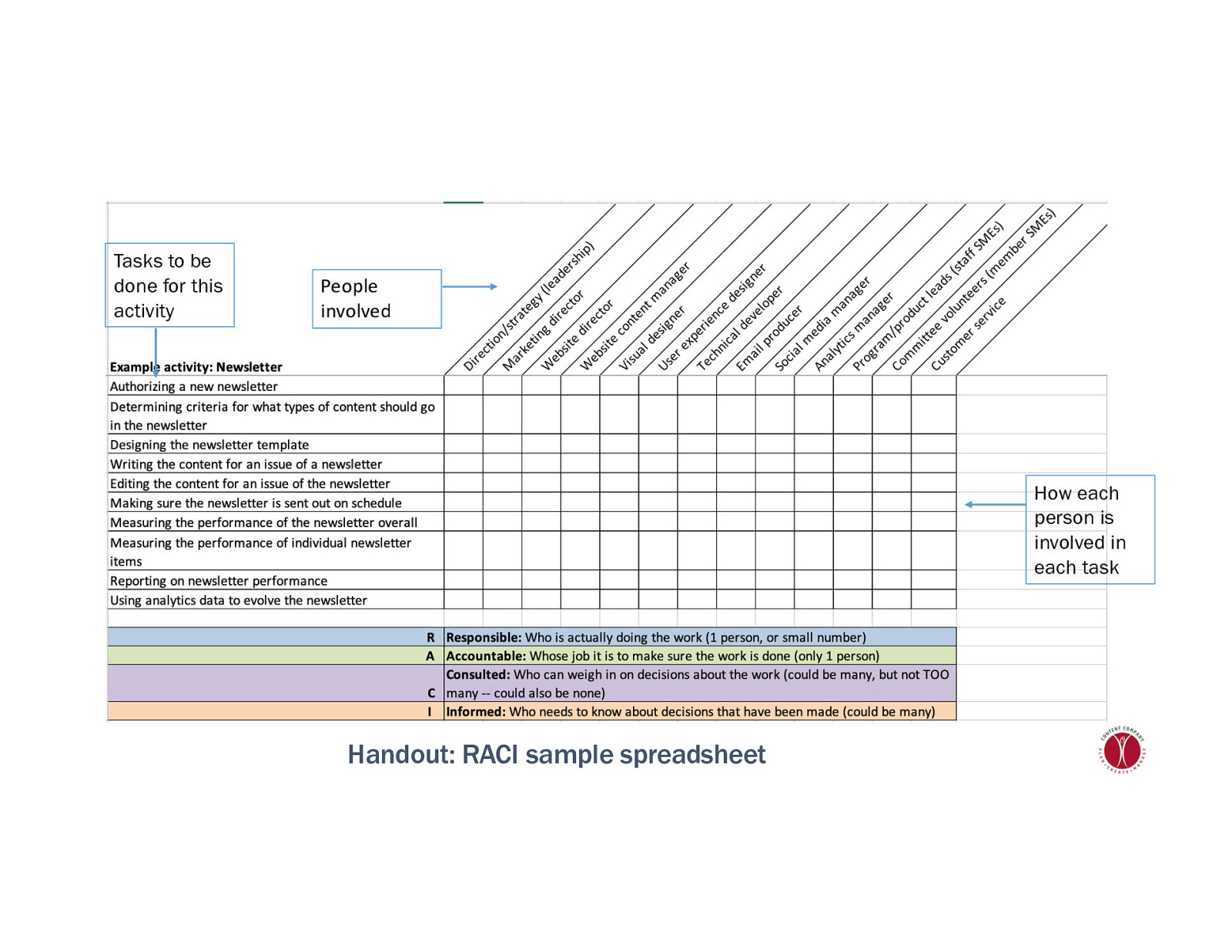
Tasks to be done for this activity People involved How each person is involved in each task Handout: RACI sample spreadsheet
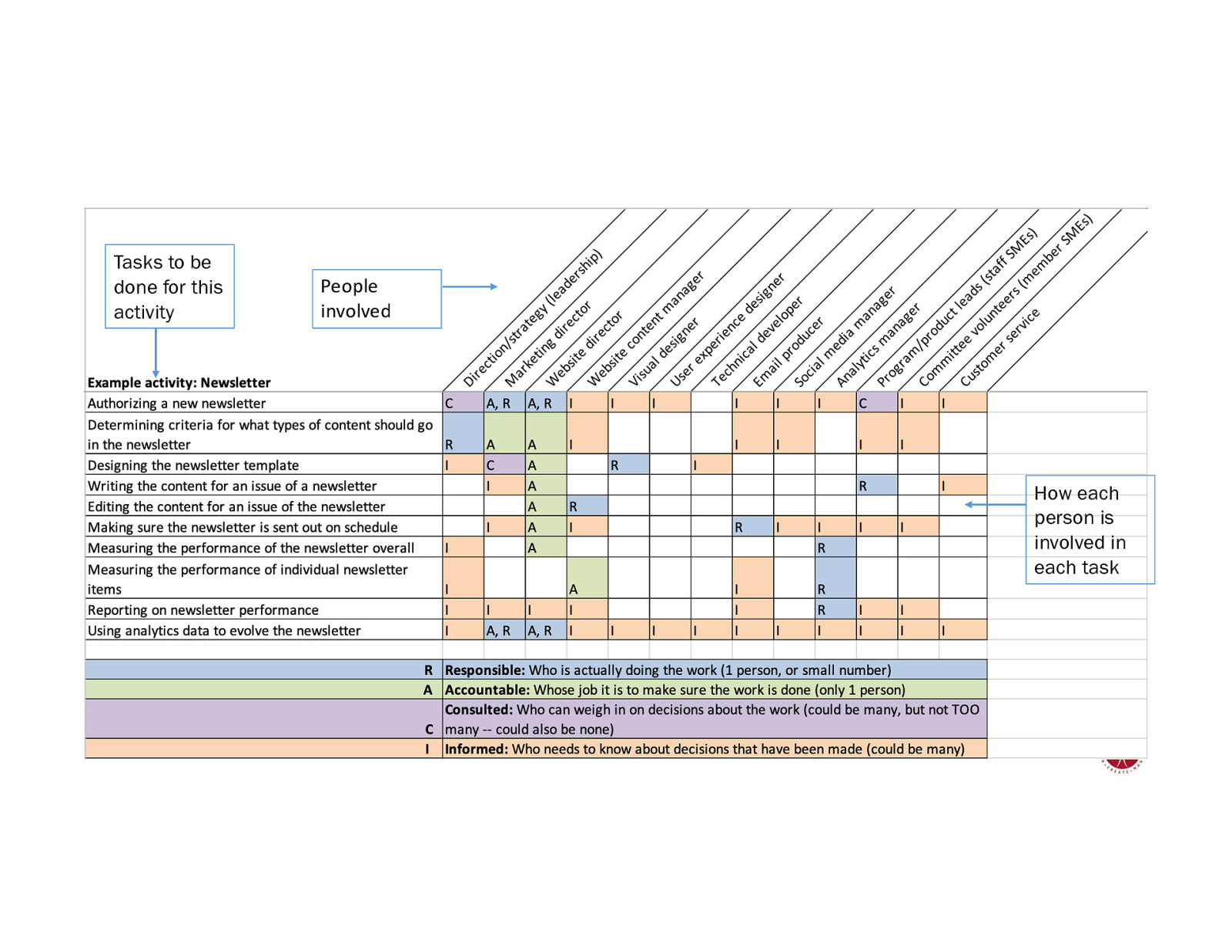
Tasks to be done for this activity People involved How each person is involved in each task
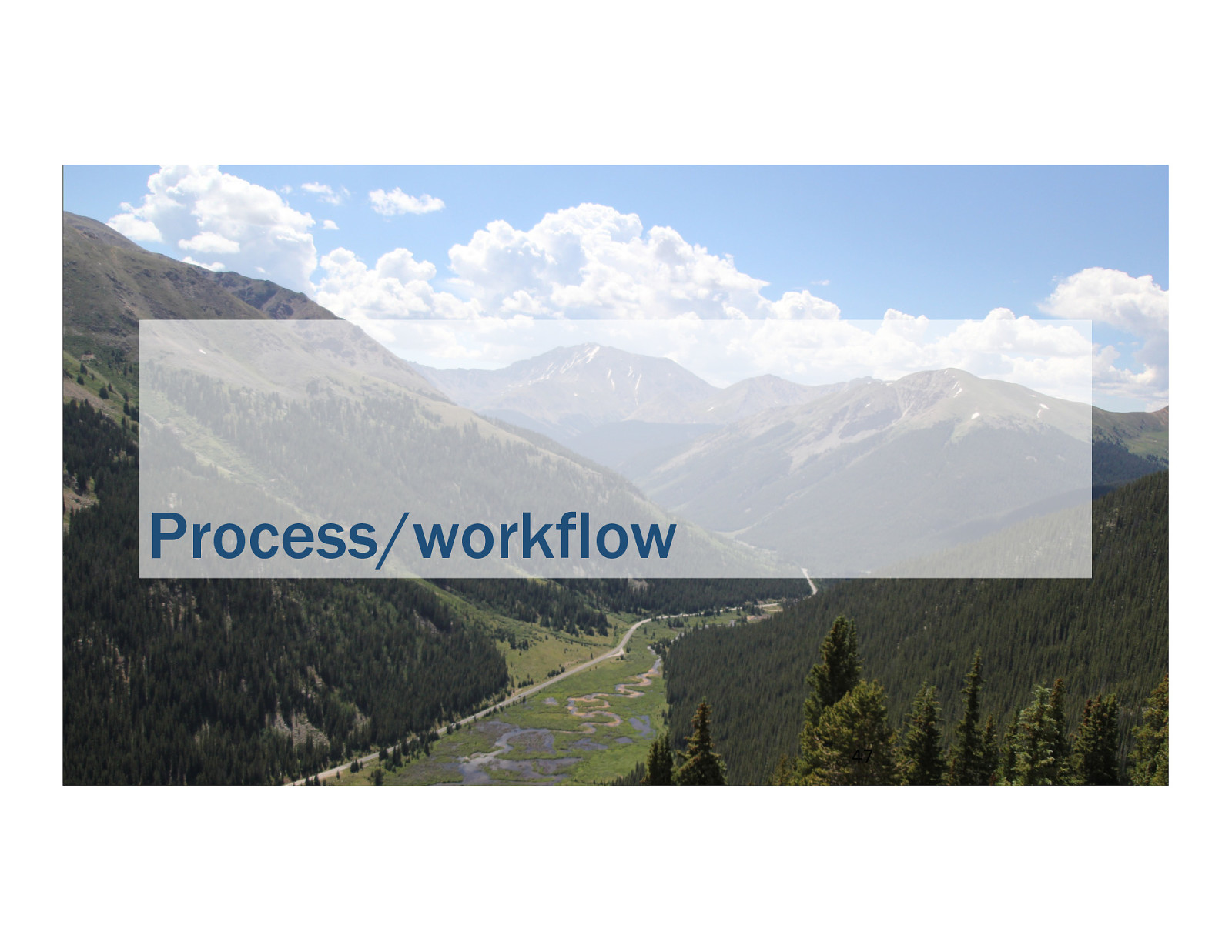
Process/workflow 47
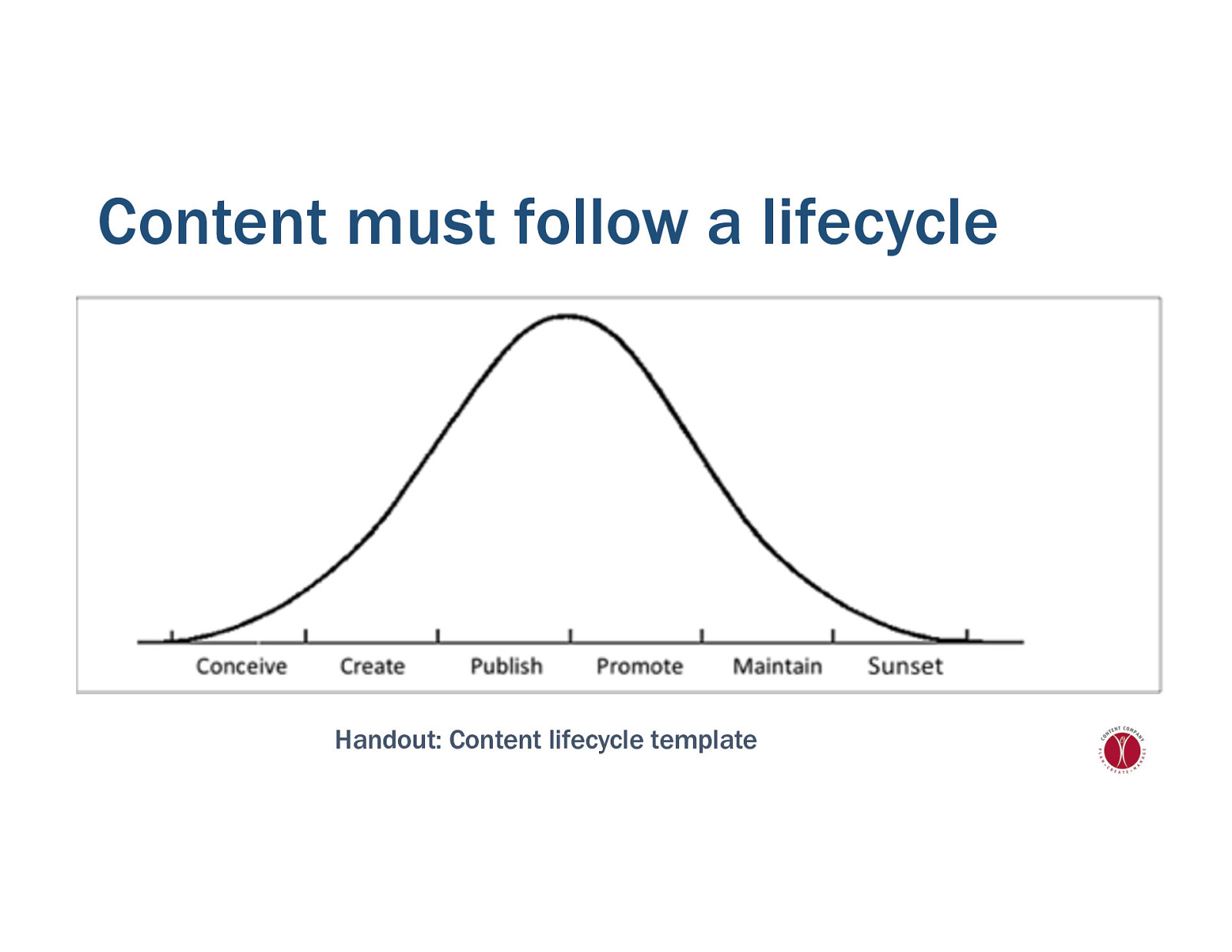
Content must follow a lifecycle Handout: Content lifecycle template
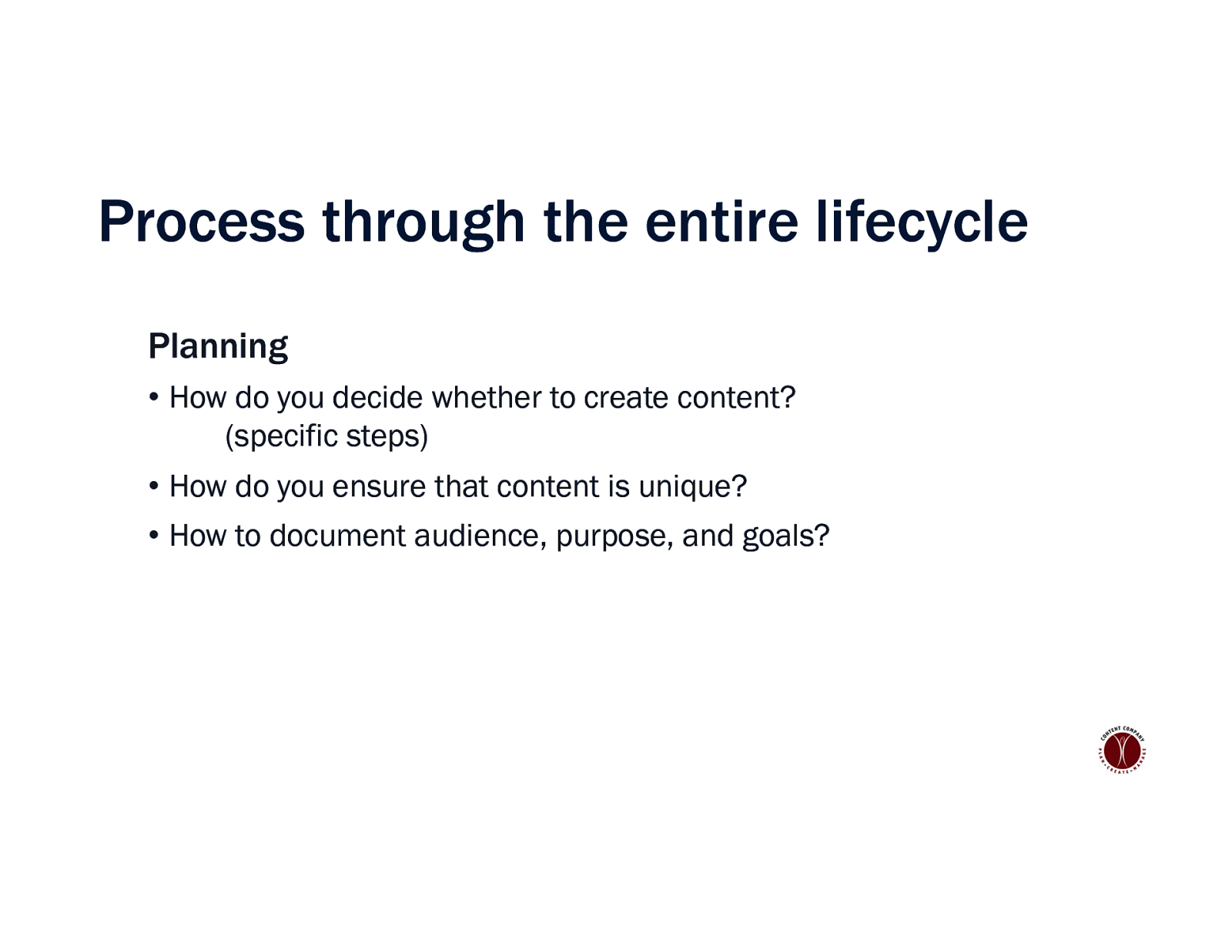
Process through the entire lifecycle Planning • How do you decide whether to create content? (specific steps) • How do you ensure that content is unique? • How to document audience, purpose, and goals?
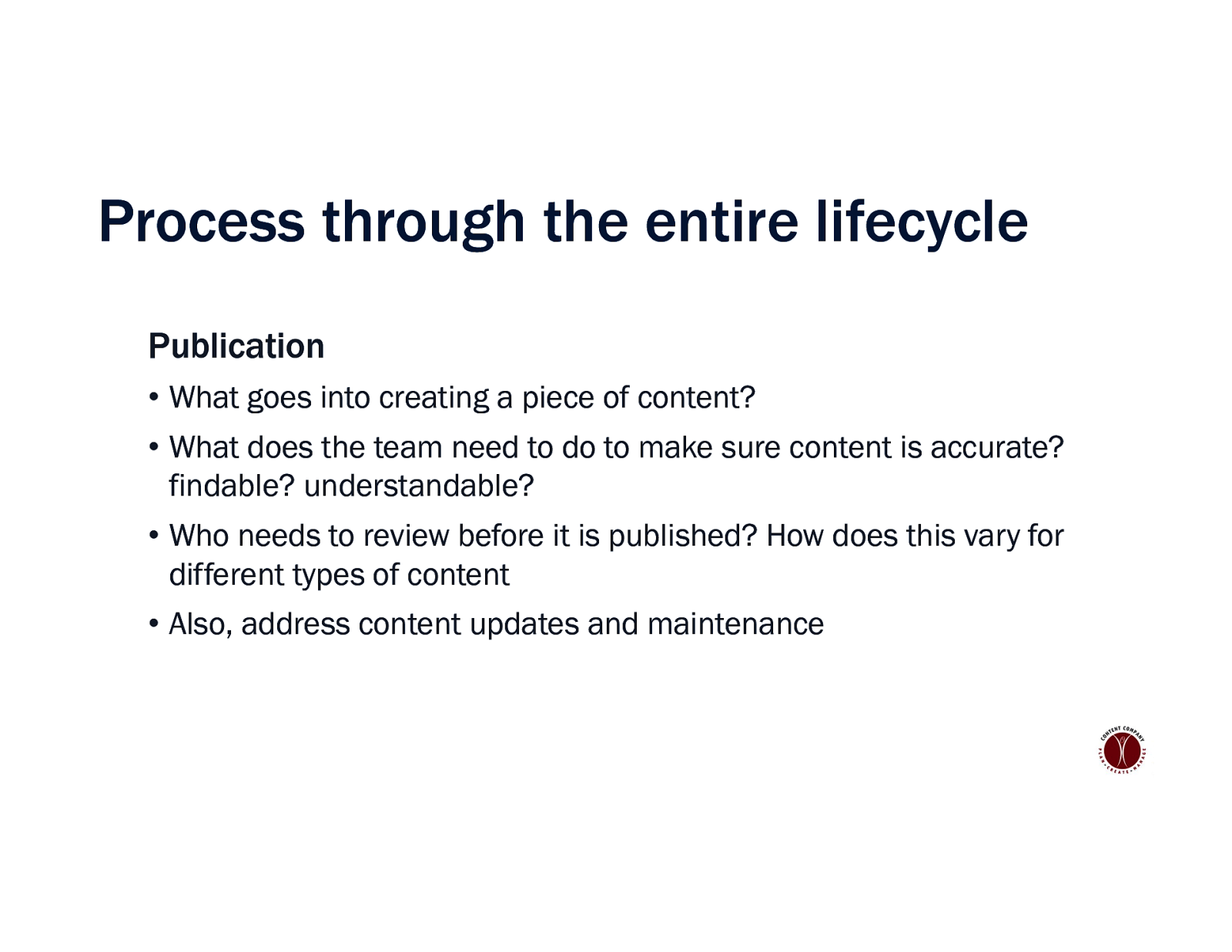
Process through the entire lifecycle Publication • What goes into creating a piece of content? • What does the team need to do to make sure content is accurate? findable? understandable? • Who needs to review before it is published? How does this vary for different types of content • Also, address content updates and maintenance
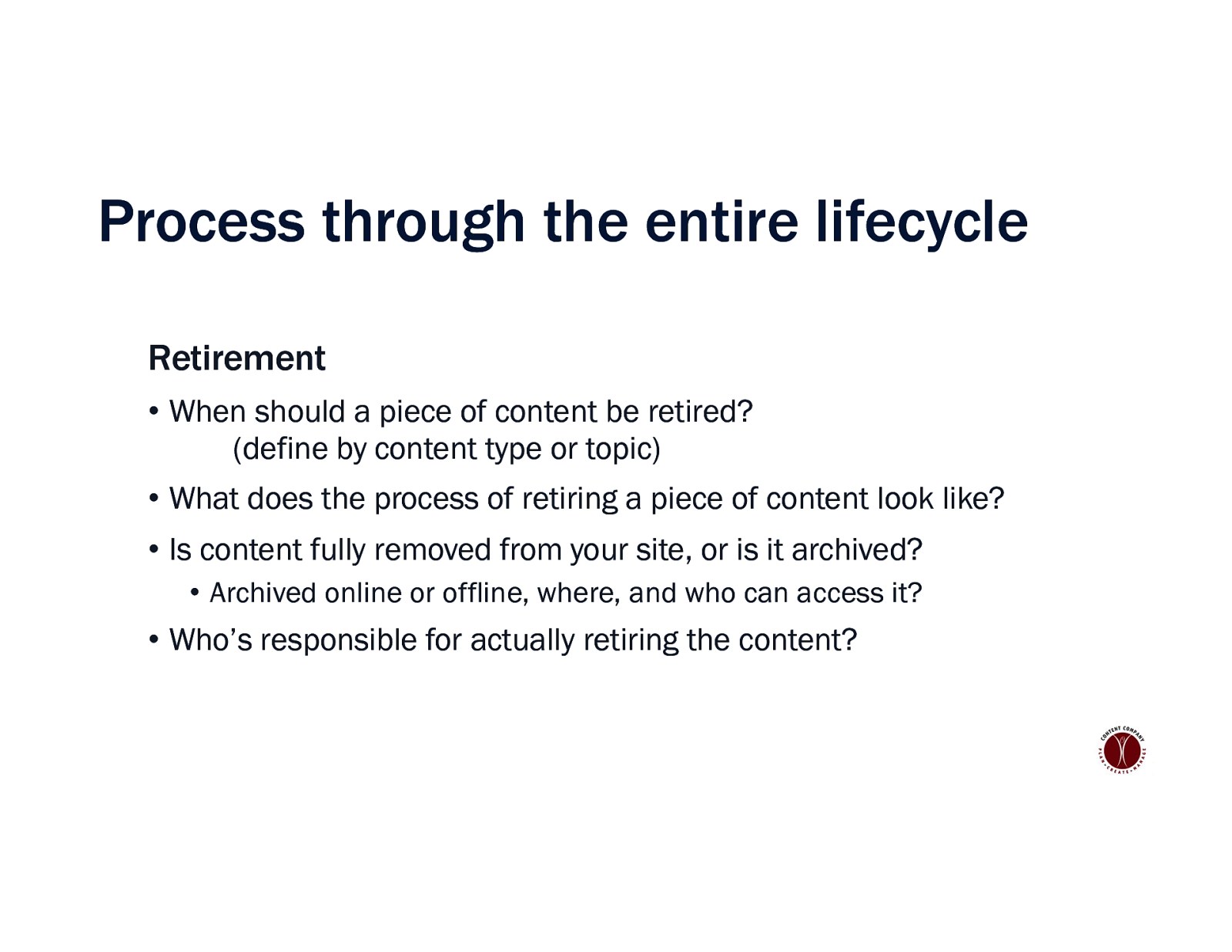
Process through the entire lifecycle Retirement • When should a piece of content be retired? (define by content type or topic) • What does the process of retiring a piece of content look like? • Is content fully removed from your site, or is it archived? • Archived online or offline, where, and who can access it? • Who’s responsible for actually retiring the content?
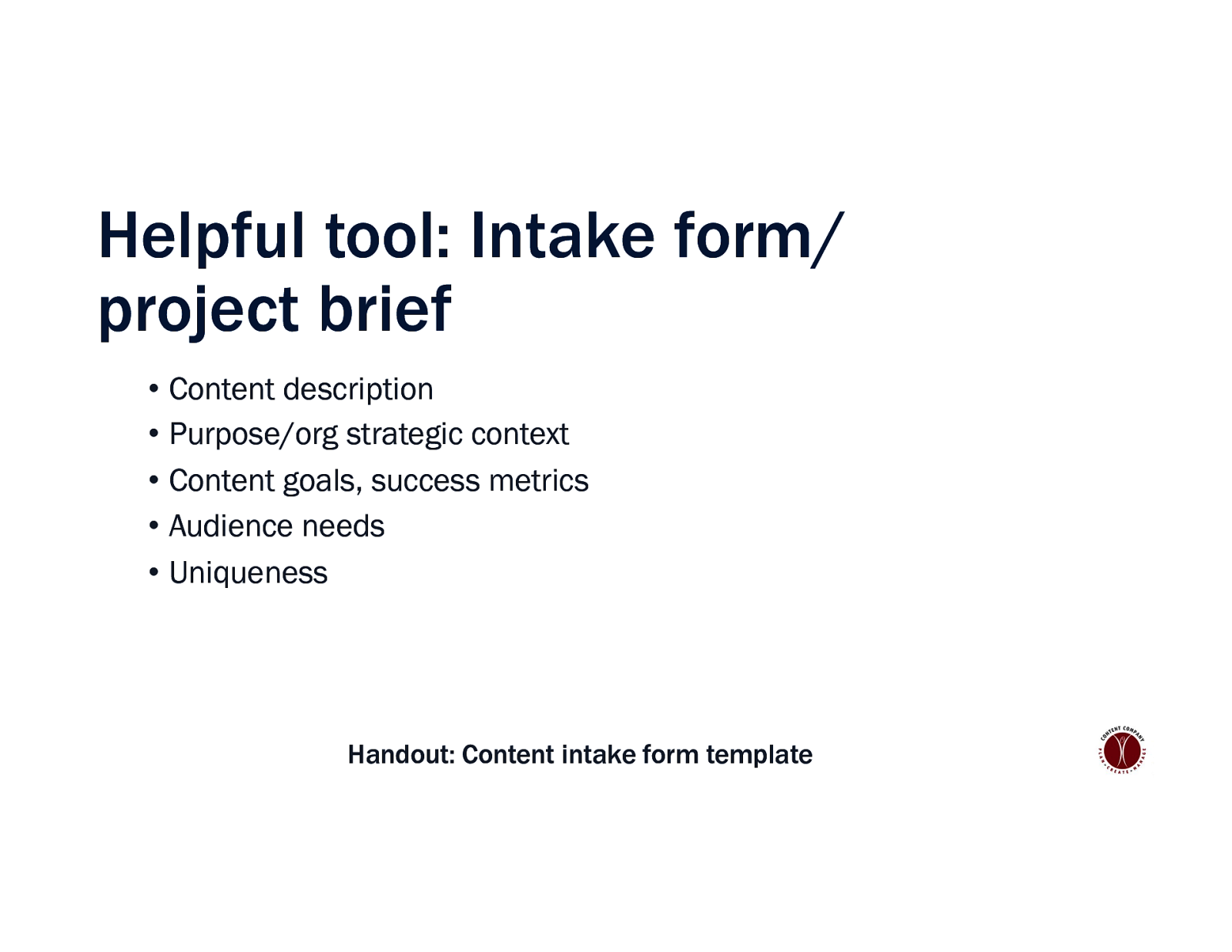
Helpful tool: Intake form/ project brief • Content description • Purpose/org strategic context • Content goals, success metrics • Audience needs • Uniqueness Handout: Content intake form template
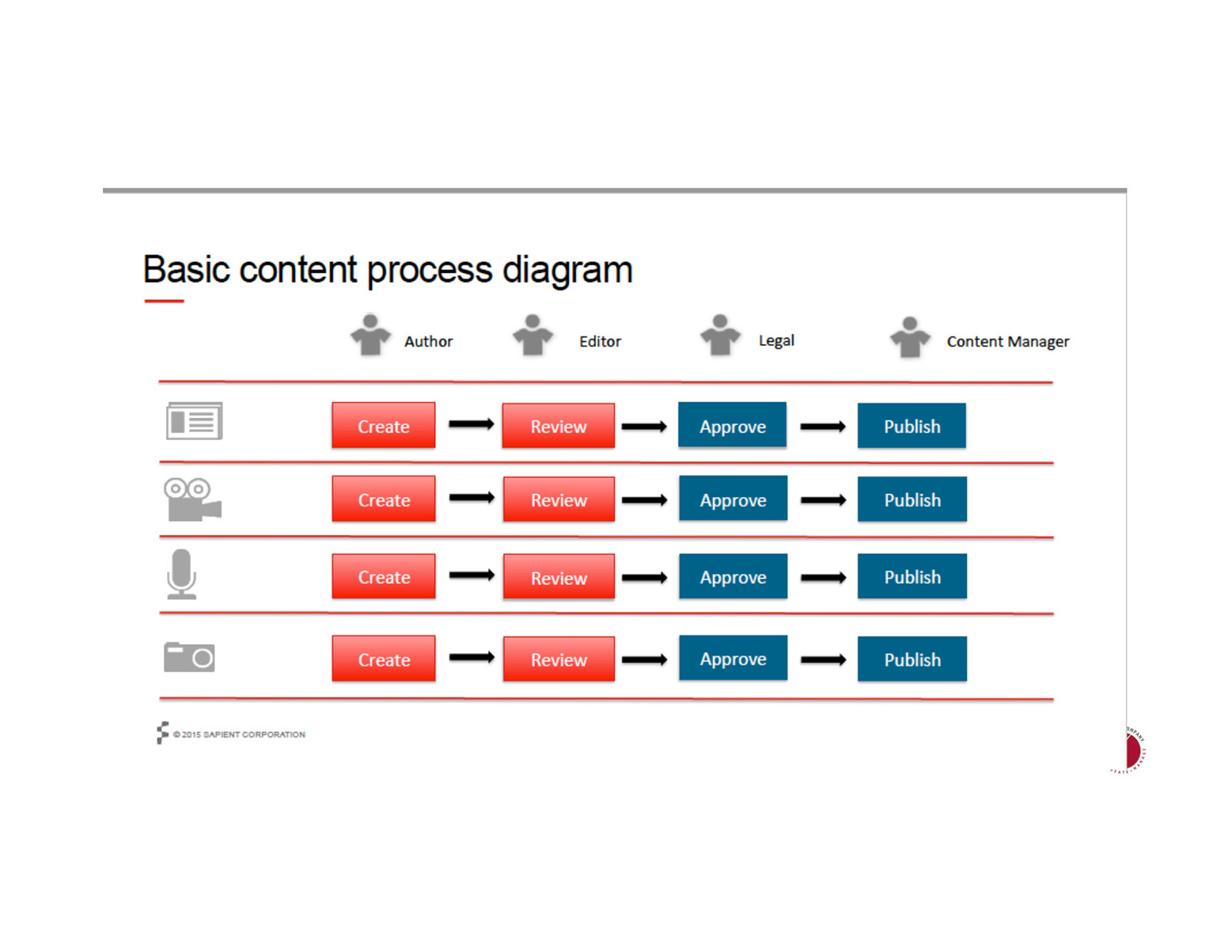
53
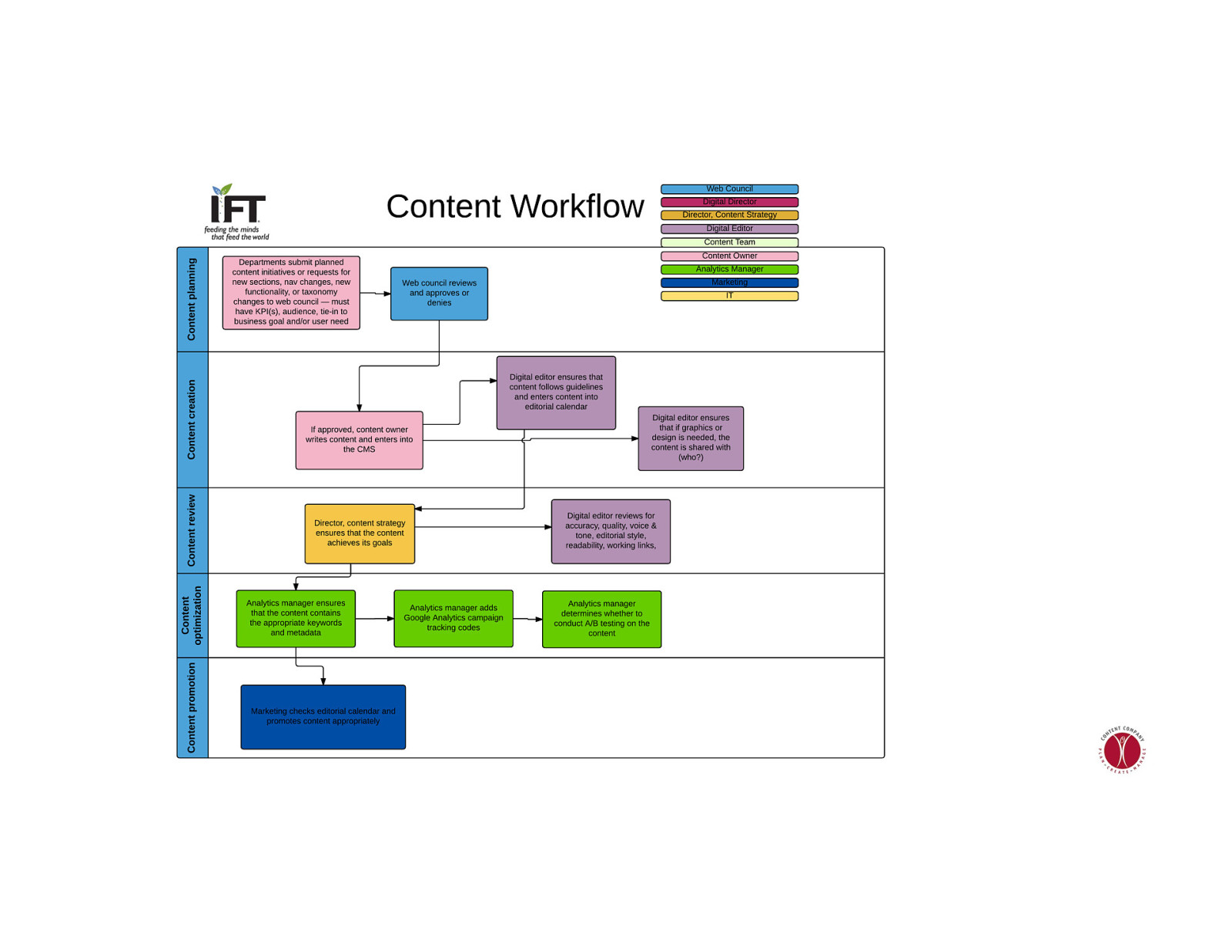
54
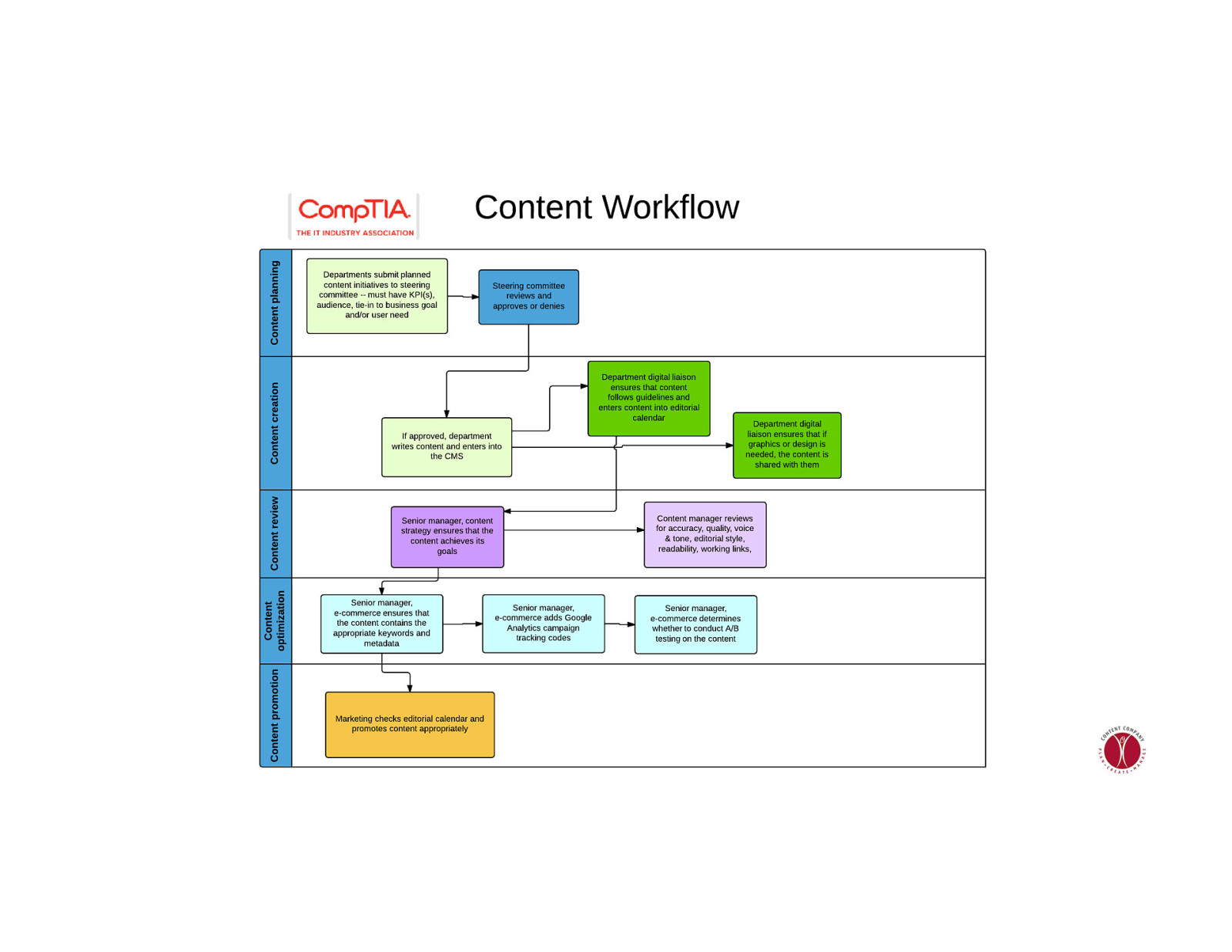
55
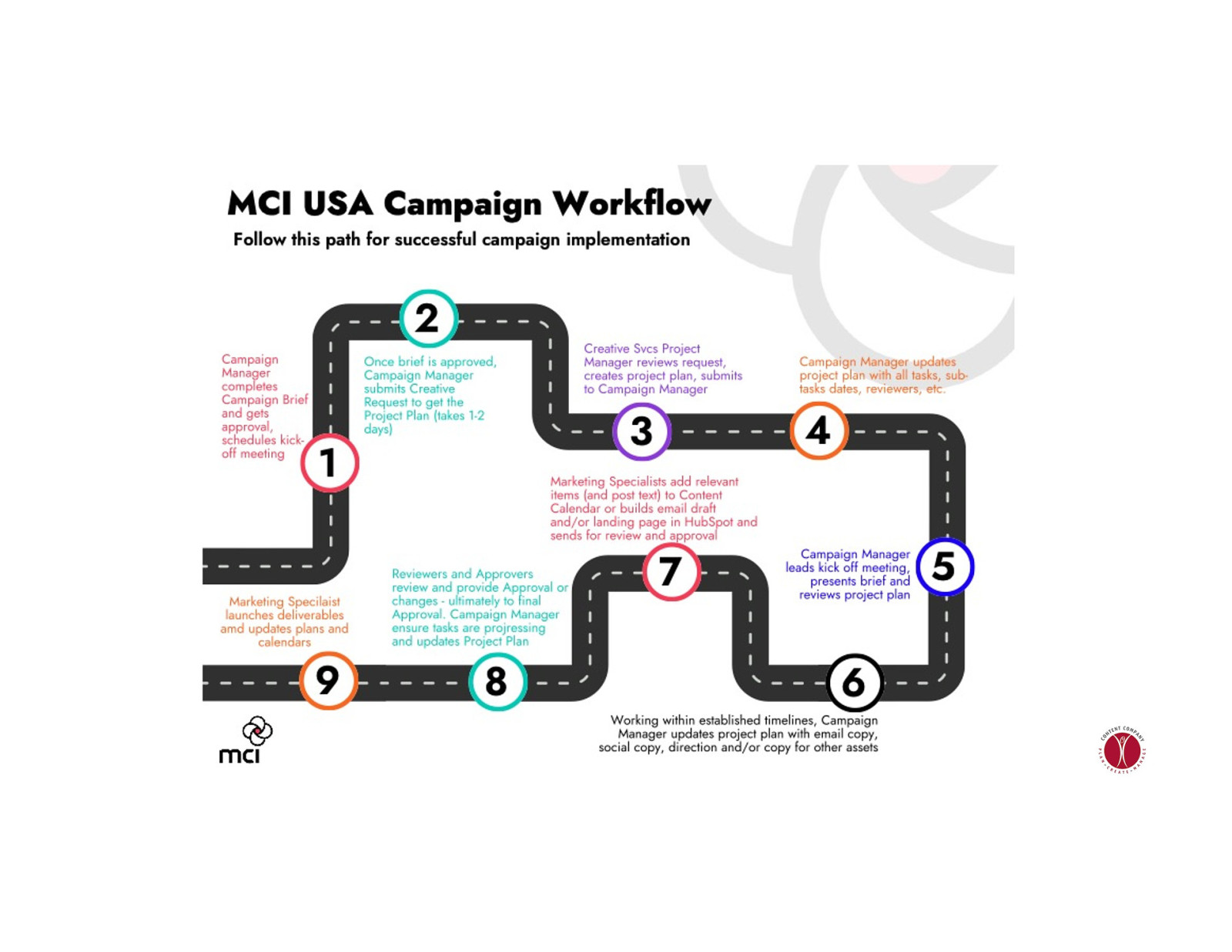
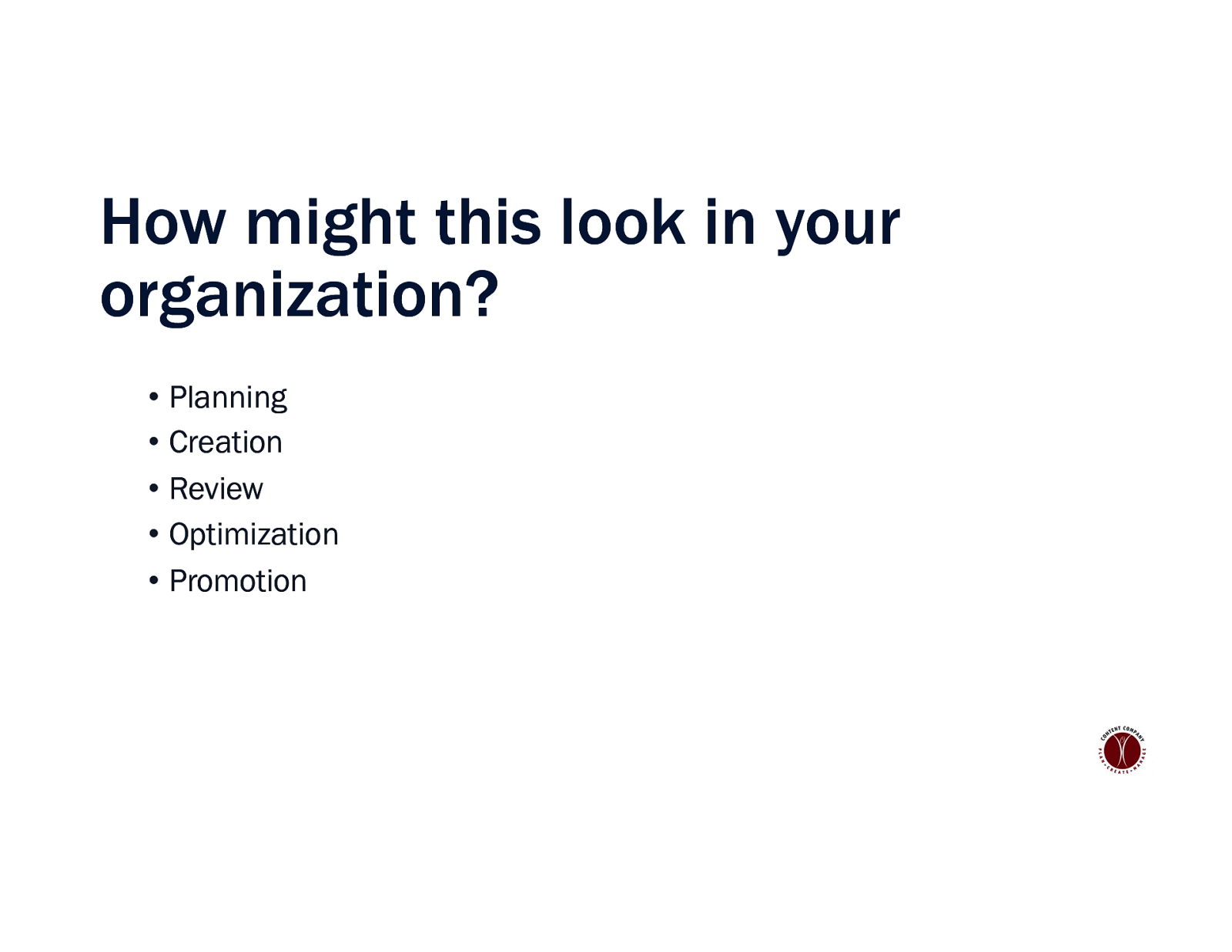
How might this look in your organization? • Planning • Creation • Review • Optimization • Promotion
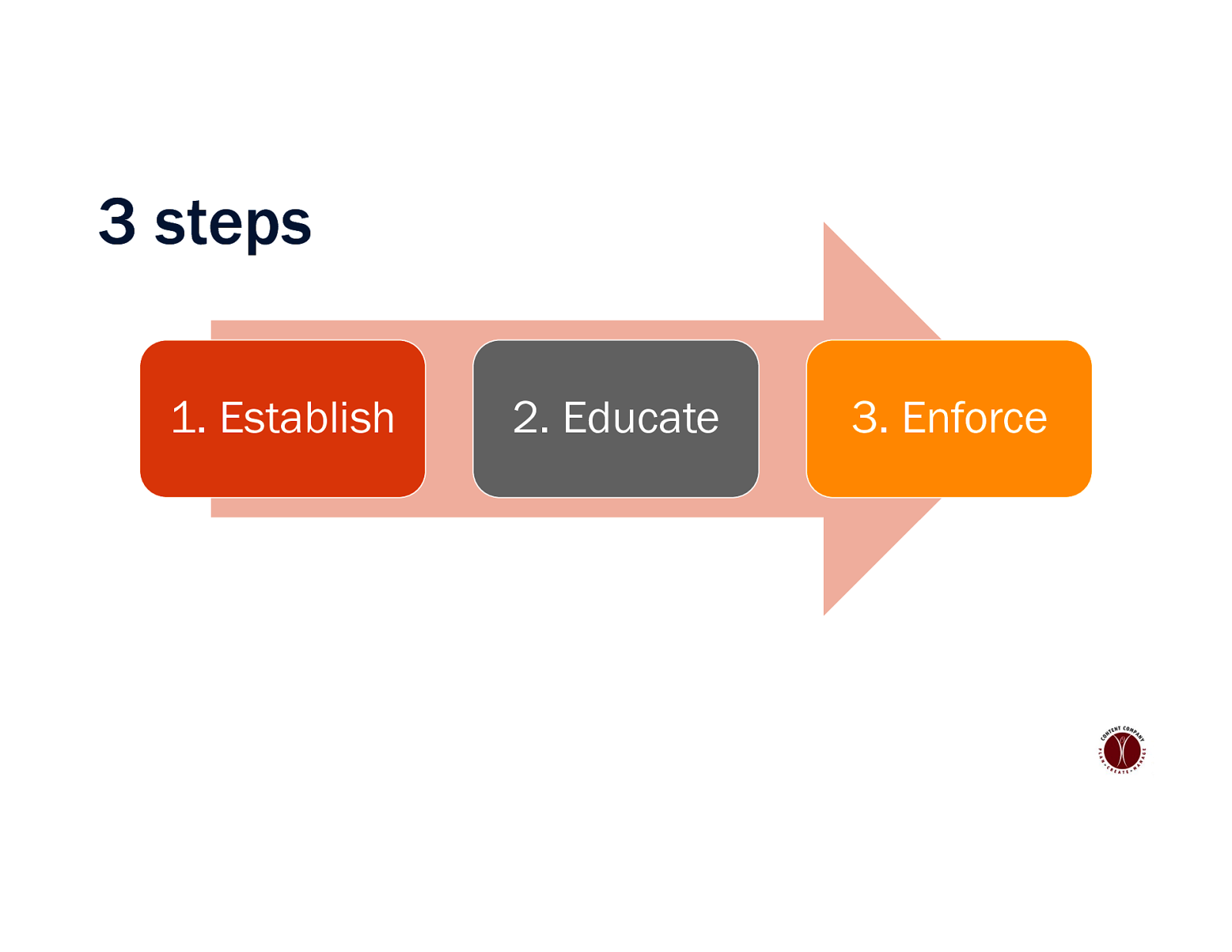
5 8 3 steps 1. Establish 2. Educate 3. Enforce
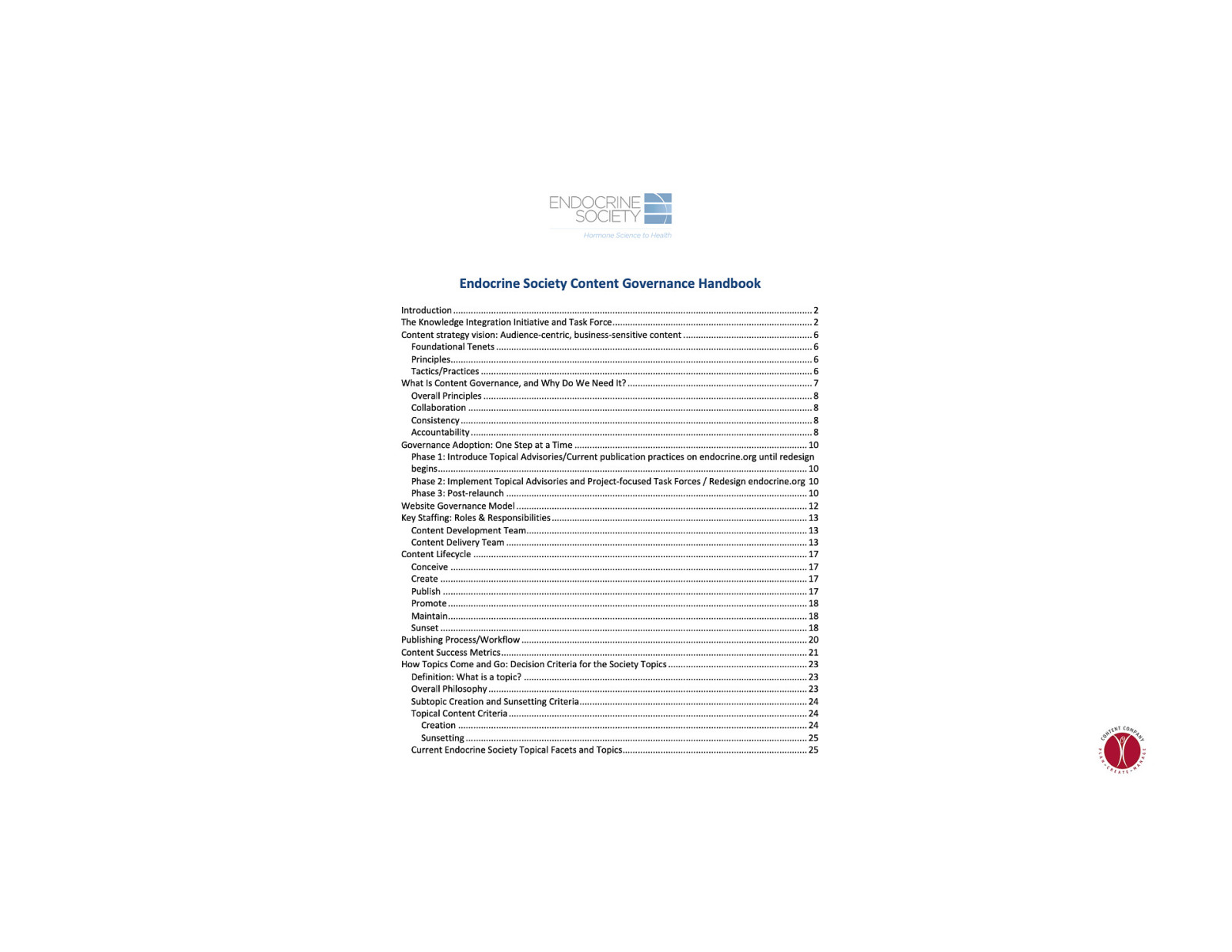
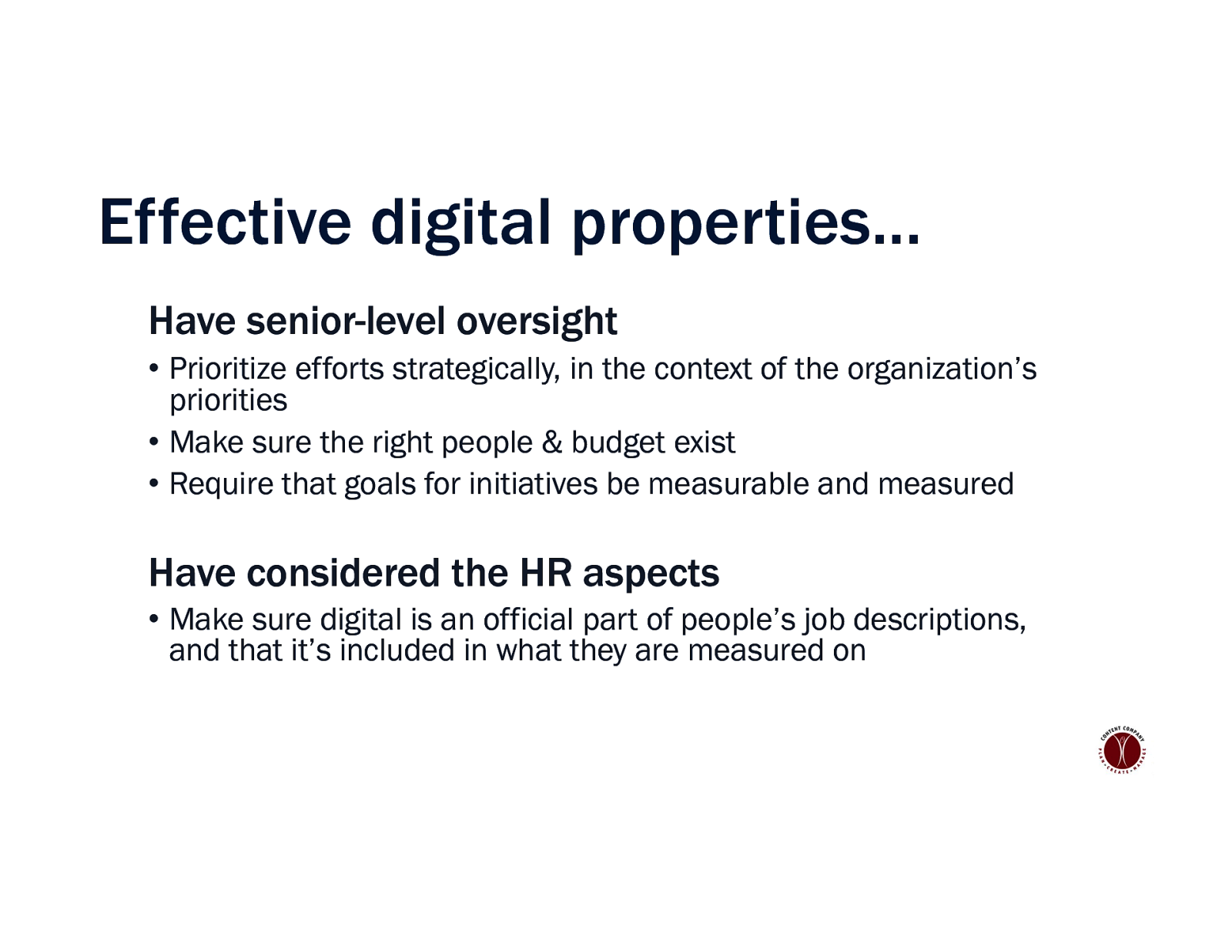
Effective digital properties… Have senior-level oversight • Prioritize efforts strategically, in the context of the organization’s priorities • Make sure the right people & budget exist • Require that goals for initiatives be measurable and measured Have considered the HR aspects • Make sure digital is an official part of people’s job descriptions, and that it’s included in what they are measured on
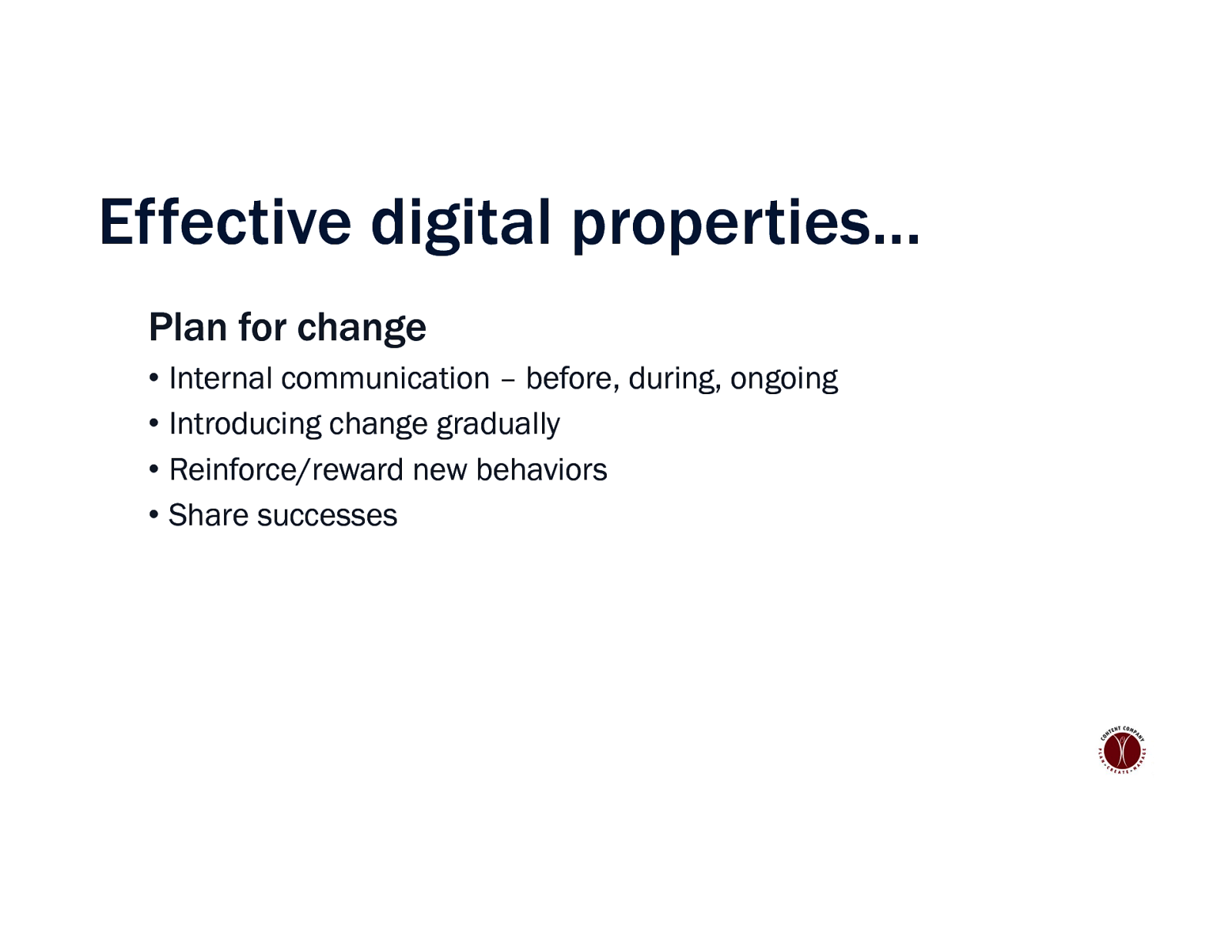
Effective digital properties… Plan for change • Internal communication – before, during, ongoing • Introducing change gradually • Reinforce/reward new behaviors • Share successes

Working together for audience satisfaction
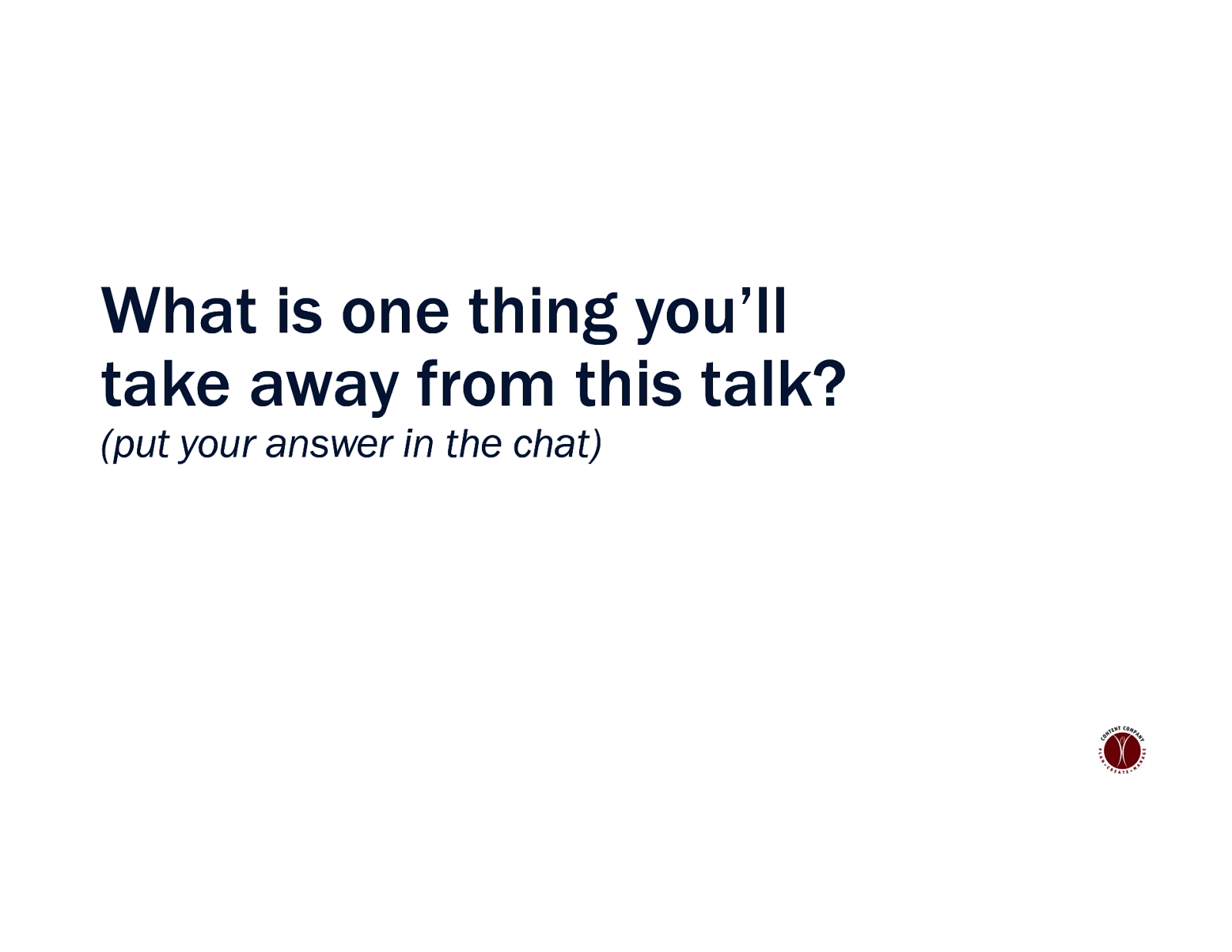
What is one thing you’ll take away from this talk? (put your answer in the chat)
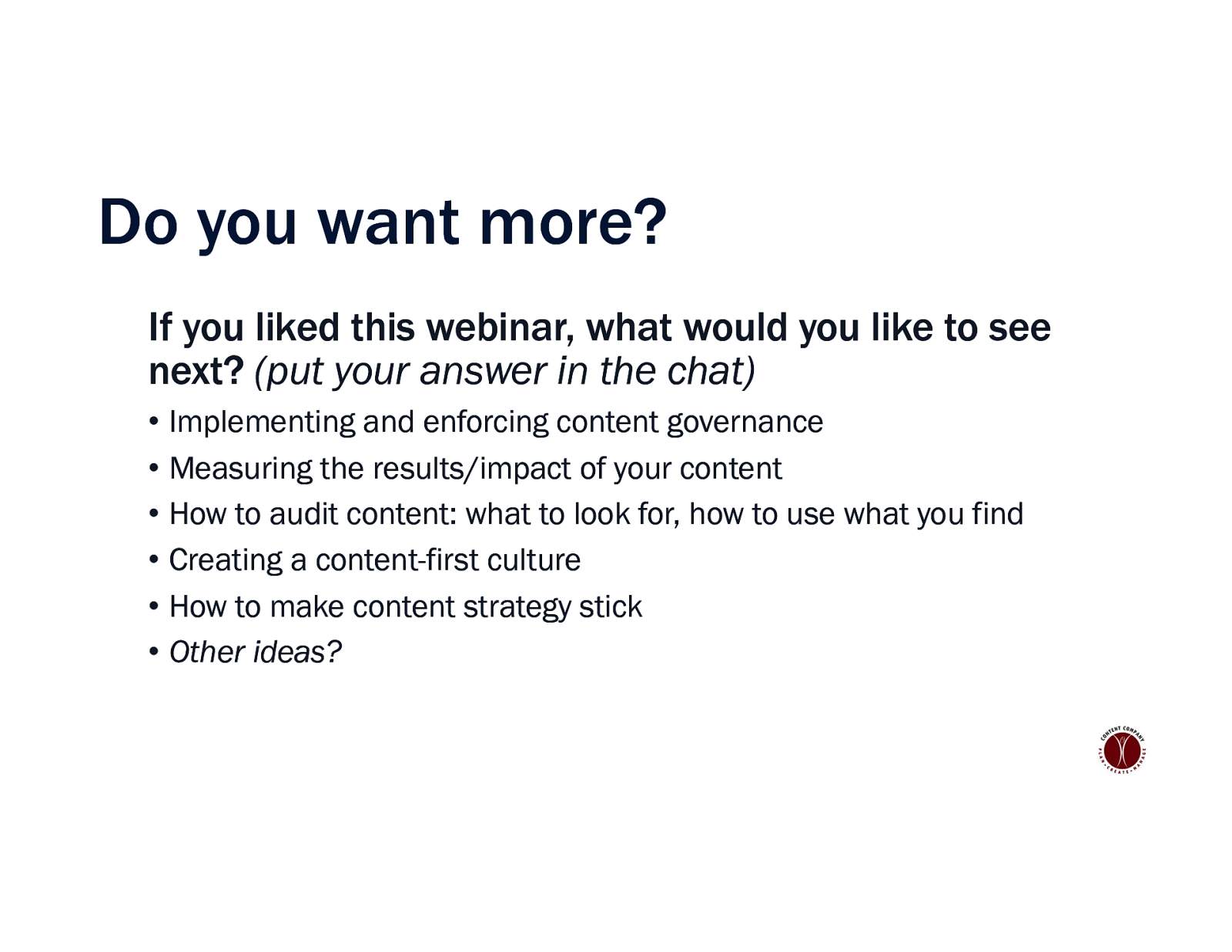
Do you want more? If you liked this webinar, what would you like to see next? (put your answer in the chat) • Implementing and enforcing content governance • Measuring the results/impact of your content • How to audit content: what to look for, how to use what you find • Creating a content-first culture • How to make content strategy stick • Other ideas?
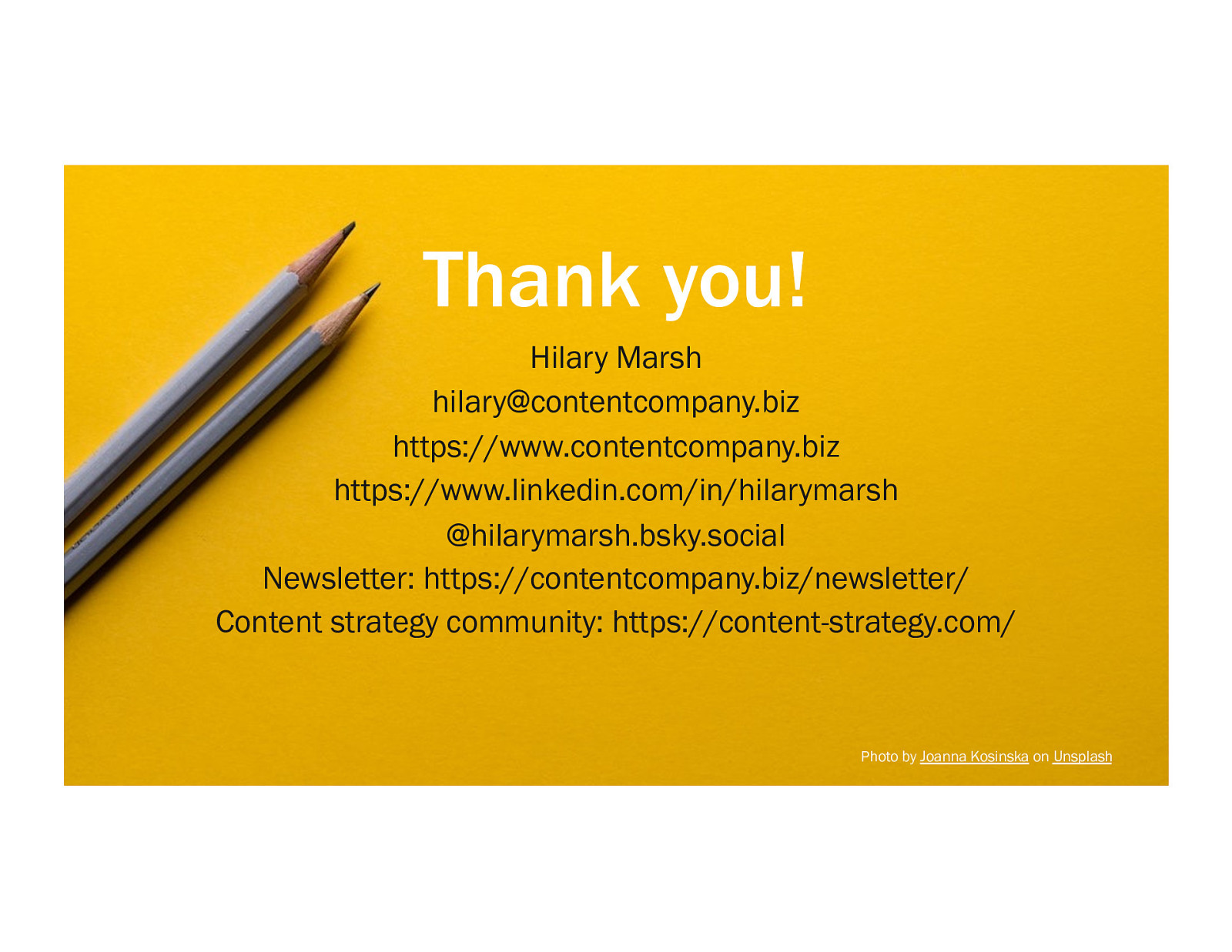
Thank you! Hilary Marsh hilary@contentcompany.biz https://www.contentcompany.biz https://www.linkedin.com/in/hilarymarsh @hilarymarsh.bsky.social Newsletter: https://contentcompany.biz/newsletter/ Content strategy community: https://content-strategy.com/ Photo by Joanna Kosinska on Unsplash